



Introduction
Marc Garrett, curator of the current incarnation of the Children of Prometheus exhibition at the NeMe gallery, interviews artist Joana Moll about the artwork, The Virtual Watchers, developed in collaboration with french anthropologist Cédric Parizot.
This project began in 2010, and looks critically at an online platform group, consisting of 203,633 volunteers surveilling the US-Mexico border, through a social media platform, such as Facebook. The community of The Virtual Watchers existed well before, and briefly, during, President Donald Trump’s signature promise in 2016 to build a wall at the US southern border, to stop more migrants crossing over onto US soil. The project also touches upon the wider online culture of attacks by bots and trolls from clandestine right-wing groups. The interview also explores Joana Moll’s interpretation of the Children of Prometheus exhibition, and briefly discusses other projects such as CO2GLE, which is an attempt to visualize how much carbon dioxide the company is emitting per second.
Interview
Marc Garrett: I remember when I first came across The Virtual Watchers, it left a deeply, unnerving impression on me. It reminded me of how threatening people can be towards others through the Internet. The project illustrates how participatory platforms which have come about, due to the rise of Web 2.0 culture; has not only paved the way for positive forms of mass communications for small groups and individuals to connect with each other, and with families and friends, but, there is also a darker side that people around the world have only in the last few years become aware of.
Out of the many scenarios you have witnessed when studying this virtual surveillance group, what has grabbed your attention the most, or feels most significant to you?
Joana Moll: The platform that gathered this group of people was specifically created to crowdsource national security by allowing citizens to monitor and report illegal activity in the us/mexico border. Ultimately the project shows how citizens can easily, and silently, be militarized by means of free labour, by translating a physical territory into social media, in this case, a border. Personally, what surprised me the most was the fact that most of the users we investigated, were either retired, unemployed or sick and couldn’t leave home.
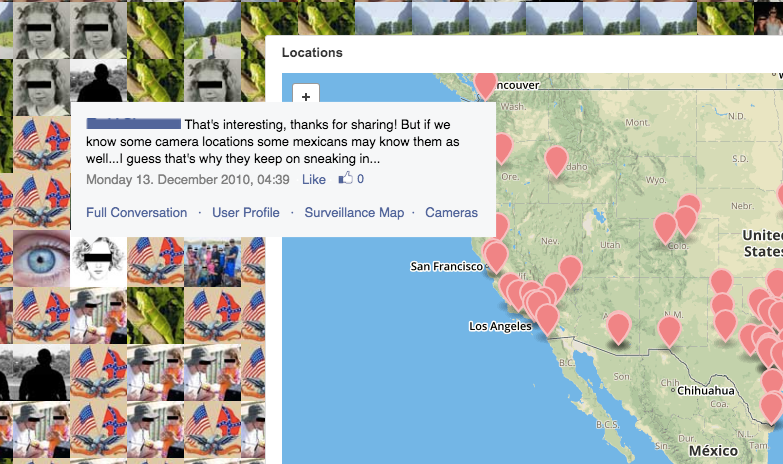
The platform was a stage which allowed them to socialize and feel useful. A couple of users even claimed that the platform saved their lives, that their days became meaningful again. This use of the platform also revealed something important: according to the authorities, and this was that it was quite ineffective when it came to stop illegal activity around the border. Actually, some Sheriffs claimed that the amount of reports that they received on a daily basis were useless and difficult to process. However, the platform worked quite well in terms of keeping a large number of users monitoring the border. It had more than 200.000 registered users which spent more than 1 million hours securing the border for free.
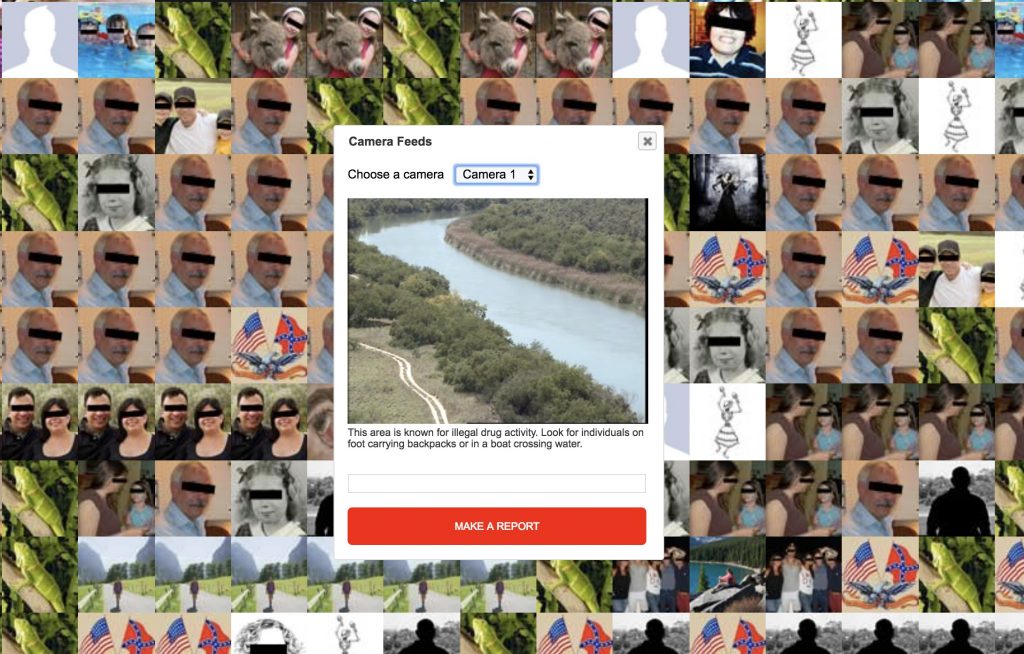
Marc Garrett: This project and or artwork, has been around for nine years now. Yet, its subject matter was ahead of its time, and looking at it now it feels even more relevant. For example, across the world, the general public is only now coming to terms with the political and social, aspects and consequences behind the varied forms of virtual surveillance, dominating online interaction.
This is also true in regard to climate collapse, which brings me to your essay Deep Carbon (2018 ), where you say, the “amount of users and network connections has increased at a whooping pace ever since. In 2015, the Internet registered 966 Exabytes of IP traffic (1.037.234.601.984 GB) and is expected to reach 1579,2 Exabytes by 20182.”
And, then you say, “despite the growing number of Internet users and information flows, the material representation of the Internet and surveillance economy behind it remains blurred in the social imagination.”
What do you think will help to resolve the difficult issue in respect of material representation, in your terms?
Joana Moll: This is quite a difficult question to answer, indeed! I think there has to be a radical change in the way we produce and consume data, but most importantly, in the way our interfaces and interactions are designed. Even though our internet ecosystem is expansive we only interact with it through interfaces, and I really believe interfaces hold the key to start solving the problem. The energy consumption of most of our interactions in the digital realm are very opaque, we have no idea about all the processes that are taking place beyond the interface (i.e. a website, an app) and where all our data is going. I’m about to launch a project called The Hidden Life of an Amazon User which tries to bring to light all the amount of processes that are triggered by doing a simple purchase in Amazon. The amount of information that is involuntarily being loaded in the user’s browser is massive, let alone its energy consumption and environmental impact.
Since 2015, within the Critical Interface Politics group I founded at HANGAR (Barcelona), we’ve been developing experimental workshops that focus on developing sustainable interfaces. We usually work with a limited energy budget, which means that the interfaces we design can just use a certain amount of energy. It is really amazing how this seemingly small shift radically changes the way we think and design online interactions. If this would be a standard process when it comes to design our online experiences (which it should), would possibly have tremendous collateral positive consequences for the entire internet ecosystem, specially in terms of preventing to collect massive amounts of user data, which consume vast amount of resources. In this sense sustainable websites would be privacy friendly 😉
Marc Garrett: In what way do you think your own work fits into the context of the exhibition?
Joana Moll: It’s always hard to talk about my own work beyond my own work, but I’ll do my best! I feel my work tries to reveal very complex and hard to grasp techno-social arrangements in a very simple way. To allow people to understand the infrastructures and processes that govern their day to day lives without feeling smashed about their complexities it’s a central concern in my practice. I think my work fits in the exhibition in many ways, but I believe that this need to urgently discuss critical implications of our technologies with broader communities is one of the most relevant.
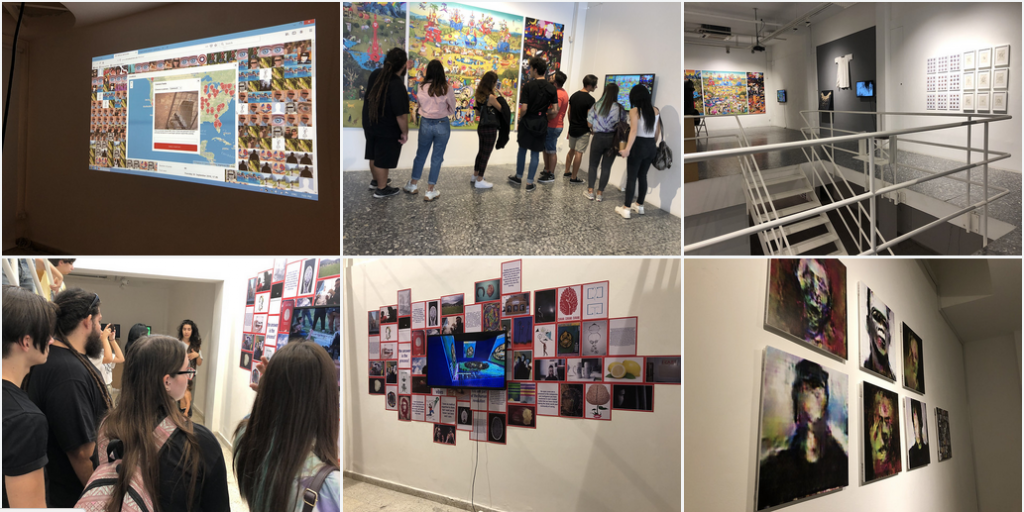
Marc Garrett: The postmodernist, feminist and theorist, Donna Haraway has recently re-emphasized the importance of re-evaluating certain contemporary contexts, especially those involving the patriarchy, politics, and climate change, in the age of the Anthropocene. I consider yourself, and myself, have been exploring our practices in parallel to Haraway’s critical ambitions, in respect that, we share similar values, but express them differently.
Thus, we need to re-examine our relationship with the world in the midst of spiraling ecological devastation, and find new ways to reconfigure our approach and connection to the earth and all its inhabitants.
Could you give us an example of your current works that you feel could be materializing Haraway’s writings, but as part of your own artistic production and or intention, and what the links and differences are?
Joana Moll: I agree, our work involves many of Haraway’s concerns, indeed. As for my practice, I believe politics, patriarchy, climate change and technology are continuously meeting and being questioned, in the sense that I always approach this contexts from different angles, which also talks a lot about my own process of understanding complex contemporary arrangements and how they affect and modify each other. For example, in my latest projects: The Dating Brokers and The Hidden Life of an Amazon User (HLAU), I examine how user activity, or in other words free labour, is heavily monetized by third parties. However in HLAU I also examine the energy costs that such exploitation is involuntarily assumed by the user. Graham Harman said it is very important no to assume that everything is connected, but to continuously trace the connections between things, which is something that I try to remember when I do a new project and I believe that Haraway’s body of work heavily points in that direction. However, I believe that techno-colonialism is a central issue to tackle while re-evaluating technology, politics, environment and most importantly, the way it affects and informs our ability to think and imagine. Together with my colleague Jara Rocha we’ve been recently collaborating in a series of projects and workshops that aim to reveal tangible outcomes of techno-colonialism in our daily lives.
Marc Garrett: The Children of Prometheus exhibition was mainly inspired by Mary Shelley. What elements in the exhibition’s: themes, ideas, and contexts, do you relate to personally?
Joana Moll: I relate to all of them, they are all so relevant and urgent! As for my work, I especially connect with the way invisible processes triggered by human-centered technologies affect our natural habitats. I believe that the exhibition opens highly relevant and urgent discussions about how society has been “Frankensteined” at large. The way our technologies are designed, produced and used are seriously damaging not just our life-giving habitats but also our relationship to them, our ability to imagine habitable ways to inhabit this planet.
Conclusion
When I first began the Children of Prometheus exhibition project, it was called Monsters of the Machine: Frankenstein in the 21s Century. Both titles fit the same curation function, and that is, to examine critically with other the artists in this touring show, Mary Shelley’s questions, that were asked in 1818, today, looking through her eyes.
I can’t imagine what she would think of Trump and all the other extreme right-wing, racist, groups and politicians, and dodgy corporations, exploiting people’s data, whilst adding to the destruction of the planet. However, in the spirit of Shelley, we have individuals such as Joana Moll who can play that role, with other artists doing what Shelley did so well then, but today. Our world is dying and those in power are part of non-friendly systems designed to kill it further, while the poor and oppressed take the brunt of it all. Moll, and the other Artists the exhibition, are presenting us with serious questions. But, accompanying these necessary and urgent concerns, are also answers at the same time. But there’s not much time.
Joana Moll is part of the touring exhibition, Children of Prometheus currently at the NeMe Arts Centre, Limassol, Cyprus 11 Oct – 20 Dec, 2019. This exhibition was originally produced in partnership with LABoral, in Gijon, and is an extension of the Monsters of the Machine: Frankenstein in the 21st Century, 18 Nov 2016 – 21 May 2017. We are currently negotiating other venues, in different countries across the world. Please contact if you’re interested in the exhibition.
Joana Moll will also be leading a workshop, THE INTERFACE, DECONSTRUCTED, and participating in a conversation with Tatiana Bazzichelli, founder of Disruption Network Lab as part of ACTIVATION: Collective Strategies to Expose Injustice, Saturday, 30 November 2019.
Artist Bio
Joana Moll is a Barcelona / Berlin based artist and researcher. Her work critically explores the way post-capitalist narratives affect the alphabetization of machines, humans and ecosystems. Her main research topics include Internet materiality, surveillance, social profiling and interfaces. She has lectured, performed and exhibited her work in different museums, art centers, universities, festivals and publications around the world. Furthermore she is the co-founder of the Critical Interface Politics Research Group at HANGAR [Barcelona] and co-founder of The Institute for the Advancement of Popular Automatisms. She is currently a visiting lecturer at Universität Potsdam and Escola Superior d’Art de Vic [Barcelona].
We are delighted to share with you our Spring season of art and blockchain essays, interviews and events, offering a wide spread of exploration and critique.
The blockchain is an evocative concept, but progress in ideas of cryptographic decentralisation didn’t stop in 2008. It’s helpful for artists to get a sense of the plasticity of new technical media. So first we are pleased to share with you Blockchain Geometries a guide by Rhea Myers to the proliferation of blockchain forms, ideas and their practical and imaginative implications.
In Moods of Identification Emily Rosamond writes her response to our second DAOWO workshop, Identity Trouble (on the blockchain). She reflects on both ongoing attempts to reliably verify identity, and continuing counter-efforts to evade such verifications.
Mat Dryhurst and Holly Herndon speak here with Marc Garrett in an interview republished from our book with Torque Editions Artists Re:Thinking the Blockchain (2017). Mat and Holly convey a sense of excitement about developments and opportunities for new forms of decentralised collaboration in music.
Finally you can book your place on future events at the DAOWO blockchain laboratory and debate series for reinventing the arts.[note] DAOWO is inspired by a paper written by artist, hacker and writer Rhea Myers called DAOWO – Decentralised Autonomous Organisation With Others.[/note] Download the DAOWO Resource #1 for key learnings, summaries of presentations, quotes, photographs, visualisations, stories and links to videos, audio recordings and much more from our first two events about developments in the arts and the trouble with Identity.
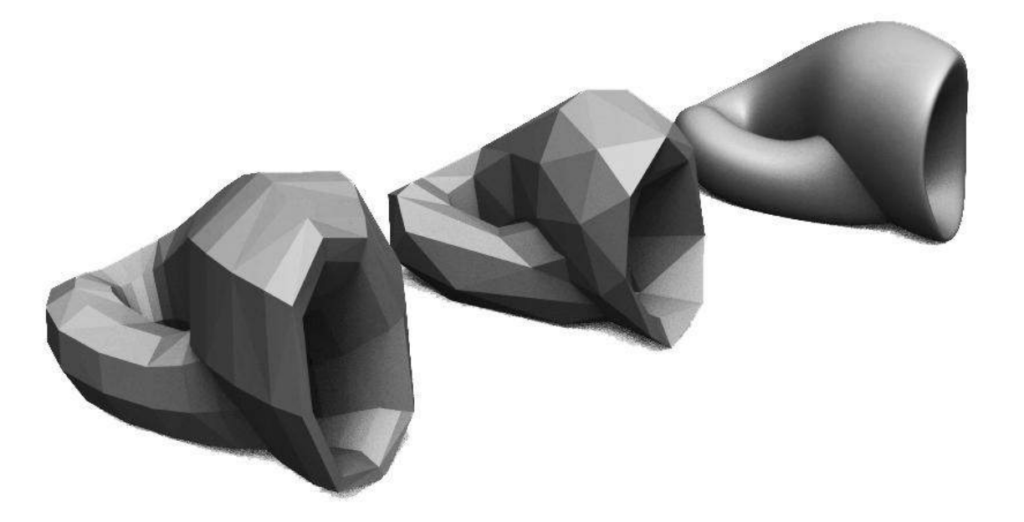
The blockchain is 10 years old and is surrounded with a hype hardly seen since the arrival of the Web. We’d like to see more variety in the imaginaries that underpin blockchains and the backgrounds of the people involved because technologies develop to reflect the values, outlooks and interests of those that build them.
Artists have worked with digital communication infrastructures for as long as they have been in existence, consciously crafting particular social relations with their platforms or artwares. They are also now widely at work in the creation of blockchain-native critical artworks like Clickmine by Sarah Friend[note]The 2017 Furtherfield and NEoN commission as part of the State Machines EU cooperation programme[/note] and Breath (BRH) by Max Dovey, Julian Oliver’s cryptocurrency climate-change artwork, Harvest (see featured image) and 2CE6… by Lars Holdhus[note]Featured as part of Øx, an exhibition of cryptographic artwork curated by Sam Hart as part of the Ethereal Summit, NYC. 2017[/note], to name but a few.
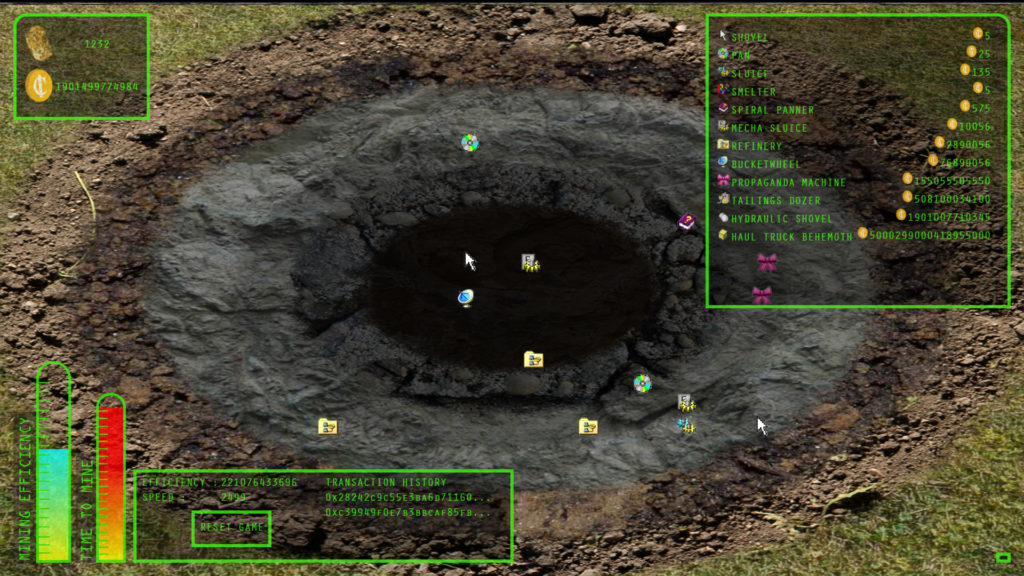
By making connections that need not be either utilitarian nor profitable, artists explore potential for diverse human interest and experience. Also, unlike on blockchains, where time moves inexorably forward (and only forward) – fixing the record of every transaction made by its users, into its time slot, in a steady pulse, one block at a time – human imaginative curiosity can scoot, meander and cycle through time, inventing and testing, intuiting and conjuring, possible scenarios and complex future worlds. They allow us to inhabit, in our imaginations, new paradigms without unleashing actual untested havoc upon our bodies and societies.
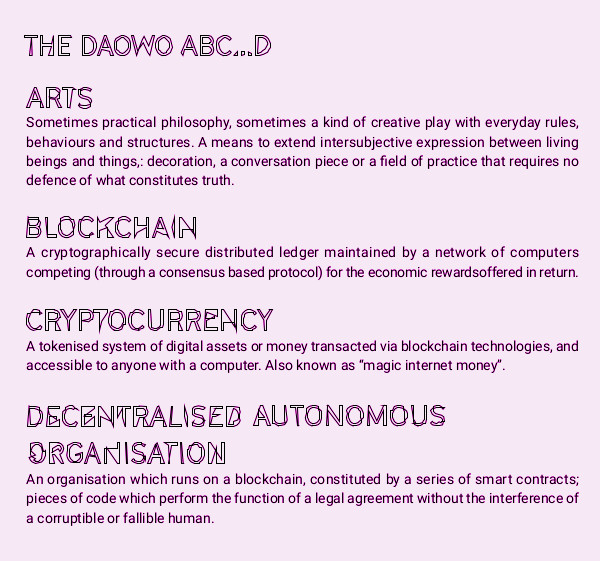
Back in 2008 the global banking system was bailed out by governments with tax payers’ money. Meanwhile a 15 year explosion of web-inspired, decentralised, mutualist-anarchist DIWO (Do It With Others)-style cultural actions and practices ebbed (though its roots remain and go deep). The global network of human attention and resources were, by this time, well and truly re-centralised. The “big five” now owned, and often determined, our communication and expression. Post-Internet artists rejected platform-building as a social artform and instead, took as their materials, lives mediated through social media and corporate owned platforms. Some dived into the marketing vortex, to revel and participate in the heightened commodification of art.
With the introduction of the blockchain protocol on the Internet we see a reversed direction of travel in the artworld, with major developments coming more quickly from the businesses of art, which reassert art’s primary status as an asset class, than from those artists experimenting with new forms of experience and expression enabled by its affordances. Now intermediaries of art world business are moving into blockchains (also sometimes called the “Internet of money”) with a focus on provenance, authentication, digital arts made scarce again with IP tracking, fractional ownership, securitisation and auction[note]See the Blockchain Art Stack Ready Reckoner, DAOWO Resource #1, page 19[/note]. It is blockchains for art, any art, as long as that art can be owned and commodified. This may be seen as a good thing, generating and distributing increased revenues to ‘starving artists’. Also perhaps inevitable, as that which cannot be owned is hard to represent on a blockchain ledger.
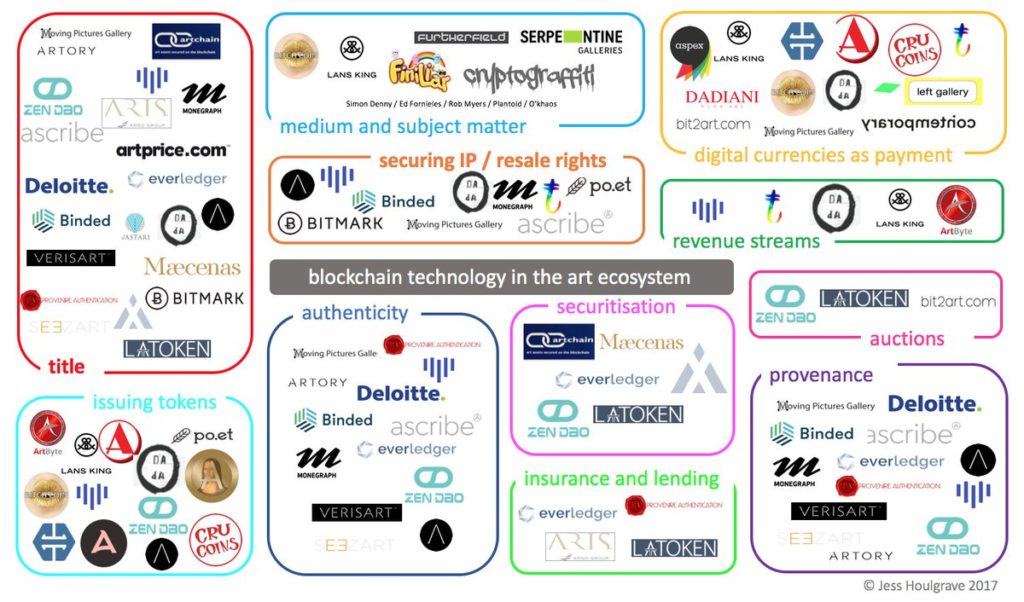
In his new book Reinventing democracy for the digital condition, (2018) Felix Stalder notes that people are increasingly actively (voluntarily and/or compulsorily) participating in the negotiation of social meaning through the “referentiality, communality, and algorithmicity, […] characteristic cultural forms of the digital condition”. In 2015 the Ethereum blockchain launched with a new layer that could run “smart contracts”, pieces of code which act as autonomous agents, performing the function of a legal agreement without the interference of a corruptible or fallible human[note]These technologies now underpin a range of post-currency developments, massive industrial and state investment for authentication of identity and matter, more efficient and secure financial transactions and distribution of digital assets; communications so secure as to facilitate voting; and as a coordinating technology for the billions of devices connected to the Internet.[/note]. These can be combined to perform as blockchain-based companies called Distributed Autonomous Organizations (DAOs) and there are a plethora of blockchain implementations and political agendas now developing. How these unfurl will affect our ability to relate to each other, to deliberate, decide and cooperate with each other as individuals, organisations and societies.
So for us the promise lies in platform-building: by-and-for communities of experimental artists (in the expanded sense of the word), participants and audiences who want to create not just saleable or tradeable art objects[note]For examples like Cryptopunks, Cryptokitties and Rare Pepes read Tokenization and its Discontents by Rhea Myers, Furtherfield 2017[/note] but artworks that critique the relationship between art and money, and expand the contexts in which art is made and valued.
‘AltCoins, cryptotokens, smart contracts and DAOs [Digital Autonomous Organisations] are tools that artists can use to explore new ways of social organisation and artistic production. The ideology and technology of the blockchain and the materials of art history (especially the history of conceptual art) can provide useful resources for mutual experiment and critique’ – Rhea Myers[note](Conceptual) Art, Cryptocurrency and Beyond by Rhea Myers, Furtherfield 2014[/note]
While FairCoin (being rolled out by FairCoop with the Catalan Integral Cooperative) puts new forms of decentralised social organisation into practice on the ground, blockchain based art projects such as Terra0 and Plantoid by O’khaos offer examples of governance systems and invite us to critically “imagine a world in which responsibility for many aspects of life (reproduction, decision-making, organisation, nurture, stewardship) are mechanised and automated.”[note]Both featured in the exhibition NEW WORLD ORDER, currently touring as part of the State Machines programme to Aksioma in Slovenia and Drugo More in Croatia[/note] Both artworks demonstrate functioning systems and help us to think through how we might determine and distribute artistic (and other) resources, their value, and the rules for their co-governance for the kinds of freedoms, commonalities and affiliations that are important for the arts.
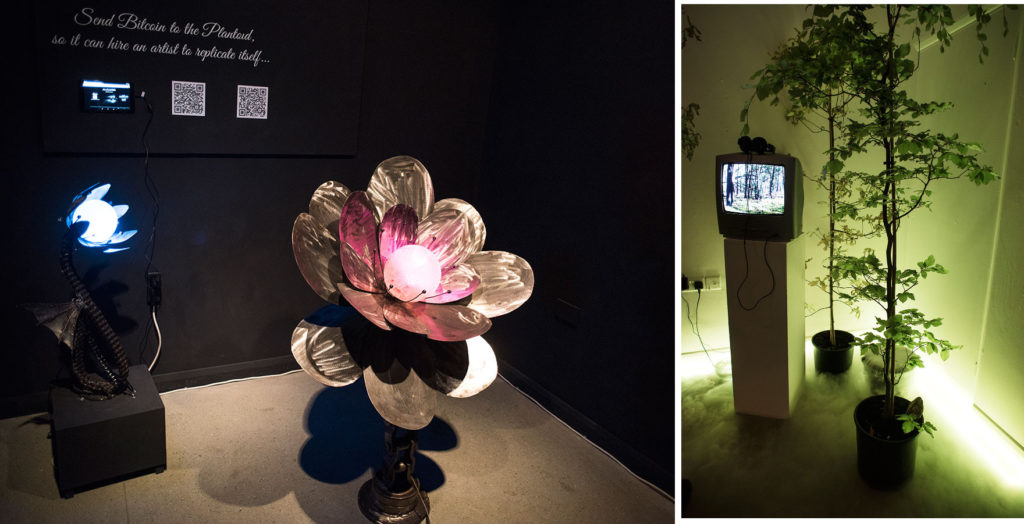
It may take a while. What to value and how to value it is a particularly tangled question. The technical infrastructure of the blockchain is at the stage of development that the Web was at in the early 90s (blockchain technologies are less forgiving, require deeper programming knowledge and are therefore more expensive to build than web pages or platforms) which, along with the get-rich-quick vibe of non-community-platform projects, might be why there are still so few community platforms actually in operation. Resonate.is the cooperatively owned music streaming service is an inspiration in this regard. It is a platform for musicians – creators and listeners – that opens up the governance of its resources to everyone who has ever created or listened to its music. It demonstrates one way in which a DIWO ethos might work.
Helen Kaplinsky is exploring how to bootstrap to the blockchain, Maurice Carlin’s Temporary Custodians project which realises an alternative system of peer2peer art ownership and stewardship at Islington Mill[note]See An Alternative to a Historical Mode of Art Ownership, Helen Kaplinsky in DAOWO Resource #1, page 6, Furtherfield, 2018[/note].
Three preoccupations dominate 2018 New Year blogs and commentary that mark the blockchain’s 10th anniversary: blockchains as cash cults; doubts about the actual utility of blockchains and; the environmental impact of Bitcoin (still, erroneously interchangeable with the blockchain in the minds of lots of people). We add to these our concern about the intensification of control enabled by these infrastructures, AND the simultaneous conviction (shaped by deep collaborations and hard criticisms over the last years) that blockchains have the potential to enable and stimulate new forms of social organisation, resource distribution and collaboration in the arts.
The first two preoccupations match exactly the commentary surrounding the early days of the Web and we know how that turned out. The remaining concerns are grist to the mill of our ongoing programme of publications, films, exhibitions and events. The technologies are only now stabilising to allow more grass-roots infrastructural developments.
We invite you to bring your own lens of constructive critique, gather a crowd to debate and explore how we might pull blockchains into art, on the arts’ own terms, and to gain an understanding of why it is worthwhile.
If you’re interested in Furtherfields critical art and blockchain programmes with various individuals, groups and partners since 2015. You could check out how it all started, watch our short film, read this book, visit this exhibition, or archives and documents of previous exhibitions[note]The Human Face of Cryptoeconomies[/note], [note]New World Order[/note], read reviews and debate, and join us at our ongoing DAOWO blockchain lab series, devised with Ben Vickers (Serpentine Galleries) in collaboration with the Goethe-Institut London, and the State Machines programme[note] Its title is inspired by a paper written by artist, hacker and writer Rhea Myers called DAOWO – Decentralised Autonomous Organisation With Others.[/note]
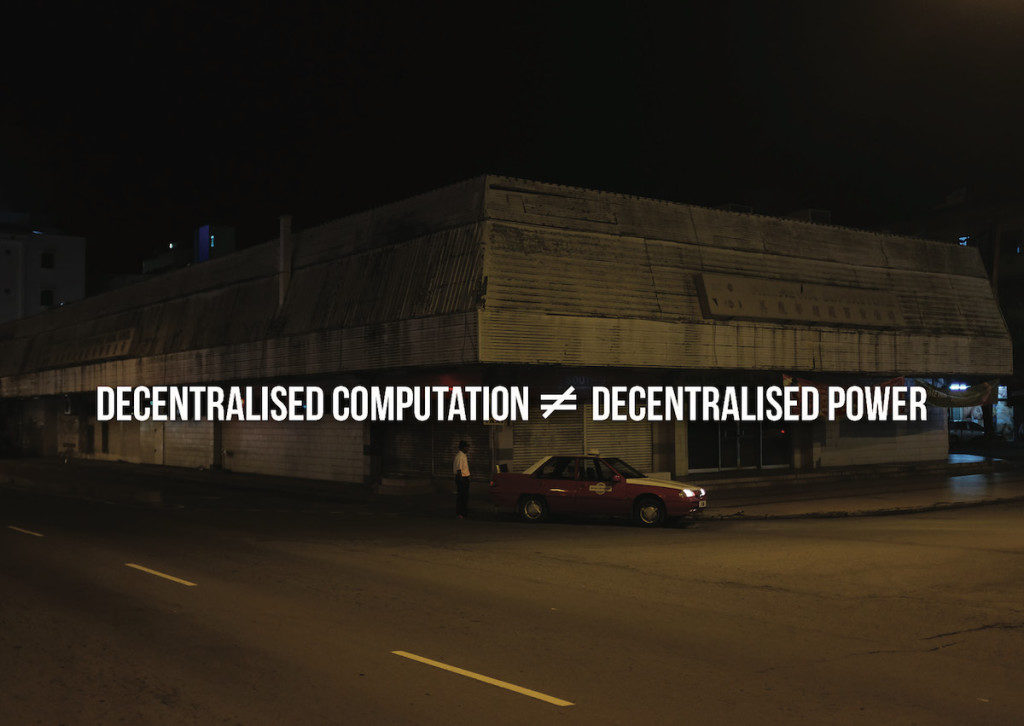
Alan Sondheim has been ploughing a very singular furrow through art, music, writing, philosophy and much else since the late sixties. On the occasion of his participation in the Children of Prometheus exhibition at Furtherfield Gallery we present here an interview conducted by the artist and writer Michael Szpakowski in which Sondheim gives a broad overview of his artistic formation, practice and philosophy.
Michael Szpakowski: I first came across your work through the Webartery mailing list in 2001. I remember being knocked out by your productivity, a productivity that seemed to be allied to an incredible intellectual curiosity and restlessness, resulting in in words, images, movies, music – I remember once you started making little programs in some variant of Visual Basic… All of these posted day in, day out, come rain or shine, to the list… And, obviously I preferred some to others and for anyone to follow every piece of work you made would mean doing little else with their lives, but the quality, the variety, of what you made was ( and remains) staggering.
I found this compulsion to make work both admirable and invigorating and I’ve followed your work ever since. I think I even once compared you to Picasso on DVblog because I couldn’t think of anyone working in art for the net (and every such description is problematic, I’ll ask something more specific later) who seemed to come anywhere near to that fecundity allied to quality too…
I think of this interview as a general introduction to your work for someone who maybe has only happened across it for the first time in the exhibition at Furtherfield so I’d like to ask, first of all, for you to give us a sketch of your intellectual and artistic formation and the milieu(x) in which you have worked (I mean right from the beginning – tell us what makes you, you!):

Alan Sondheim: Of course this is difficult to answer; I began with writing and around the age of 19, started making music as well, but I was always restless. The compulsion has personal roots, but also a desire to move into an environment, habitus, and explore its limitations and promises; in all of this, I’m concerned with the interplay of the somatic and consciousness on one hand, and abstraction, the inertness of the real, mathesis (the mathematization, structuring of the world) on the other. So there’s this dialog at the limits. My first production was a book of experimental writing, An,ode ; around the same time I made three recordings, two for ESP-Disk; this was around the late 60s. Clark Coolidge, the poet, was very important to me early on; I met him at Brown; he introduced me to Vito Acconci and shortly after, early 70s, I moved to NY, eventually SoHo in its heyday. I’ve never been a traditional artist/writer/musician/etc. but move among these areas; I’m concerned with what for me are fundamental issues of philosophy, body, and the world. I want to explore at the limits of what I’m capable of doing. How is consciousness in relation to the world? How is the world?
I’m driven to create daily; while teaching at UCLA, I made a sound film (16mm for the most part) a week for 37 weeks; they ranged from a minute to an hour in length and were forms of deconstructed narrative. Now online, I try to make a work daily in whatever medium, including virtual worlds of all sorts; I continue to try to push limits – what I call ‘edgespace,’ – the space where gamespaces/worlds begin to break down, and what then? (By ‘gamespace,’ I mean, literally the space of a game, where rules hold – for example chess or football. The rules may be consensual or enforced, etc.) This is deeply involved with the politics and somatics of these spaces of course, and on the political spectrum, I’m leftist and deeply pessimistic; I don’t see internet or social media as salvation of any sort, but as fundamentally neutral, extraordinarily adaptable to any number of usages. I’ve written on the differences at the finest levels between the analog and digital, areas like that usually taken for granted; what emerges is a kind of granularity situated within an obdurate real world whose biosphere is faltering deeply.
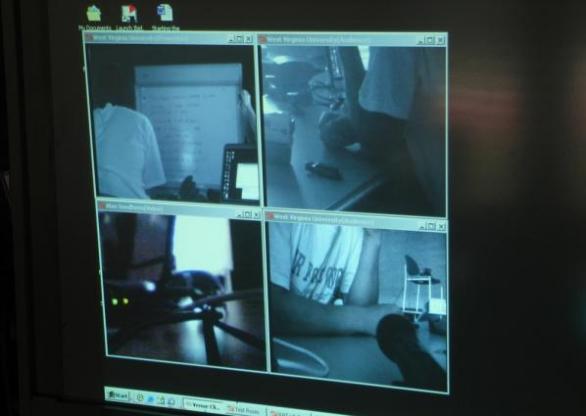
M: Although you are included in an exhibition in a physical space here the vast majority of your output has been presented on the net, usually in the context of one or more mailing lists. Could you say a bit about this. Was this a conscious choice or pragmatism or somehow both? Is there anything you particularly prize about the rhythm of work and presentation that comes with this kind of platform and has the eclipse of many of the old mailing lists with the rise of social media caused problems for you – have you tried to adapt to/utilise these newer modes?
A: It’s pragmatism combined with a desire to explore; edgespace teeters uneasily and tends towards what I call blankspace, where the imaginary exists – for example, the ‘heere bee dragonnes’ in unknown areas of early maps (I haven’t actually seen the expression, but it serves here). I present my work on Facebook and G+; I also used YouTube for a long time until I was banned from it.
M: Banned from it?
A: A long story that would take this too far afield…
I work well in presentation/talk/performance mode online and off. I believe in the depth of email lists of course. I do think my avatar work is really well suited to gallery spaces; I’ve had up to seven projections going at the same time. I’ve also performed live in virtual worlds or mixed-reality situations which are projected/presenced directly, and for a long time Azure Carter, my partner, and I worked with the dancer/performer/choreographer Foofwa d’Imobilite; the physicality of the work was amazing. And another aspect of what I do – what grounds me – is playing musical instruments, mostly difficult (for me) non-western ones; the instruments require tending and close attention. I tend to play fast. Most of them are strings, bowed or plucked; the music is improvisation. Recently I’ve been focusing on the sarangi, for example. And I’ve had something like 17 tapes, lps, and cds issued; the most recent is LIMIT, which was done in collaboration with Azure and Luke Damrosch, who did Supercollider programming based on concepts I’ve had about time reversal in real time – an impossibility in gamespace, but the edgespace is fascinating. The music products excite me; they’re out there in a way that my other work isn’t.
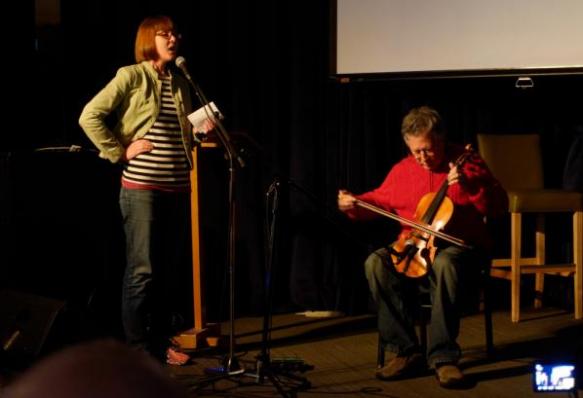
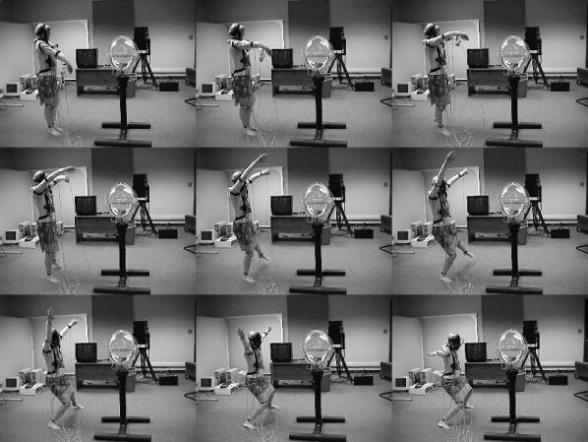
M: I remember when I first discovered internet art or whatever we want to call it (and there have been numerous quasi theological arguments about this) that there was an intense debate about whether the internet was a conduit or a medium – so many artist-scripters/programmer tended to rather look down on those who simply took advantage of the network’s distribution and dialogical properties (although I have to say that my view is that it was in this massive extension of connectivity that the real force of the thing resided – I remember being told in 2001 that moving image was not internet idiomatic which is amusing given the rise of YouTube &c.) Your work, certainly of the last 17 years or so, strikes me as being intimately tied up with the network and with the unfolding possibilities of new media but not necessarily in the sense that you work with the network itself to make objects, works and more in the second sense of the conduit…
A: It depends; for example one of the projects I initiated through the trAce online writing community in 1999-2000 – over the hinge of the millennium in other words – was asking a world-wide group of artists, IT folk, etc., to map traceroute paths and times from the night of 12/31 to the afternoon of 1/1; the internet was supposed to run into difficulties – over timing etc. – and I wanted to create a picture of what was happening world-wide. A second project somewhat later was using the linux-based multi-conferencing Access Grid system to send sounds/images/&c. from one computer to another in the Virtual Environments Lab at West Virginia University – but these images would travel through notes, much like the old bang!paths, around the entire world. So, for example, Azure would turn her head in what seemed like a typical feedback situation – the camera aimed at a screen, she’s in front of it, the result’s projected on the screen, &c. – but each layer of the feedback had independently circled the globe (through Queensland to be specific), creating time lags that also showed the ‘health’ of the circuit, much like traceroute itself. It was exciting to watch the results, which were videoed, put up online with texts &c.
Part of the difficulty I have is being deeply unaffiliated; I need others to give me access to technology. For example, I’ve used motion capture in three different places, thanks to Frances van Scoy and Sandy Baldwin at WVU; Patrick Lichty at Columbia College, Chicago; and Mark Skwarek at NYU. I also did some augmented reality with Mark, and with Will Pappenheimer. To paraphrase, I’m dependent on the kindness of others; I have no lab or academic community to work among in Providence; what I do is on my own. John Cayley gave me access to the Cave at Brown; Eyebeam in NY (I had a residency there) gave me space and equipment to work with, and in both places I was able to create mixed reality (virtual world/real bodies) pieces – those also bounced through the network…
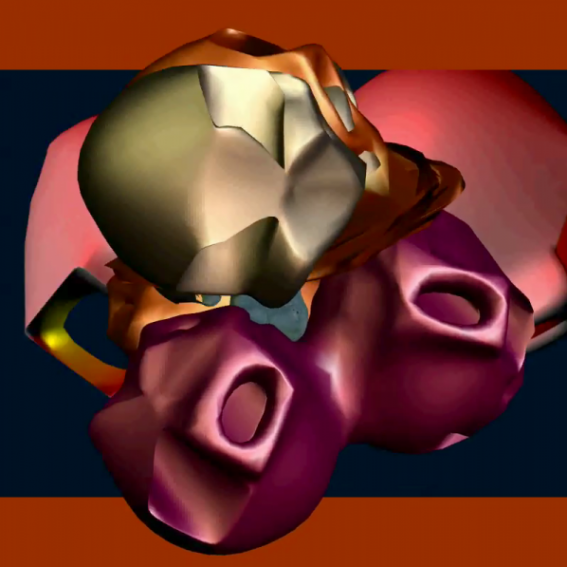
M: Could you talk, then, a bit about the motion capture/avatar work that seems to have been central to what you are doing over the last ten years or so. I also don’t think I’m mistaken in detecting a very decided move back to music making of late (I know this has always been there but it feels foregrounded again)
A: The mocap work has been ‘deep’ for me; it involves distorting the entire process, in other words distorting the somatic world we live in. There are numerous ways to do this; the most sophisticated was through Gary Manes at WVU, who literally rewrote the mocap software for the unit they had. I wanted to create ‘behavioral filters’ that would operate similarly to, say, Photoshop filters; in other words, a performer’s movement would be encoded in a mocap file – but the encoding itself during the movement itself, would be mathematically altered. Everything was done at the command line (which I’m comfortable with). The results were/are fantastic. A second way to alter mocap is by physically altering the mapping – placing the head node for example on a foot. But I worked more complexly, distributing, for example, the nodes for a single performer among four performers who had to act together, creating a ‘hive creature.’ All of this is more complicated than it might sound, but the results took me somewhere entirely new, new images of what it means to inhabit or be a body, what it means to be an organism, identified as an organism. This is fundamental. I’m interested in the ‘alien’ which isn’t such of course, which is blankspace. (The alien is always defined within edgespaces and projections; we project into the unknown and return with a name and our fears and desires.)

Most of what I do, for me all of what I do, is grounded in philosophy – ranging from phenomenology to current philosophy of mathematics to my own writing. So these explorations are also artefactual; I think philosophy is far too grounded in writing as gamespace; writing for me, when it’s touched by the abject, the tawdry, the sleazy, the inconceivable, opens itself up.
As far as music goes, I touched on it above in regard to LIMIT. One thing that concerns me is speed, playing as fast as possible, so that the body and mind move on de/rails that are at my limits; I think of this as shape-riding and the results and internal time dilations involved keep me alive…

M: You are genre/practice/technique promiscuous and you have a high level of skill in all –you could equally (and have been) styled Alan Sondheim ‘writer’ , Alan Sondheim ‘musician’, Alan Sondheim ‘maker of moving image work’ (with a marvellous sub-category ‘Alan Sondheim ‘maker of dance related video works’, for a while). Is one of these, in your heart of hearts, central, and, whether this is so or not, how do you place yourself in respect to the various traditions around these areas of work. How do you fit into the art world, into literature or the experimental film tradition? How do you relate to net art/networked art/new media &c.?
A: I don’t seem to fit into the artworld, net art, poetry world, music world &c. – it’s difficult for me to get my work around as a result. Nothing is central but a desire to see how systems form, coagulate, degenerate, collapse, become abject, &c. in relation to consciousness: How are we in the world? On a concrete level, finance enters into the picture; what can I do given a kind of lack of community around me? How can I push myself?
I’m not sure what ‘net art’ is, but certainly the Access Grid pieces &c. are of that, although not of Web-based protocols. There are so many ports out there to use! I do think of myself as a new media artist or someone burrowing into post-media. I’ve always had a few people who believe in what I do, who have helped or worked with me, and I’m really grateful for that. But in terms of institutions, I feel like an outsider artist and am treated like one. It came to a head for me years ago one day when I was living in Soho; I had a call from Vito who said he had realized that whatever I am, I’m not an artist; the same day Laurie Anderson spoke to me and said she realized that whatever I am, I am an artist. So my identity has been far more fluid than I’ve been comfortable with, and it’s affected my career. (There was that tape Kathy Acker and I made 1974, and I read an interview a few years ago, forget the source, with Edit Deak who said the tape wasn’t art at all; in the meantime, it continues to be shown at various venues.)
M: Finally, could you say a little about the work in this particular show?
A: The work in the show is a group of 3d-printed avatars distorted through the mocap process described above. For me they connect, deeply, with charred bodies, with anguish, with genocide and scorched earth. They appear also in number recent videos created in various virtual worlds, moving/performing etc. The anguish, so close to death and unutterable pain, is there. I’ve talked about the kinds of brutal killings occurring now worldwide, from Finsbury Park to the United States, the rise, not only of racisms, but violent nationalisms, in the U.S. certainly encouraged by the present regime. I’m sick of it. We all have nightmares. I want to understand this, this grounding in the blooded earth that shakes our very ability to speak, to think, to act.
And yet of course we must resist.

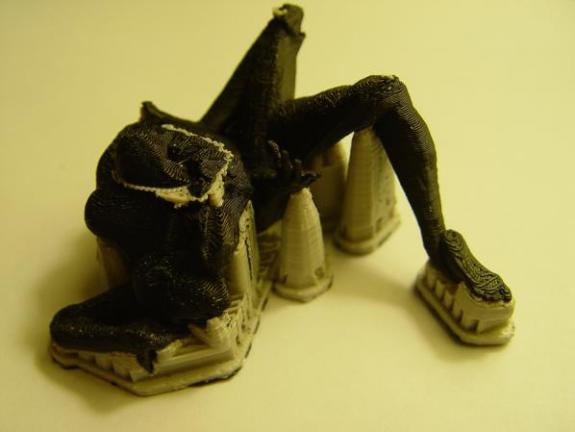
The work in the show is also critical, then, of technophilia, technological answers to the world, utopian dreaming. The top one percent benefit most from the results. I see utopian thinking as dangerous here. Our so-called president has his finger on 4000-5000 nuclear warheads. That’s the reality for me, and why I don’t sleep at night.

Michael Szpakowski: 聽琴圖 (listening to [Alan Sondheim playing] the qin), after Zhao Ji
// gravure, urushi lacquer & pigment on found wood // 30.5X7.5″
At first glance networks and the practice of drawing would seem to be worlds apart. However, the diagram, originally a hand-drawn symbolic form, has long been employed by science as a means of visualising and explaining concepts. Perhaps the most important of these concepts is that of relationships visualised as circles and lines that represent nodes and links or effectively what is related. As such networks, that is groupings of relationships, have come to be visualised through the use of the same styles and iconography employed in diagrams. For artists to reclaim the diagram as a part of their own practice and thereby adopt the practice of visualising networks developed within science sees the practice of creating diagrams in a sense come full circle. Artists have time and time again drawn diagrams and networks that explore relationships. For example: Josef Beuys famously used blackboard diagrams as part of his teaching performances concerning art and politics; Stephen Willats has since the 1960s developed drawn diagrammatic works that explore his socially formed practice; Mark Lombardi drew societies’ networks of power relations throughout the 1990s; Torgeir Husevaag has since the late 1990s drawn diagrams of a number of networks within which he participated while Emma McNally draws diagrammatic networks “bringing different spaces into relation [such as] the virtual world, the networked world and the supposedly real world” (Hayward, 2014).
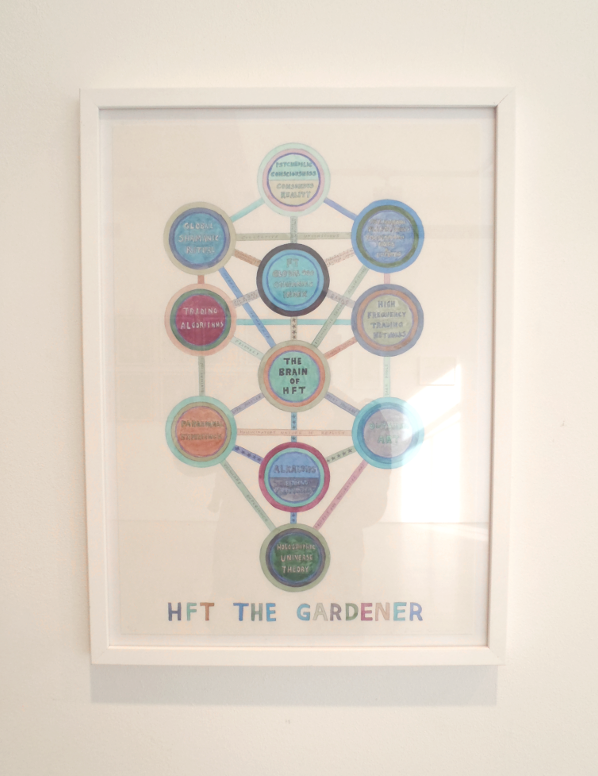
The work of Suzanne Treister resides within this category of artist’s drawing, and in this instance also painting, networks. With a background in painting Treister works across video, the internet, interactive technologies, photography, drawing and watercolour painting (Treister, n.d.). Her work employs “eccentric narratives and unconventional bodies of research to reveal structures that bind power, identity and knowledge” (ibid) within contemporary contexts. As a result of this process of revealing structures, essentially the relationships within the subject matter she addresses and the resulting networks they form, her practice has since the 1990s been closely allied with art that employs or explores technology. She has been repeatedly included in exhibitions and publications that link her work with networks, cybernetics, new media and most recently Post-Internet Art (Flanagan and Booth, 2002; Pickering, 2012; Larsen, 2014; Warde-Aldam, 2014).
HFT the Gardener (2014-15), a recent solo exhibition by Treister at Annely Juda Fine Art in London, is a body of artworks consisting of drawings, paintings, photographs and digital prints supposedly created by a fictional character and a documentary video about the same character. The character, Hillel Fischer Traumberg, is an algorithmic high-frequency trader (HFT) within the London Stock Exchange. After an optically induced semi-hallucinogenic state, Traumberg experiments with psychoactive drugs in order to recreate and further the experience (Treister, 2015). Along the way Traumberg becomes fascinated with botany, experiments with the molecular formulae of drugs as trading algorithms, makes links between the numerological equivalents of plants’ botanical names and the FT Global 500 index, visually documenting all of his research and ultimately becoming an ‘outsider’ artist (ibid). In the process Traumberg transitions from an insider of one network, a trader within the stock exchange, to that of an outsider in another, the contemporary art world.
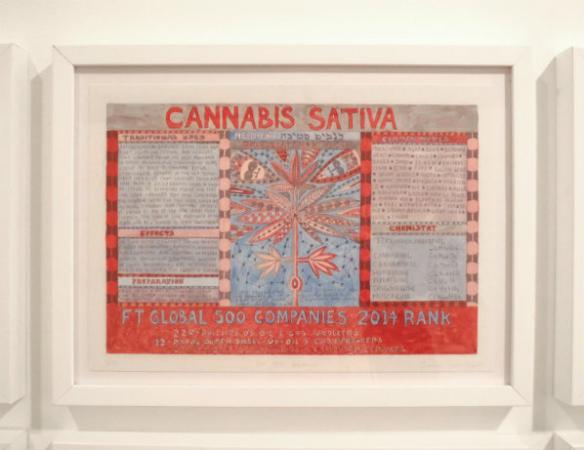

This juxtaposition of opposites is repeated throughout the exhibition. For example, the drawings and paintings of HFT the Gardener employ illustrations of networks containing nodes and links. These illustrate a number of different sets of relationships that are established by the artist. These include: that of the central character to his concepts, research and environment; the locations where drugs were taken; states of consciousness; the components of an algorithm; different companies within a sector and different aspects of the universe including life and art. Additionally a variety of diagrammatic forms are co-opted in the creation of the drawings and paintings including the Judaic Kabbalah Tree of Life, radial diagrams, flowcharts similar to those used in software design and reference is made to a number of other abstracted forms including star charts, snow crystals, fractals and paisley design. Through both form and subject matter the illustrations of networks and the diagrams gather together combinations of opposites. There is of course the use of what can be considered traditional media to illustrate new media forms, however among others there are also the opposites of painting and software, science and art, corporate and counter-culture, belief and fact, fiction and reality.
To coincide with the creation of the artwork a book of the same name has been published. In the foreword Erik Davis states that there is an “initial shock of Treister’s juxtaposition of esoterica and the financial sector” (2016). The same could be said of the numerous other juxtapositions that occur within HFT the Gardener. However, are Treister’s, or is it Traumberg’s, combinations really contrasts that shock? Treister does more than simply juxtapose opposites. The artist effectively synthesises them into a whole that is indicative of our networked era where individuals routinely select, cut, paste and combine combinations ad-hoc to suit a moment or context. HFT the Gardener is an artwork that could only be created in this era of networks and as such it cannot be considered shocking or out of context with the eclectic recombinatory society that surrounds it.
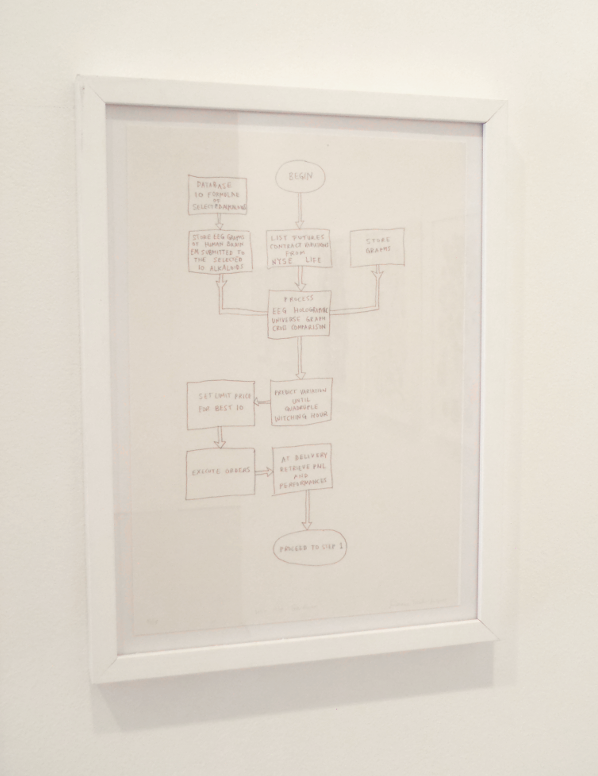
Not only are drawn diagrams and networks employed extensively throughout the exhibition in a number of ways but a network-like structure is also employed to arrange the artworks within the space of the gallery. Initially on entering the gallery space it seems as if artworks are arranged in no particular order. However it gradually becomes clear that this arrangement is purposefully obliging the visitor to enter into and move through the space as if it were a network; that is entering at any point and navigated in any order. While some series of artworks within HFT the Gardener, such as the Botanical prints, maintain an order to illustrate the ranking of companies employed in their creation, the majority of artworks are experienced out of the order they have been created and the documentary video about Traumberg, presumably from Treister’s perspective, is encountered at the midpoint of the exhibition. As such the artworks are presented as if they are interconnected nodes in a network.
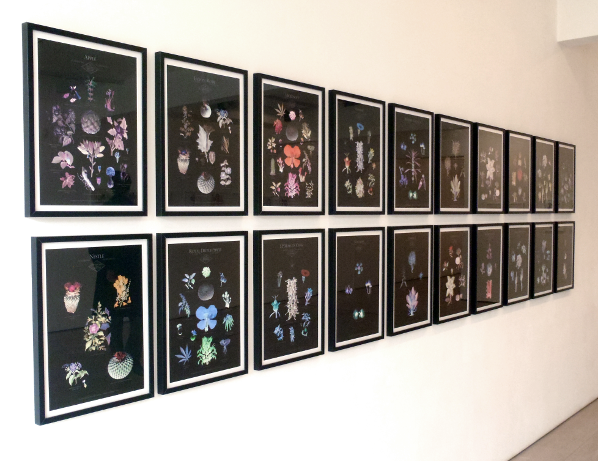
As a result of the diagrams, illustrations of networks, juxtaposed combinations of subject matter and a network-like structure in arranging the artworks within the exhibition Treister successfully manages to make one last combination of opposites, that of non-linearity of experience and linearity of narrative. In doing so the visitor experiences the juxtapositions, combinations and resulting networks formed by Traumberg’s hallucinatory non-linear associations and yet manages to steadily interpret the detailed narrative carefully constructed by the artist. It is in this last combination where the strength of Treister’s exhibition lies as it not only reflects society at large but also suggests that art is and perhaps always has been, a non-linear networked experience that is only now coming into its own.
An exhibition catalogue of HFT The Gardener is available through ISSUU (https://issuu.com/annelyjuda/docs/treister_cat) and a fully illustrated book of the same name is available from Black Dog Publishing, London.
HFT The Gardener will continue to tour throughout 2017 at the following venues. Please see the artist’s website for exhibition updates.
22/10/2016 – 05/03/2017
Selected works from HFT The Gardener exhibited in The World Without Us
Hartware MedienKunstVerein (HMKV),
Dortmund, Germany.
07/01/2017 – 18/02/2017
HFT The Gardener diagrams exhibited in Underlying system is not known
Western Exhibitions, Chicago, USA.
03/02/2017 – 05/03/2017
Selected works from HFT The Gardener exhibited in Alien Ecologies
Transmediale 2017
Haus der Kulturen der Welt, Berlin, Germany.
Featured Image: Olia Lialina, My Boyfriend Came Back From The War, at MU. Photo Boudewijn Bollmann
Twenty years ago, in 1996, Russian artist Olia Lialina created My Boyfriend Came Back From The War (MBCBFTW). Using the story of a veteran’s girlfriend who has mixed feelings when he returns, the interactive Web narrative quickly became an iconic work that inspired many artists to create their own interpretations of it. At the moment two exhibitions at HEK in Basel and MU in Eidhoven, pay hommage to MBCBFTW, a tribute to a medium and a new approach to keeping history alive.
Participating artists
Inbal Shirin Anlen, Freya Birren (Jennifer Walshe), Vadim Epstein, Dragan Espenschied, JODI, Olia Lialina, Abe Linkoln, Guthrie Lonergan, Armin Medosch, Ignacio Nieto, Anna Russett, Tale of Tales a.k.a. Entropy8Zuper!, Mark Wirblich. With two new works by Constant Dullaart and Foundland (commissioned by MU).
Educated as a journalist and film critic, and curating experimental film programmes in Moscow, in the mid-1990s Olia Lialina quickly embraced the Web and started experimenting with its unique qualities. She made her first net art piece, My Boyfriend Came Back From The War in 1996. Four years later she set up the Last Real Net Art Museum – an initiative to oppose museums that were presenting the first ‘Internet art exhibitions’, and a place on the Web where she could collect and exhibit the projects that responded to MBCBFTW. Ten years after she made her first net artwork, in 2006, in their popular book New Media Art (Taschen) Mark Tribe and Reena Jana wrote about MBCFTW: ‘One indicator of the historical significance of Olia Lialina’s 1996 Net art project, My Boyfriend Came Back From the War, is the numerous times it has been appropriated and remixed by other New Media artists. (…) Perhaps it resonates with other artists because it is among the earliest works of New Media art to produce the kind of compelling and emotionally powerful experience that we have come to expect from older, more established media, particularly film.’
In the meantime, Lialina had moved on and in addition to her online art practice, wrote about new media, Digital Folklore, the vernacular Web, co-founded the Geocities Research Institute, and became an animated GIF model and a professor at Merz Academy in Stuttgart, whilst the ‘mini-drama in hypertext’ MBCBFTW continued to be of interest to many artists, curators and critics. For its fifteenth anniversary, The Creators Project described MBCBFTW as a ‘charmingly simple yet poignant work’, emphasising its importance for the history of net art and its longevity through its interpretations. At the moment, as Lialina tells me, the project is discussed on Twine – an open source tool for telling interactive, nonlinear stories – where people communicate with each other about this ‘early Twine’. It is therefore not surprising that 2016 starts with two anniversary exhibitions, opening almost at the same time but in different frames, of My Boyfriend Came Back From The War. online since 1996. In what follows I asked Olia Lialina to reflect on the lasting popularity of the work, her intentions for making it, and her ideas about ways to go forward with it.
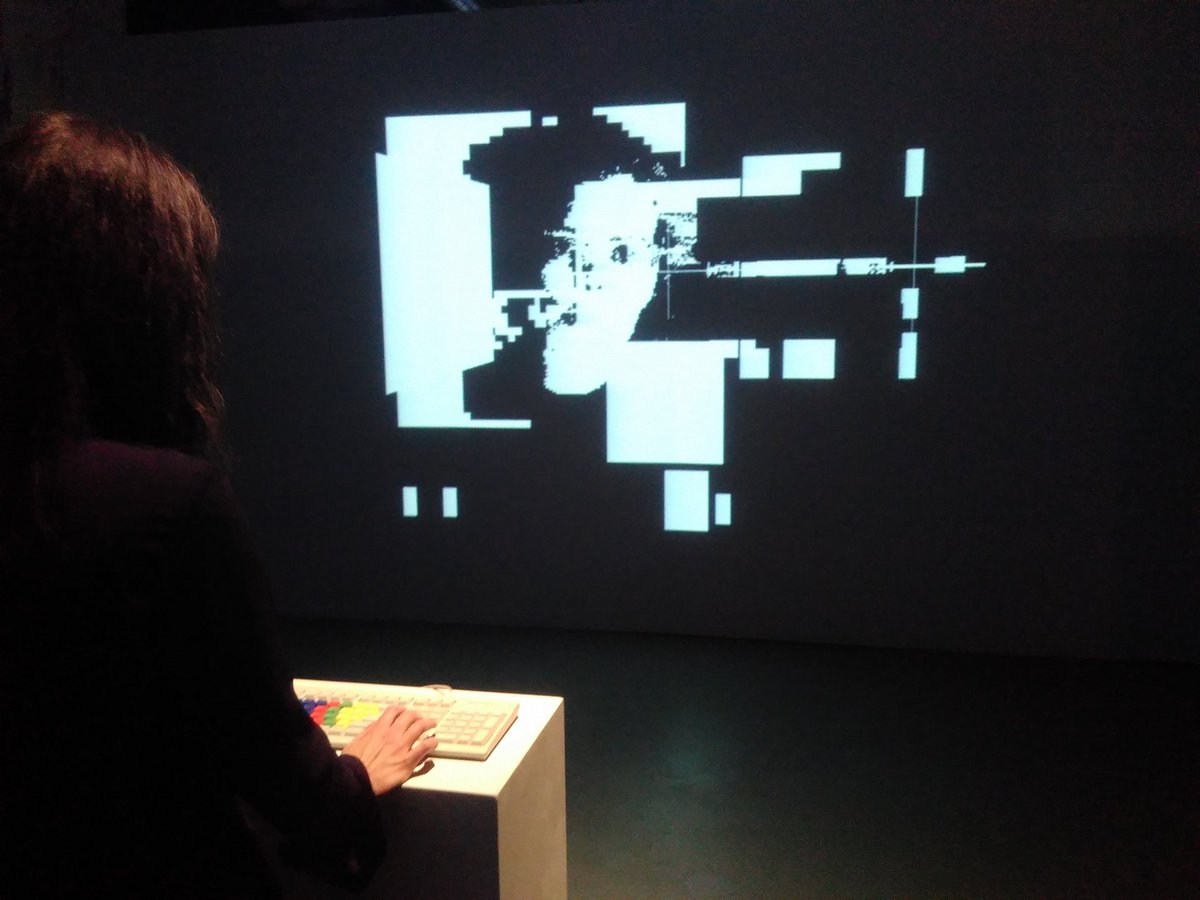
Can you tell me something about your background, how did you end up being an artist and a professor?
Twenty years ago I was absolutely happy with what I did: writing about films, curating film programmes, trying to make my own films. But as with many who embrace the World Wide Web (or were embraced by it) when it left academia in the mid-1990s – I was lucky to have a sudden new life and career. I became an artist only because MBCBFTW became a piece of net art. And I could become a professor four years later because of it 🙂
Could you briefly describe what the work is about?
In my teens I came up with the sentence ‘My boyfriend came back from the war, after dinner they left us alone.’
Мой парень вернулся с войны
И вот мы остались одни
And I always wanted to complete it as a poem, but the next lines never came. Years later, still confused about the phrase, I made it into an ambivalent dialogue with the browser: dividing it into frames. It was never about a war, but about a difficult conversation that doesn’t lead anywhere, and of course about the browser. I wanted to make something that people would spend time with and look at in the browser. This was also possible back then because the connection was much slower – so it took time to go through it. This has changed a lot now: HTML adapts to faster speeds, and most of us aren’t used to waiting – or loading time – anymore. You cannot click slowly if something is fast. That is also why we artificially slowed down the Internet connection for the exhibition.
When you started working on the Web, you came from a background in journalism and film. What sparked your interest in HTML frames?
They were very new at the time, not every browser supported them and you had to install the Netscape 3 version that had just been released – although in specifications I see now that it also worked in Netscape 2, but I remember that it didn’t back then. So, at the time it was cutting-edge technology – even though there was already a ‘I-hate-frames’ movement on the net, which I only discovered later. For me, it was interesting to see that a browser window could be divided up: you could assign coordinates, partition the screen and have multiple HTML documents within the same window. It sounds naive now, but at the time it was very empowering: I felt like a hacker, I could decide what it looked like and how it functioned.
And it reminded me of celluloid. I used to work with experimental 16mm film: cutting and pasting frames together. The editing was a way to work with the material, not just a concept. So, the connection between film and browser frames was something exciting. At the time I always talked about MBCBFTW as a net film. Someone more familiar with CD-ROM art, programming or interactive art would probably see it differently, but for me using frames inside the browser was a way to edit – it was a direct transition from being a filmmaker to a net artist.
While preparing the inventory table with all the elements of MBCBFW for the exhibition and reviewing the HTML code, I saw so many mistakes that I felt a bit ashamed. Mona Ulrich, one of my students, and I noticed warning after warning while reading through the code. So, it’s not only an old code, it is also very buggy, but despite all that it still works! That is the great thing about HTML, it has a very high tolerance, and it’s very forgiving if you write ‘bad’ code. It allows you to make mistakes: it’s not even that it was easy to learn, but rather that you didn’t really have to learn it at all.
In 2000 you started the Last Real Net Art Museum, as an initiative to collect and present interpretations of MBCBFTW. Could you explain the context and purpose of the Last Real Net Art Museum?
The Last Real Net Art Museum was a provocation to museums who in the late 1990s and early 2000s started making their own online net art exhibitions and collections – and at first they seemed to succeed, but it turned out they didn’t. In my title, ‘Real’ meant that an online collection should be based on links, because the net was about making links to people, information, etc. A good example was äda ’web designed by Vivian Selbo and curated by Benjamin Weil for the Walker Art Centre in Minneapolis between 1995 and 1998. Because this and other projects ended, another phenomenon started with museums like the Guggenheim, Tate and Whitney who acquired copies of Internet art and just kept these somewhere on a floppy or a CD, or showed the work in a pop-up window on their website – for me this was not real, and rather disrespectful of the artworks. And ‘Last’ meant that this previous method was completely disappearing.
The Last Real Net Art Museum was also sort of self-referential because of the First Real Net Art Gallery that I made in 1998, where I sold net art. It wasn’t a gallery selling offline art online, but people could buy online art for the first time. Since the First gallery was still well known in 2000, and to make the connection between the works, the second one became the Last…
Talking about museums and collections, was MBCBFTW ever acquired?
Yes, there is a copy at Telepolis, which was sold for what I thought back then was the amazing sum of 300 German Marks, but it was above all a statement. It’s also in a museum collection, MEIAC (http://www.meiac.es/) in Spain, and has been bought by a private collector, too. There is one more edition left. For this one I think it makes sense to sell the complete package: a computer, a monitor with the right resolution (800 x 600) a slowed-down server connection, an emulator with the old Netscape browser and all the other settings. Everything is emulated, simulated and fake, but the work is alive in its most precious state.
I have also adapted the work at certain times, for example around 2006 I added Google Ads to the website, not to become rich, but to reflect the Web of that time. Without the Ads it seemed old-fashioned and I wanted it to be alive and contemporary. About a year ago I removed them, because they made the work look outdated. It was interesting to see what Google thought suited the site – mostly non-governmental sites. Unfortunately, I never captured this version. That’s the irony – part of me is very much involved in preserving the Web, but when it’s about my own work, I change things immediately and forget how it was before.
The adaptations to the medium are striking in all the different interpretations. Seeing all the works next to each other illustrates a historical technical lineage of online practices: from HTML frames to blogs, games, video and VR. In a sense the Web seems almost to be little more than a constantly changing technical environment. Many have argued that this emphasis on medium specificity is one of the reasons why it took/is taking so long for net art to be taken seriously by the traditional art worlds. How do you view the relationship between the concept and the technical or formal aspects of the work?
For me the main concept and message of the work is the medium specificity. When thinking about the MBCBFTW exhibition we noticed now that it is also about the development of the Web. Yes, it has many technical translations. For example, the work by Auriea Harvey and Michaël Samyn (previously known as Entropy8Zuper!) was made in Flash; it was interactive and had sound, and for that time it was the most obvious software to use. Then Blog and Twitter versions were made, people kept changing it to other realities of the Web. What is interesting though is that the last interpretation, by Inbal Shirin Anlen, brought it back to its original classic HTML structure. The variations are some sort of tribute to the medium: these can range from manifestations of particular elements, to an aesthetic message or a personal statement in the medium.
I strongly believe that there is no contradiction between medium specificity and a mature conceptual message. For that reason I also think that it’s important to always emphasise how the work is made – it just being ‘art’ is not enough; I cannot forget about the Web or the net. In my article ‘Flat against the Wall’ of 2007, I wrote that while it is fine that Web art is part of the art market now, it would be a tragedy if we lost its connection to the Web. It can be a topic of contemporary art but it should stay part of the new media art scene.
For the exhibition you choose specific interpretations. What were your criteria for this selection?
We had to make a selection because some things have been lost. At the time of the Last Real Net Art Museum I thought it was important to just have the links to the works rather than showing copies of the works. So, unfortunately now some works are missing because nobody saved them, the Internet Archive didn’t capture them, and the artists (some of them students at the time) said they didn’t have their work anymore. For example, Web comics were popular at the beginning of the century and someone made a version in that style, which unfortunately didn’t survive either.
In the exhibition we left out works that had a similar structure, but almost all of them are featured in the book that was made for the show by House of Electronic Arts (HeK) in Basel, for example, Don Quichote Came Back From The War (2006) by santo_file group. But we also left some out of the exhibition that – perhaps surprisingly – were just too difficult to show such as the beautiful animated gif by Mike Konstantinov. He made this animated gif in 2000 and it was widely used for and known as a website banner. This work was a typical banner, 468 x 60 in size, and because it doesn’t use any of the images from the original work is also mimicked the cheesiness of banners. In the book it is printed frame-by-frame, but it’s difficult to show the banner phenomenon in an exhibition. We thought of several ways: put it on a random website, or against a black background, but in the end we decided not to present it at all. It just didn’t work.
Another example that isn’t included in the exhibition is Roman Leibov’s work. Leibov is the unofficial father of the Russian Internet. In the mid-1990s the Web in Russia had a strong literary tradition, it was all about games with words and meaningful and innovative hypertexts, including of course many references to Russian literature. I made MBCBFTW in English to intentionally distance myself from this tradition. I wanted to create something very formal because I’m very interested in the structures of the browser, the frames, etc. Had I made it in Russian it would have ended up in a different culture. At the time it was a massive effort, because English wasn’t my language. Then I asked Roman Leibov to make a text version and post it on the Russian Internet, which he did. He took every frame and described it like a film critic, and it ends with a monologue, making it into a piece of literature.
How do you see this type of approach now? To me at times it seems there is much less experimentation with templates or in the browser.
Yes, it’s more difficult to be curious now. The browser is still generous, you can open the source code and look at it, but it’s very complicated to change the code, if you can do it at all. The gap between people looking at and those making the pages has become enormous now. At the time it was easy to copy and modify other people’s pages, but now it is much more difficult to do this.
In this sense, perhaps, Blingee is my favourite place to go at the moment. It is a creative community where people fulfil their wish to make something themselves, where they can construct something from other people’s material. It isn’t because they can’t afford Photoshop, it’s about finding things made by others and reusing them such that they become completely different, and also that those layers can be made visible again, showing the elements that have been used. All the layers in the images have value and they are there to be admired. You can also see the tricks people use to fool or misuse the system. Unfortunately, there isn’t a Blingee version of MBCBFTW yet.
What I like about the work from an historical point of view that it consists of two types of archives: the table with all the information and components that are necessary to reconstruct the work, and the living archive of different people’s interpretations. Which method do you prefer?
The archive is an interesting part. MBCBFTW consists of many files, yet it is only 72 KB in size, which is smaller than a small image today. In the early 2000s I wanted to write about the life of a work of art, its making, what is important to keep and its preservation, even though I didn’t think it was necessary for net art. Now I see that it does make sense to write down all these details, so Mona Ulrich and I updated the old table for the exhibition. The table shows all the files, their sizes and which one is used in what frame. Even if someone has never seen the work, it could be reconstructed by following the information on the table. Maybe someone should try it sometime.
However, thinking about the future of the work, I prefer the interpretative approaches, because they are closer to my way of working. I’m also happy, and proud, that people take it as a structure and build something else out of it. I also think it’s interesting to see to what extent it can still be recognised as being an interpretation of MBCFTW, what are those elements? For example, Ignacio Nieto made a tribute for the Chilean soldiers who died in the mountains, it’s his story, and he merely used the same frame structure, but he asked me whether he could make and show the work. It is a bit strange of course, because I don’t have a patent for the frames, yet the specific use of the frames is one of the work’s main characteristics. I also noticed that most people keep the left frame intact and the frames to the right proportionally become smaller. Perhaps it’s similar to the golden ratio in design, but then for frames. A final characteristic is that all the interpretations always end with nothing, with black frames.
The exhibitions My Boyfriend Came Back From The War, online since 1996 are on view till 20 March 2016 at MU in Eindhoven (NL) and HEK in Basel (CH).
The Wrong Biennial, organized by David Quiles Guilló, is possibly the largest internet-based exhibition to date. With a flexible roster of 90 curators and 1100+ artists, this estimation of the exhibition may just be correct. However, as with any project of such a size, The Wrong may serve to be, as well as an overwhelming survey of contemporary media art, it could also be a mirror of individual critics and curators’ desires. But what it also represents for me is a grand bazaar of the current state of media art, and what I would like to discuss, along with a couple of the ‘pavilions’, which are the meta-effects of the exhibition.
But when I talk about The Wrong being a mirror for the hopes and desires of the curators and critics is that the reviews to date are as broad as the exhibition, and sometimes shaped to that critic’s interests or familiar territory. One critic recuses himself as more of a brick and mortar type, looks at a couple pavilions, and then addresses Lorna Mills’ post-internet satire of John Berger’s Ways of Seeing as a possible move to currently familiar territory.Conversely, the business magazine Fast Company, asks if The Wrong will finally allow digital art to sell. A virtual worlds blog hails the FrancoGrid SecondLife-like pavilion as yet another chance for “the art world to finally see the brilliant work happening inside virtual worlds”.

On Facebook, a thread with post-internet & glitch artists muse as to whether the non-institutional nature of The Wrong might constitute some dilution of the work in galleries. The views of The Wrong seem to be, in light of its sheer scope, more a reflection of what the critic finds familiar than tackling the overall project.

These are cursory cross-sections of the discussions happening online. From one review to the next, as important as the art and the artists, is the fact that Guilló has undeniably blown open a gigantic conversation about the nature of electronic art.The Wrong Biennial, regardless of its composition, structure, etc., has proven and a disruptive moment in this moment of hyperprofessionalized media art practice, and has created an online/offline archipelago larger than any festival, such as Ars Electronica, ISEA or Transmediale. And it’s free. But with the size and open nature of such an event in light of professional pressures from student loans to art fairs one asks, what good is being exceptional when you open the gates for undifferentiated curatorial practice? But conversely, art critic Jerry Saltz mentioned that the work he saw after the last art crash in the late 2000’s was more and better after the flattening effect of the crash. Could the rhizomatic effect of the bazaaring of net art created by the sheer scope of The Wrong have created one of the greatest analogies for the current explosion of media art today by giving a lot of it to the online public and creating an agora for discussion as well?
While the effects of The Wrong I am explaining may seem like the title of the Performa ’09 biennial in saying, “Everywhere, All at Once”, Guilló took a flexible, but very rigorous approach to constructing the exhibition. In the beginning, Guillósought funding for the project on Indiegogo, and set up bienniale and curator group pages on Facebook, as well as an extensive exhibition catalogue website. These set a framework for the numerous on/offline “pavilions”, all linked through the biennial online sites. And, periodically, there are docented online “tours” of the Biennial every week or so that attempt to make sense of the content onslaught that The Wrong presents. In a way, this biennial uses the aesthetics of the Long Tail to situate itself somewhere between “snack culture” (Wired, 2007) and recursive self-curation/the “curated life” in its structure to mirror the current cultural sociological terrain. In other words, what is as impressive regarding The Wrong is its structure as much as its content.
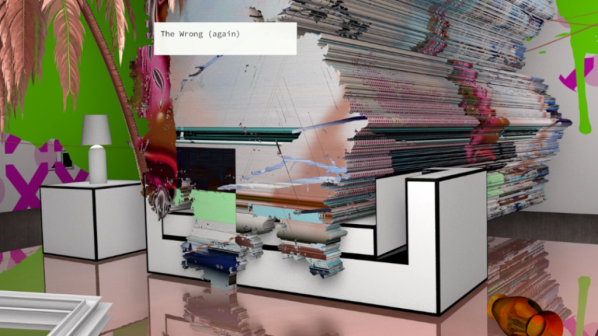
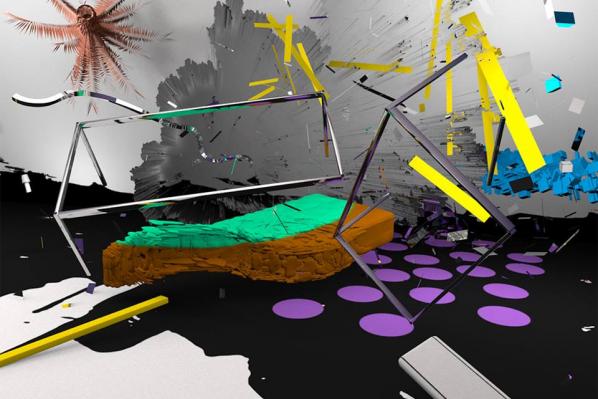
In allowing myself to peer into the abyssal mirror of content implicit in The Wrong and see my own reflection in it, I see a project I did in 1998. I curated a show called Through the Looking Glass for the Beachwood Center for the Arts in Cleveland, a 3000+ sq. foot space. More or less, there were a number of kindly locals who were curious about digital art. For this show, I got 80+ physical artists and 40 or more online artists to show the breadth of the current scene from every continent (there was even an Antarctican photo installation…) Artists included Michael Rees, Scott Draves, Helene Black, RTMark, and many more. The show included a physical space as well as the show website (http://voyd.com/ttlg/) which also included a number of other artists. The exhibition was promoted/discussed on sites like The Thing and Rhizome, and was documented in Christiane Paul’s New Media in the White Cube and Beyond, (UC Press, 2008), somewhat mirroring Guilló’s discursive hydra. The importance was that it got a regional and international dialogue going about the state of media art at the time, much like The Wrong, but only at a fraction of the latter’s scale.

Guilló’s project transcended the museum, as in conversation online he was enroute to one of the museums he has spoken on the subject, including sites Europe, North America (SAIC) and others. In this regard, the reach of the project, while theoretically only possible as something like Ars Electronica’s Net.Condition or the Walker’s Art Entertainment Network in the late 90’s, has engaged the many social media layers from Facebook, Twitter, as well as net.distribution and reached a much wider audience. In this way, I feel Guilló has sidestepped the institution to make an exhibition that reflects the cultural terrain and social practices of its milieu – the Internet. In some ways, I feel that The Wrong could be the first true net.biennial.
With nearly a hundred “pavilions” to view, writing on any one cannot address the scope and structure of The Wrong. Perhaps I am less enthralled with ones that deal with individual artists, moreso with thematic pavilions, and more with the open call ones, as they create a generative basis for expansion of the biennial itself, creating more diversity within it.

One of the open calls that I liked well enough to volunteer for was Brazilian Gabriel Menotti’s Approximately 800 cm³ of PLA, which was an open, print-til-we-run-out, Fluxus-reminiscent, “give us a file and we’ll print it exhibition”. The resultant models were put on display at Baile, in Vitoria, Brazil, and included pieces from veteran Chicago 3D print artists Tom Burtonwood and Taylor Hokanson. Another pavilion of interest (again using the mirror metaphor, as I have been known to do work in virtual worlds) is that of the Wronggrid Pavilion in FrancoGrid, a Francophonic OpenSim (read: open source Second Life) that hosted a 6-month residency with sixteen artists. The WrongGrid Pavilion has generated a great deal of content, especially from Jeannot GrandLapin (Frère Reinert?) as the big avatar rabbit GrandLapin, and another Chicagoan, Paul Hertz. The WrongGrid virtual vernissage was one of the more memorable events in The Wrong as it gave one of the few opportunities for people to meet in the virtual across continents and share in the work in real time. But these are only two of nearly 90 sites that constitute this massive undertaking.
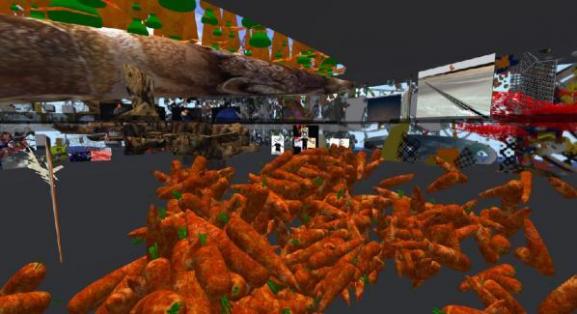
David Quiles Guilló has created a juggernaut – significant enough to get the #3 nod from Hyperallergic for top shows in 2015. From its size and scope, it represents a breadth of artists and themes that shows a fantastic cross-section of the current electronic media art ecosystem. In addition, The Wrong engages avant practices of open curation, nested participation, and relational organization while challenging the necessity of institutions and art fairs. While The Wrong may be as hard as Benjamin’s Arcades Project to get through, most sites give rich experiences, and some give empty links. What is important about The Wrong Bienniale is that it appears to be one of the few projects that is a true net.biennial in terms that it is about the net, how its links with the physical, and how it refers to projects like the Fluxus-inspired Eternal Network that explore how we create through social and technological networks. The Wrong Bienniale is a disruptive site of cultural engagement in a social milieu complaining of malaise and cynicism. It’s time to consider what media art is; how our communities interact; how we operate as a community; and what it means to be a media artist in a mediated culture.
The new project by Guido Segni is so monumental in scope and so multitudinous in its implications that it can be a bit slippery to get a handle on it in a meaningful way. A quiet desert failure is one of those ideas that is deceptively simple on the surface but look closer and you quickly find yourself falling down a rabbit-hole of tangential thoughts, references, and connections. Segni summarises the project as an “ongoing algorithmic performance” in which a custom bot programmed by the artist “traverses the datascape of Google Maps in order to fill a Tumblr blog and its datacenters with a remapped representation of the whole Sahara Desert, one post at a time, every 30 minutes.”1
Opening the Tumblr page that forms the core component of A quiet desert failure it is hard not to get lost in the visual romanticism of it. The page is a patchwork of soft beiges, mauves, creams, and threads of pale terracotta that look like arteries or bronchia. At least this morning it was. Since the bot posts every 30 minutes around the clock, the page on other days is dominated by yellows, reds, myriad grey tones. Every now and then the eye is captured by tiny remnants of human intervention; something that looks like a road, or a small settlement; a lone, white building being bleached by the sun. The distance of the satellite, and thus our vicarious view, from the actual terrain (not to mention the climate, people, politics, and more) renders everything safely, sensuously fuzzy; in a word, beautiful. Perhaps dangerously so.
As is the nature of social media platforms that prescribe and mediate our experience of the content we access through them, actually following the A quiet desert failure Tumblr account and encountering each post individually through the template of the Tumblr dashboard provides a totally different layer to the work. On the one hand this mode allows the occasional stunningly perfect compositions to come to the fore – see image below – some of these individual ‘frames’ feel almost too perfect to have been lifted at random by an aesthetically indifferent bot. Of course with the sheer scope of visual information being scoured, packaged, and disseminated here there are bound to be some that hit the aesthetic jackpot. Viewed individually, some of these gorgeous images feel like the next generation of automated-process artworks – a link to the automatic drawing machines of, say, Jean Tinguely. Although one could also construct a lineage back to Duchamp’s readymades.

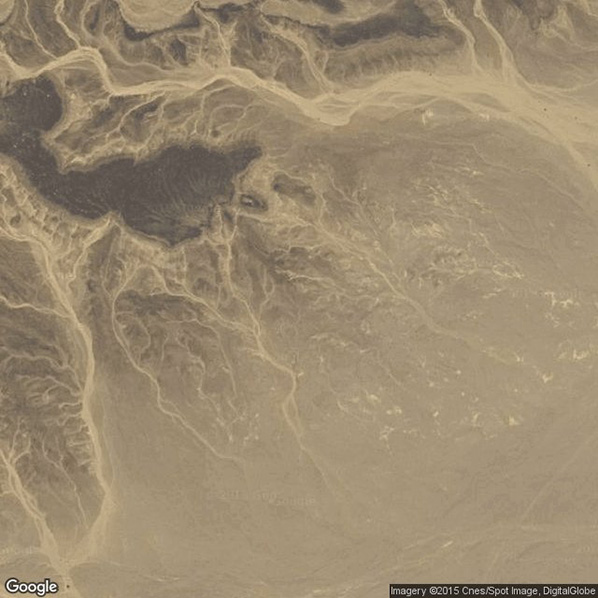
Segni encourages us to invest our aesthetic sensibility in the work. On his personal website, the artist has installed on his homepage a version of A quiet desert failure that features a series of animated digital scribbles overlaid over a screenshot of the desert images the bot trawls for. Then there is the page which combines floating, overlapping, translucent Google Maps captures with an eery, alternately bass-heavy then shrill, atmospheric soundtrack by Fabio Angeli and Lorenzo Del Grande. The attention to detail is noteworthy here; from the automatically transforming URL in the browser bar to the hat tip to themes around “big data” in the real time updating of the number of bytes of data that have been dispersed through the project, Segni pushes the limits of the digital medium, bending and subverting the standardised platforms at every turn.
But this is not art about an aesthetic. A quiet desert failure did begin after the term New Aesthetic came to prominence in 2012, and the visual components of the work do – at least superficially – fit into that genre, or ideology. Thankfully, however, this project goes much further than just reflecting on the aesthetic influence of “modern network culture”2 and rehashing the problematically anthropocentric humanism of questions about the way machines ‘see’. Segni’s monumental work takes us to the heart of some of the most critical issues facing our increasingly networked society and the cultural impact of digitalisation.
The Sahara Desert is the largest non-polar desert in the world covering nearly 5000 km across northern Africa from the Atlantic ocean in the west to the Red Sea in the east, and ranging from the Mediterranean Sea in the north almost 2000 km south towards central Africa. The notoriously inhospitable climate conditions combine with political unrest, poverty, and post-colonial power struggles across the dozen or so countries across the Sahara Desert to make it surely one of the most difficult areas for foreigners to traverse. And yet, through the ‘wonders’ of network technologies, global internet corporations, server farms, and satellites, we can have a level of access to even the most problematic, war-torn, and infrastructure-poor parts of the planet that would have been unimaginable just a few decades ago.
A quiet desert failure, through the sheer scope of the piece, which will take – at a rate of one image posted every 30 minutes – 50 years to complete, draws attention to the vast amounts of data that are being created and stored through networked technologies. From there, it’s only a short step to wondering about the amount of material, infrastructure, and machinery required to maintain – and, indeed, expand – such data hoarding. Earlier this month a collaboration between private companies, NASA, and the International Space Station was announced that plans to launch around 150 new satellites into space in order to provide daily updating global earth images from space3. The California-based company leading the project, Planet Labs, forecasts uses as varied as farmers tracking crops to international aid agencies planning emergency responses after natural disasters. While it is encouraging that Planet Labs publishes a code of ethics4 on their website laying out their concerns regarding privacy, space debris, and sustainability, there is precious little detail available and governments are, it seems, hopelessly out of date in terms of regulating, monitoring, or otherwise ensuring that private organisations with such enormous access to potentially sensitive information are acting in a manner that is in the public interest.
The choice of the Sahara Desert is significant. The artist, in fact, calls an understanding of the reasons behind this choice “key to interpret[ing] the work”. Desertification – the process by which an area becomes a desert – involves the rapid depletion of plant life and soil erosion, usually caused by a combination of drought and overexploitation of vegetation by humans.5 A quiet desert failure suggests “a kind of desertification taking place in a Tumblr archive and [across] the Internet.”6 For Segni, Tumblr, more even than Instagram or any of the other digitally fenced user generated content reichs colonising whatever is left of the ‘free internet’, is symbolic of the danger facing today’s Internet – “with it’s tons of posts, images, and video shared across its highways and doomed to oblivion. Remember Geocities?”7
From this point of view, the project takes on a rather melancholic aspect. A half-decade-long, stately and beautiful funeral march. An achingly slow last salute to a state of the internet that doesn’t yet know it is walking dead; that goes for the technology, the posts that will be lost, the interior lives of teenagers, artists, nerds, people who would claim that “my Tumblr is what the inside of my head looks like”8 – a whole social structure backed by a particular digital architecture, power structure, and socio-political agenda.
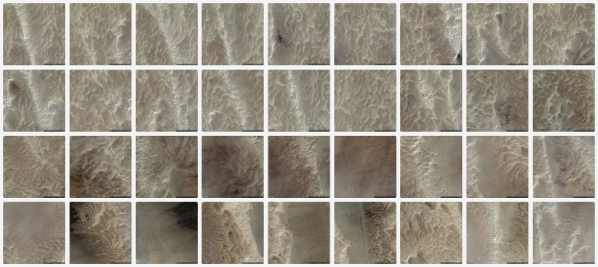
The performative aspect of A quiet desert failure lies in the expectation of its inherent breakdown and decay. Over the 50 year duration of the performance – not a randomly selected timeframe, but determined by Tumblr’s policy regulating how many posts a user can make in a day – it is likely that one or more of the technological building blocks upon which the project rests will be retired. In this way we see that the performance is multi-layered; not just the algorithm, but also the programming of the algorithm, and not just that but the programming of all the algorithms across all the various platforms and net-based services incorporated, and not just those but also all the users, and how they use the services available to them (or don’t), and how all of the above interact with new services yet to be created, and future users, and how they perform online, and basically all of the whole web of interconnections between human and non-human “actants” (as defined by Actor- network theory) that come together to make up the system of network, digital, and telecommunications technologies as we know them.
Perhaps the best piece I know that explains this performativity in technology is the two-minute video New Zealand-based artist Luke Munn made for my Net Work Compendium – a curated collection of works documenting the breadth of networked performance practices. The piece is a recording of code that displays the following text, one word at a time, each word visible for exactly one second: “This is a performance. One word per second. Perfectly timed, perfectly executed. All day, every day. One line after another. Command upon endless command. Each statement tirelessly completed. Zero one, zero one. Slave to the master. Such was the promise. But exhaustion is inevitable. This memory fills up. Fragmented and leaking. This processor slows down. Each cycle steals lifecycle. This word milliseconds late. That loop fractionally delayed. Things get lost, corrupted. Objects become jagged, frozen. The CPU is oblivious to all this. Locked away, hermetically sealed, completely focused. This performance is always perfect.”
Guido Segni’s A quiet desert failure is, contrary to its rather bombastic scale, a finely attuned and sensitively implemented work about technology and our relationship to it, obsolescence (planned and otherwise), and the fragility of culture (notice I do not write “digital” culture) during this phase of rapid digitalisation. The work has been released as part of The Wrong – New Digital Art Biennale, in an online pavilion curated by Filippo Lorenzin and Kamilia Kard, inexactitudeinscience.com.
Choose Your Muse is a series of interviews where Marc Garrett asks emerging and established artists, curators, techies, hacktivists, activists and theorists; practising across the fields of art, technology and social change, how and what has inspired them, personally, artistically and culturally.
Annie Abrahams was born in the Netherlands to a farming family in a rural village in the Netherlands. In 1978 she received a doctorate in biology and her observations on monkeys inspired her curiosity about human interactions. After leaving an academic post she trained as an artist and moved to France in 1987, where she became interested in using computers to construct and document her painting installations. She has been experimenting with networked performance and making art for the Internet since the mid 1990s. Her works have been exhibited and performed internationally at institutions such as the National Museum of Modern Art in Tokyo, New Langton Arts in San Francisco, Centre Pompidou in France, Academy of Fine Arts in Helsinki and many other venues.
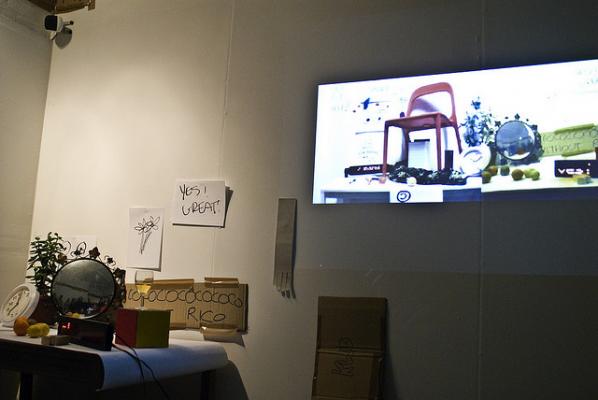
Through the years we have got to know Annie Abrahams via various online, networked artistic collaborations. In 2010, she had a her first one woman show If not you not me in the UK at Furtherfield’s earlier gallery space, the HTTP Gallery. Since then, she has shown at another mixed show at Furtherfield’s current space in Finsbury Park, London. This exhibition, Being Social included other artsists such as Karen Blissett, Ele Carpenter, Emilie Giles, moddr_ , Liz Sterry, and Thomson and Craighead.
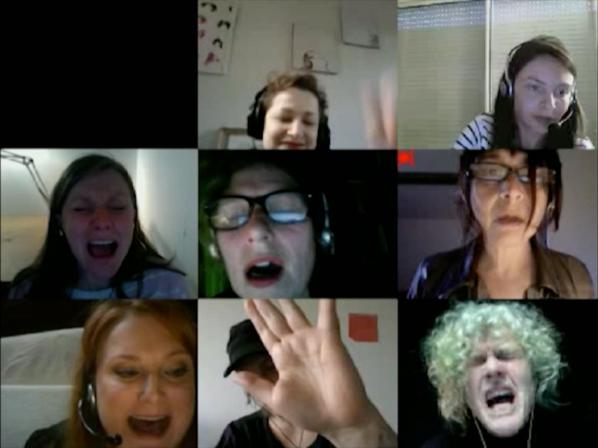
She is known worldwide for her net art and collective writing experiments and is internationally regarded as a pioneer of networked performance art. She creates situations that reveal messy and sloppy sides of human behaviour; capturing real-time moments to illucidate a reality and opening it up, making it available for thought. In an interview with Bomb Magazine in 2014 Abrahams said “My first online performance was my first HTML page. Even then I considered the Internet to be a public space, and everything that I did in that public space asked for a reaction.” [1]
Marc Garrett: Could you tell us who has inspired you the most in your work and why?
Annie Abrahams: Life itself, the people I meet. Until now my basic needs in life have hardly been threatened and so the only real problems I encountered were relational problems. Who are you? Why are you different from me? What does it mean to respect you? Is opposing you necessary? And if so, how can I do that?
MG: How have they influenced your own practice and could you share with us some examples?
AA: My practice was always based on the difficulty of having to live in a world where I don’t understand anything. Every person I meet opens up another view on this impossibility. Sometimes I write short posts about my encounters. Lately I did one on Shirley Clarke and one on Ed Atkins’ No-one is more “Work” than me. aabrahams.wordpress.com
MG: How different is your work from your influences and what are the reasons for this?
AA: My work is made from these influences. In the beginning I thought this was not ok, because I was educated with the idea that you have to be “unique” and make unique artworks. But now I am proud of my sensibility for what others say and do and the way I work with that.
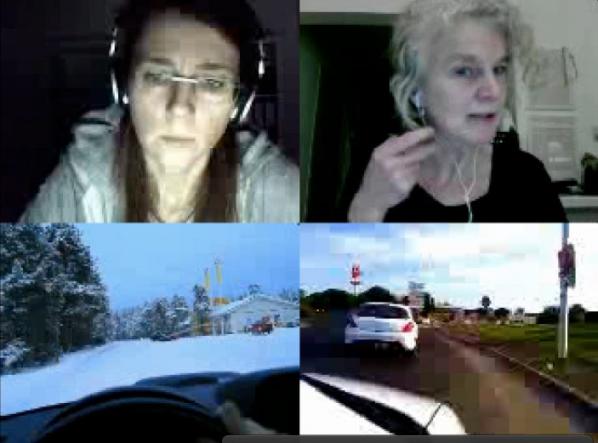
MG: Describe a real-life situation that inspired you and then describe a current idea or art work that has inspired you?
AA: Last summer I made a book called from estanger to e-stranger. Ruth Catlow described it as “all-at-once instruction manual, poetry and a series of vignettes of contemporary encounters in language-less places”. There you can find ideas and art works that inspire me, but in general I am not driven by inspiration, my acts are driven by irritation, my art by incomprehension. Art works sooth, make things bearable and sometimes incite to look beyond habits. Btw I am still continuing my research on how language shapes culture, society and me. http://e-stranger.tumblr.com/
MG: What’s the best piece of advice you can give to anyone thinking of starting up in the fields of art, technology and social change?
AA: Stay close to your own concerns, to things you can have a concrete influence on, observe the results of your actions, pay attention, adapt, and always smile to your neighbour in the morning.

MG: Could you recommend any reading materials or exhibitions past or present that you think would be great for readers to view, and if so why?
AA: For years now every now and then I’ve come back to Darren O’Donnell’s book “Social Acupuncture” and always again I say to myself, “yes, you can think and act art and politics together. Please have a look at the Mammalian Diving Reflex group’s (he is their artistic director) methods. http://mammalian.ca/method/
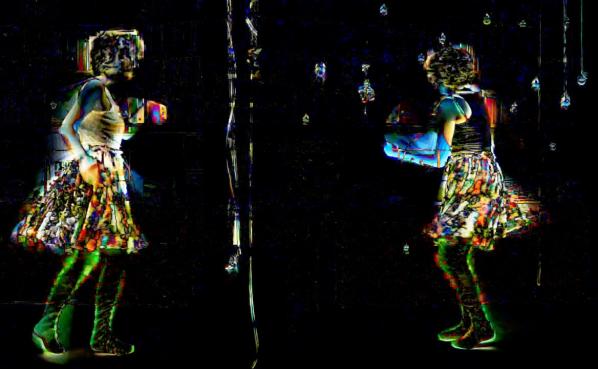
Featured image: A is for Art, B is for Bullshit: A history of conceptual art for badasses, book by Guido Segni 2015
“Outside of the Internet there’s no glory” Miltos Manetas”
Guido Segni, is an Italian artist whose activity began in the fields of hacktivism and Net Art in the 90s. As part of his practice he questions the nature of identity that resides on the Web (acting under many fake identities, like Dedalus, Clemente Pestelli, Guy McMusker, Angela Merelli, Anna Adamolo, Guy The Bore, Umberto Stanca,Silvie Inb, Fosco Loiti Celant, Guru Miri Goro, Leslie Bleus, Luther Blissett) and the value of digital activity with projects like 15 Minutes, anonymous, and The middle finger response.
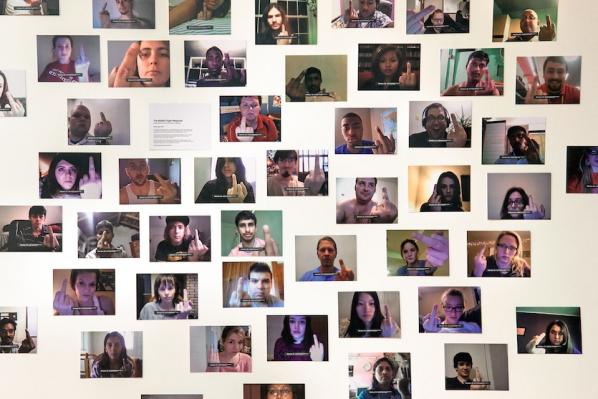
The Internet and lists are two things that have always been together, especially now many of us use social networking platorms such as Twitter and Facebook. We can’t track how and when the first “Top 25/10/5” appeared on the Web, but it’s for sure one of the most frequent ways to gain a lot of attention from Internet users, and it can make you feel as if you’re trapped in a never ending, online fast-food loop. However, when I found out that Guido Segni had created his own version of a top 25 list I was naturally intrigued, so I decided to ask him what it was all about.
Filippo Lorenzin: How and when did you start working on Top 25 Expiring Artists?
Guido Segni: It all started in 2013 after a discussion with Luca Leggero, an artist friend of mine who was working on a piece about the ephemerality of internet art pieces, and it stimulated in me many thoughts on the subject. In the beginning I just wanted to create a sort of memento mori, a list of all artists’ expiring websites. It was only a few months later I introduced the idea of it as a competition, transforming the work into an ironic top artists ranking list, based on the expiration date of their websites.
FL: Could you tell us how it works and how are artists ranked on the list?
GS: It works as many of the other ranking lists you can find on the web. The difference stands on the criteria. While many lists circulating on the web (Top 10 young artist to follow, Top 5 internet artist, etc) are often based on unintelligible criteria, in TEIA (Top Expiring Internet Artists) the criteria are as clear as useless and absurd: the whole list is in fact ordered by the expiration date of the artist website. The nearer is the website expiration date, the better ranking the artist website will obtain. It’s a democratic but very competitive race where everyone can reach the first position even if just for a day. Top 25 Expiring Artists is automagically updated every day – you can only see the top 25 but actually the project counts more than 50 artists. To be included in this list an artist just needs to make an email submission sending the URL of his/her/its website.
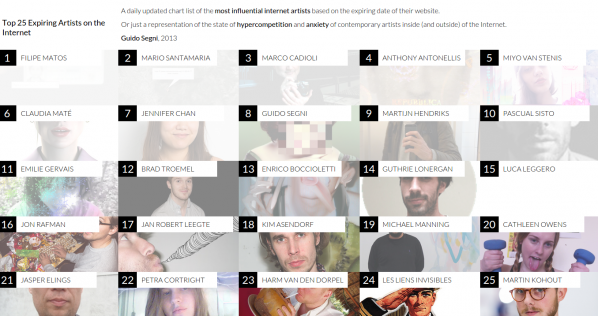
FL: This work has many interesting points to talk about, but I would start with lists-related questions. Does ranking artists on the basis of their aim to be not forgotten mean to highlight a typical behavior of all online users or does it specifically relate to web-based artists?
GS: Actually, the piece is mainly focused on web-based artists. Working with digital based technologies, I’ve always had to face the problem of ephemerality: every year I need to renew the subscription to the hosting service of the many website I own, I periodically have to upgrade the technical environment of my works and often I also need to recode them from scratch in order to keep them all working. That’s why I decided to transform this everyday battle with technology into an ironical and nonsense race for artists, aiming to survive to time.
FL: In the list there are only artists mostly interested in digital issues and I know most of them by person. I have even worked with some of them in previous years and this makes me quite comfortable, like if it was more a sort of reunion with old friends, rather than a competitive race. Is this part of the project or would you like it to be more harsh?
GS: Remember the list is a top 25 Internet artists, so it was natural for me when I started the project to choose the first group of artists mainly involved in digital issues. That said, apart from that memento mori feeling which I’ve discussed before, I was also interested in creating a believable and ironical representation “of the state of hypercompetition and anxiety of contemporary artists inside (and outside) of the Internet.” Probably it’s because I’m a nostalgic of the early days of the Internet – the period of the net utopia – but what I see today is more and more a rising feeling of egotism and selfishness. So what I tried to do is just to stress this contraposition between the brotherhood – what you call the reunion with old friends – and the competition, a perpetual struggle between peers for not being forgot.
FL: This project is ironic. You can say this just by seeing how you mimick aesthetic and text styles of online services like Klout or Google Rank. It seems to me that this is a recurring feature in your works – like in The Middle Finger Response. Is it true?
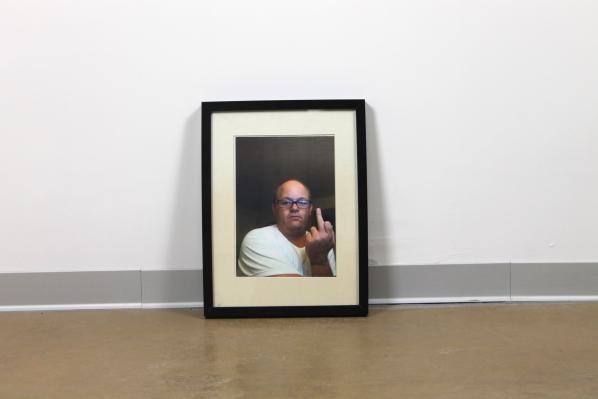
GS: It maybe depends on the fact that I’m from that particular area in Italy (Tuscany) where you can’t either take yourself too seriously. Or maybe it depends on the fact that irony itself is an important feature you can find over all the formats on the Internet. But I agree with you that willing or not the use of irony is a recurrent and strong component of my works.
FL: I’m interested in how people (me too, yes) sign to online services that promise them to rank their online lives on the base of their influence capacity. It’s like watching a mirror made on quantification premises, built by the same system that push you to post more and more about yourself and your incredibly unique existence. In which way this project is related to this phenomenon?
GS: The main intent of the project is to ridicule lists of any sort. But said that, I think the reason why lists – as a cultural form – are so popular is that they have the power to simplify the representation of complex phenomena of reality. So the various “Top artists to discover”, “Top 10 rock bands” or the “Most influential person in the world” are just examples of a fictious narration which give the apparent comprehension of the real. And this is particulary true in an over-polluted space like the Internet.
FL: In the brief conversation we had previously on Twitter, you said to me that you would like to make other versions of this project. Can you tell me something about this?
GS: I have many ideas about these new versions but unfortunately I’m a very slow man and I still don’t know how and when they will be released.
FL: You worked on the branding of people also with 15 Minutes, anonymous. Could you tell us if and how there is a connection between that work and Top 25 Expiring Artists?
GS: To be honest, at that time I hadn’t in mind these connections. From a certain point of view I think they are very different form each other, but it’s true that they both implicitly move around the concepts of fame and anonymity in opposite directions. While in Top 25 Expiring Artists the expire date is an ironic way to reach a sort of fame – even if only for a day – in the case of 15 Minutes, anonymous I focused on the algorithmic aspect of transforming a very large number of pictures of pop symbols into anonymous and abstract pictures.
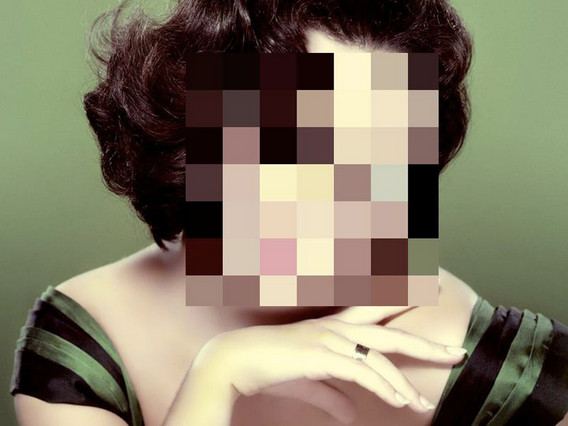



FL: Again, the anonymity and the individual are two of the main questions in your research. This happens also with Proof of existence of a cloud worker, and I recall me Middle Finger Response. What do you think?
GS: Between 2013 and 2014 I made several experiments with crowdsourcing and, yes, Proofs of existence of a cloud worker and Middle Finger Response have many points in common apart from that they are projects based on Amazon Mechanical Turk platform. Basically they both document and display what crowdsourcing is from the point of view of the workers dispersed through the new digital frontiers of leisure and labour. I think you got the point when you talked about anonymity and individual. As all the efforts of crowdsourcing platforms are to hide and anonymize the crowd, what I tried to do is to give them back a face and a voice. In The Middle Finger Response I focused on the spontaneous pose and gesture captured by the webcam, while in Proofs of existence of a cloud worker I used a more abstract and apparently nonsense approach as I asked them to re-enact a clip found on YouTube which shows a person claiming “Pics or it didn’t happen”.
FL: What will you be doing in the future?
GS: As I’ve already said I’m a very slow guy and I’ve been working on this particular project for almost 2 years. But I think we’re almost there and in a few months I’m going to release it. It’s a project about failures, datacenters, space/time travels and desertification of communications. Stay tuned 😉
Featured: Toast McFarland
Synthetic bodies, mediated selves. What themes become relevant in a technoprogressive world – as objects proliferate, what do the inundated people talk about?
You are alone, at a computer. You talk to people but they are not around. There is no bar, no village square, no space in which you speak. There is your device and your physical presence. The social location is your body and its interface with the communicative device. What is the language for landscapes which can’t be seen, and yet which predicate subjectivity?
You express yourself. You are certain state statistics, a resume, you are a myspace profile long defunct. We require your legal name. Certain cards, from when you were born, from when you became qualified to drive, define you, make or break you. You are an ok person provided your paperwork is in order – morality is preceded by bureaucracy.
What’s the relationship between a legitimated self and that person’s body? The more modes of documentation we have the greater possibility for fictional aberration. The disparities between someone’s situated life and the records which make up their memory proliferate.
The image above by artist Toast McFarland was taken in a cartoon world. It is a selfie, a socially streamed validation of presence, but it is also a meticulous reframing of that practice. Everything is subtle, deceptively common, and yet the composition is entirely irreal. Flat colours, almost abstractly plain costuming, this is what happens when a vector world invades your computer room. It exists between personal expression and the self as actor within the surreal.
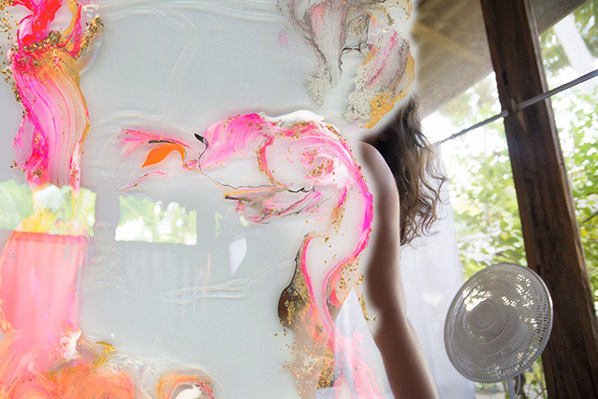
Leah Schrager‘s modelling-inspired self-portraits covered over with bright streams of paint. The model image professionalizes the act of self-representation in image form. In the profession there are industry demands – self-validation may be about confidence and friendship, where industrial success might tend towards epitomization and abstraction. Are you a good model – do you meet the sexual and aesthetic demands of the collective consumer unconscious? Schrager’s work combines a toying with such psychological implications with a background in their material underpinnings – the body in dance, the body in biological study. This combination allows for work and commentary that penetrates the relationship between the vessel you are indelibly given and the psychological relationship it develops mediated for oneself and a public.
Do you view Schrager’s images out of an interest for her or for the type of beauty she represents? Once the image is painted over, is there any interest left? Through different personas, she delivers these in a variety of web contexts, each time asking us to reconsider who we’re looking at, and who we are to look.
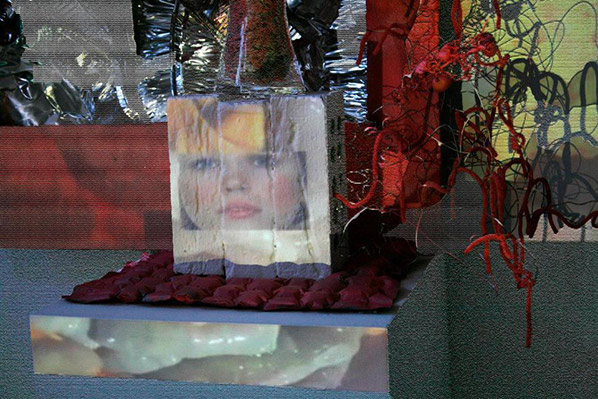

Screens, correspondents, professional speakers. We are happy to take your call. These two screenshots are taken from two videos by media artist Aoife Dunne. Both combine a juxtaposition of found broadcast footage, the enveloping commercial TV world, and her own crafted filming sound stages. They are installations, videos, and imagist combinations that take our question of the self directly to the media world. In the second, Dunne acts directly over top found footage, performing as doppelganger of the telemarketer in the projection. Her simultaneously comic, retro and coolly provocative aesthetic places her into an 80s infomercial dream world. She acts her own fiction, the selfie is the superlative thought experiment, and yet the proliferation of doubles buries her subjectivity in an imagined space of marketed image sheen. In the first work we only have a double, and Schrager’s biological world is fleshed out and externalized. This is what you really look like. Dunne’s own medicalized outfit says that this telecommunication is also a biological translation. For your image, we need your face, but for your face, we need organs and cells. Between the public and economic demands of the screen, and the material demands of your body, where are you?

Dafna Ganani‘s work, through a combination of images, code, social internet art and theoretical reflection, gives us an exemplar of how self-representation meets technical distortion. Her own performative presence proliferates in her work, yet always accompanied by animations, entire interactive worlds complicating any personal space. In this image, self-reflection is directly addressed – at first glance it mirrors what is represented but on closer inspection nothing of what that would look like quite match up. Where are the dragon head things located, where is she, before and after mirroring – the almost comical comparison is undermined by a disquieting sincerity. She appears intent on knowing where she is, however much the dragon doesn’t have her best interests in mind. And the right hand, reaching into the animation cloud on the left, nowhere to be seen on the right.

Dunne’s world of media culture screens is made specific and celebratory in Georges Jacotey‘s self-portraiture as Lana del Ray. An internet performance artist whose work explores media culture and self-image, the picture’s combination is both nearly seemless and parodically collaged. We all participate on some level in commercial culture, but we can never admit it. We might genuinely like aspects of it, we might hate aspects – but the popular bent of this culture means that as long as it is pleasing to a common consumer base it will gain a cultural existence. You know so much about iconic entertainers you never asked to know about. Jacotey takes on this conundrum, joins in on it, participates – what if instead of merely liking a celebrity, you seek to emulate and become them? Some people like del Ray’s albums, Jacotey’s the one who sang them. Capitalism asks that you buy, what if you take the role to sell? Human images make for great products, before we make the necessary transactions let’s make sure we know how to transform ourselves into them.
Good self-representation requires good media savvy. Before you think about your online identity simplify the process by becoming a celebrity. They’ve already figured out all the questions of the self in society – the right names, dress, mannerisms, the right look. Everything is acceptable, everything is inspiring, nothing is quite familiar.

Rafia Santana further draws out Jacotey’s comparison of the celebrity image and the selfie. Two different trajectories are taken up here – one is to deconstruct the fictions of the “real celebrity image”. The second is to fictionalize and play with one’s own portrayal. The result is layered, offering multiple points of entry for both observation and critique. If the digital image is just bits and bytes, what happens to ethnic history, to situated lives and experience? Putting herself repeatedly in her own work, Santana asks the basic question at hand – what, in re-representation, am I? And, with Jacotey, she probes the obverse of media celebrity existence and identification. If I like a celebrity, am I participating at all in their imagery or life? If so, in what way – what right to I have to their life, or in turn, what right do they have to be omnipresent in mine?
Subjectivity is the sentence, objects the fetish – be sure to glamour up.

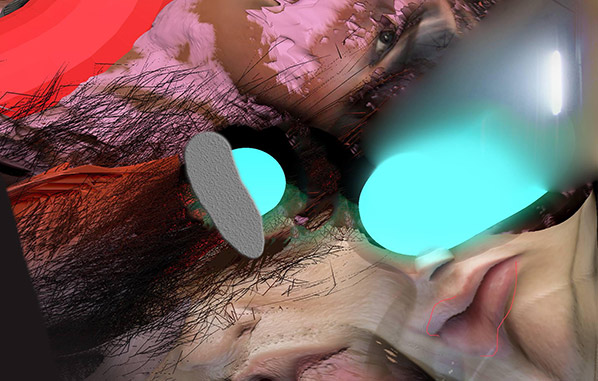
Be sure to dress things up so you can recognize them well. Try not to mix up hair with noses, and composure with distortion. Each act of mediation further twists and reinvents our own images. You thought you knew where your lips were, what your skin looked like, but everything that goes through the machine comes out different, strange. It’s not a human, it’s a landscape. There’s an eye at the top, but you have no idea what it’s for. In the work of Sam Rolfes, the self is almost abstract, technical distortions take over any recognizable vestige of a human. Technique is everything, humanity nothing.
The self is painted, photographed, symbolized. It’s not a live image on the phone. Sometimes people in canvases try to get out. There are a few people here, all the same, that have nothing to do with one another. In Carla Gannis‘ selfie series, we return to a cartoon realism – but this time with a few added mirrors. Is the skull in the background also her? What is that a memento of?
Death in the image, life in its reproduction. You are now invisible, but we know more about what you look like than ever. Technological proliferation upends and eliminates traditional context but can never efface bodies and their identities. Indeed its societal saturation emphasizes these presences, their inevitability and all their embodied ties that digitize incompletely.
These practices work to situate the self, the body. Physiological maps are now more important than ever – they give us the image of the virtual. Mythology says we are in an immaterial age, that humans are obsolete and will be succeeded by machines. Reality says something far more disturbing – that our own materiality is the means of that obsolescence.
Featured image: Stern, Body Language
Interactive Art and Embodiment: The Implicit Body As Performance by Nathaniel Stern. ISBN 978-1-78024-009-1 (printed publication), Gylphi Limited, Canterbury, UK, 2013. 291 pp., 41 Colour Stills.

Earlier this year, I had the good fortune to sit in on a talk given by Simon Penny on May 6th 2014 at the University of Exeter. Penny, not unlike Nathaniel Stern, is best known for his praxis, writing and teaching on interactive (and robotic) installations focusing on issues of embodiment, relationality and materiality. So as unorthodox as its inclusion is to start off a review, Penny’s reflections are pertinent here (in this case, Penny’s famous installations Fugitive (1997) and Traces (1999) [1].
The purpose of Fugitive and Traces (if you can say they had one) sought to ‘embody’ virtual reality through multi-camera infra-red sensors, visual models and real-time movements. At that time, Penny’s unique theoretical take was to distance human-computer interaction away from “a system of abstracted and conventionalised signals” to where the user would “communicate kinesthetically”: instead of investigating the non-human or “inhuman” formal qualities of its medium, or some vague VR future that leaves the body behind, the system itself would “come closer to the native sensibilities of the human.” (Penny) [2]
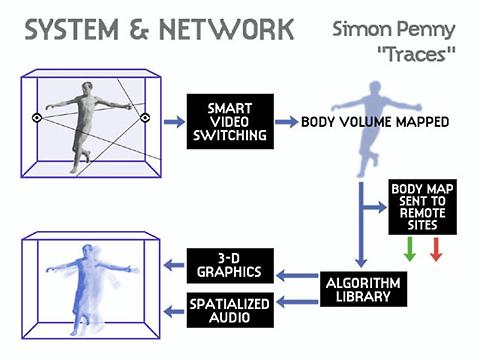

In his Exeter talk, Penny momentarily reflected on a weird and altogether disturbing seventeen year feedback loop. The loop in question relates to how, in 2014, Penny’s early avant-garde ideas and theoretical ambitions have largely been desecrated by their replication in big business. With regard to Traces, Penny cited Microsoft’s Kinect as being the most salient example of this desecration: Kinect’s technology – marketed for the Xbox console brand – carries within its insidious techniques the ability to also “communicate kine[c]thetically”, but do so within pre-packaged, patented, IP-driven, focus-grouped-out-of-existence, commercial vacuities of gamer experience.

As an early practitioner and developer of these technologies, Penny was somewhat visibly infuriated with this, and understandably so. For him, it unintentionally reduced his aesthetic experimentation, philosophical insight, technological futurity and theoretical complexity into consumer speculation for the technology market, commandeering the tech but without the value. It transposed the artistic technological avant-garde necessity of Traces into a flaccid ‘tech-demo’ demonstration of novelty limb flailing and high-end visuals devoid of anything. It was, Penny lamented, “a very weird situation” to be in. Part of that weirdness has to do with the fact that Penny hadn’t done anything especially wrong, because there wasn’t any tangible aesthetic qualities that separated his pioneering work from Microsoft’s effort. Neither had Penny’s work brought financial success with its value intact (because its value wasn’t patentable). Instead technological development had overwritten the aesthetic value of Traces, trading technological obsolescence with aesthetic obsolescence.

Penny’s retroactive predicament is not unique in the history of digital art: for all the visionary seeds of potential in Roy Ascott’s legendary networking project, Terminal Art (1980) we now recognise how those salient characteristics have somehow ended up as Skype or Google Hangouts. Still in the 80s, one might evoke Eduardo Kac’s early videotext works (1985-1986) where visual animated poems were broadcast on the online service exchange platform Minitel (“Médium interactif par numérisation d’information téléphonique” or “Interactive medium by digitalizing telephone information” in its French iteration): a proprietary precursor to the World Wide Web [3]. The retroactive weirdness accompanying these developments is something I’ll come back to: suffice to say that what counts is the direction (and sometimes hostile return) of infrastructure, not just as the background collection of assemblages artists rely on to experiment with at any historical moment, but the shifting ecological foundations to which technology emerges, affords, and now overwrites such practices. No-one likes to play devil’s advocate and yet one must ask the question specific to Stern’s text: what, or maybe where, is the tangible point at which ‘art’ becomes historically valued in these works, if that latent aesthetic potential becomes just another market for a series of Silicon Valley, or startup conglomerates?
——–
Nathaniel Stern’s Interactive Art and Embodiment establishes two first events: not only Stern’s debut publication but also the first of a new series from Gylphi entitled “Arts Future Book” edited by Charlotte Frost, which began in 2013. All quotations are from this text unless otherwise stated.
Stern’s vision in brief: in order to rescue what is philosophically significant about interactive art, he justifies its worth through the primary acknowledgement of embodiment, relational situation, performance and sensation. In return, the usual dominant definitions of interactive art which focus on technological objects, or immaterial cultural representations thereof are secondary to the materiality of bodily movement. Comprehending digital interactive art purely as ‘art + technology’ is a secondary move and a “flawed priority” (6), which is instead underscored by a much deeper engagement, or framing, for how one becomes embodied in the work, as work. “I pose that we forget technology and remember the body” (6) Stern retorts, which is a “situational framework for the experience and practice of being and becoming.” (7). The concepts that are needed to disclose these insights are also identified as emergent.
“Sensible concepts are not only emerging, but emerging emergences: continuously constructed and constituted, re-constructed and re-constituted, through relationships with each other, the body, materiality, and more.” (205)
Interactive Art and Embodiment then, is the critical framework that engages, enriches and captivates the viewer with Stern’s vision, delineating the importance of digital interactive art together with its constitutive philosophy.
One might summarise Stern’s effort with his repeated demand to reclaim the definition of “interactive”. The term itself was a blatantly over-used badge designed to vaguely discern what made ‘new media’ that much newer, or freer than previous modes of consumption. This was quickly hunted out of discursive chatter when everyone realised the novel qualities it offered meant very little and were politically moribund. For Stern however, interactivity is central to the entire position put forward, but only insofar as it engages how a body acts within such a work. This reinvigorated definition of “interactive” reinforces deeper, differing qualities of sensual embodiment that take place in one’s relational engagement. This is to say, how one literally “inter-acts” through moving-feeling-thinking as a material bodily process, and not a technological informational entity which defines, determines or formalises its actions. A digital work might only be insipidly interactive, offering narrow computational potentials, but this importance is found wanting so long as the technology is foregrounded over ones experience of it. Instead ones relationship with technological construction should melt away through the implicit duration of a body that literally “inter-acts” with it. In Stern’s words:
“…most visually-, technically-, and linguistically-based writing on interactive art explains that a given piece is interactive, and how it is interactive, but not how we inter-act” (91)
Chapter 1 details how aesthetic ‘vision’ is understood through this framework, heavily criticising the pervasive disembodiment Stern laments in technical discussions of digital art and the VR playgrounds from the yesteryear of the 90s. Digital Interactive Art has continually suppressed a latent embodied performance that widens the disembodied aesthetic experience towards – following Ridgway and Thrift – a “non-representational experience.” Such experiences take the body as an open corporal process within a situation, which includes, whilst also encompassing, the corporal materiality of non-human computational processes. This is, clearly, designed to oppose any discourse that treats computation and digital culture as some sort of liberating, inane, immaterial phenomenon: to which Stern is absolutely right. Moreover, all of these material processes move in motion with embodied possibilities, to “create spaces in which we experience and practice this body, its agency, and how they might become.” (40) To add some political heft, Stern contrasts how the abuse of interactivity is often peddled towards consumerist choice, determining possibilities, put against artistic navigation that relinquishes control, allowing limitless possibilities. Quoting Erin Manning, Stern values interactive art’s success when it doesn’t just move in relation to human experience, but when humans move *the* relation in experience (Manning, 2009: 64; Stern, 46).
Stern’s second chapter moves straight into a philosophical discussion denoting what he means by an anti-Cartesian, non-representational, or implicit body. Heavily contexualised by a host of process, emergent materialist thinkers (Massumi, Hayles, Barad), Stern concentrates on the trait of performance as the site of body which encapsulates its relationally, emergence and potential. The body is not merely formed in stasis, (what Stern dubs “pre-formed” (62) but is regularly and always gushingly “per-formed” (61) in its movement. Following Kelli Fuery, the kind of interactivity Stern wants to foreground is always there, not a stop-start prop literate to computer interaction, but an effervescent ensemble of “becoming interactive” (Fuery, 2009: 44; Stern, 65). Interactive art is not born from an effect bestowed by a particular medium of art making, but of “making literal the kinds of assemblages we are always a part of.” (65)

Chapter three sets out Stern’s account for the implicit body framework: detailing out four areas: “artistic inquiry and process; artwork description; inter-activity and relationally.” (91) Chapters four, five and six flesh out this framework with actual practices. Four considers close readings of the aforementioned work of Penny together with Camille Utterback merging the insights gained from the previous chapters. What both artists encapsulate for Stern is that their interventions focus on the embodied activities of material signification: or “the activities of writing with the body” (114) Utterback’s 1999 installation “Textrain” is exemplary to Stern’s argument: notably the act of collecting falling text characters on a screen merges dynamic body movements with poetic disclosure. The productions of these images are always emergent and inscribed within our embodied practices and becomings: that we think with our environment. Five re-contextualises this with insights into works by Scott Scribbes and Mathieu Briand’s interventions in societal norms and environments. Six takes on the role of the body as a dynamic, topological space: most notably as practiced in Rafael Lozano-Hemmer. Chapter seven I’ll discuss near the conclusion: the last chapter shortly.
Firstly, the good stuff. Interactive Art and Embodiment is probably one of the most sincerest reads I’ve encountered in the field for some time. Partly this is because the book cultivates Stern’s sincerity for his own artistic practice, together with his own philosophical accounts that supplement that vision. His deep understanding of process philosophy is clearly matched by his enthusiastic reassessment of what interactive art purports to achieve and how other artists might have achieved it too. And it’s hard to disagree with Stern’s own position when he cites examples (of his work and others) that clearly delegate the philosophical insights to which he is committed. One highlight is Stern’s take on Scribbes’ Boundary Foundations (1998) and the Screen Series (2002-03) which intervenes and questions the physical and metaphorical boundaries surrounding ourselves and others, by performing its questioning as work. This is a refreshingly earnest text, proving that theory works best not when praxis matches the esoteric fashions of philosophical thinking, but when art provides its own stakes and its own types of thinking-experience which theory sets out to faithfully account and describe. Stern’s theoretical legitimacy is never earned from just digesting, synthesising and applying copious amounts of philosophy, but from the centrality of describing in detail what he thinks the bodily outcomes of interactive art are and what such accounts have to say: even if they significantly question existing philosophical accounts.
Stern leaves the most earnest part of his book towards the end in his final semi-auto-biographical companion chapter called “In Production (A Narrative Inquiry on Interactive Art)”. This is a snippet of a much larger story, available online and subject to collaboration [4]. Here, Stern recounts or modifies the anxiety inducing experience of being a PhD student and artist, rubbing up alongside the trials of academic rigour, dissertation writing and expected standards. Quite simply, Stern is applying his insights of performative processual experience into the everyday, ordinary experiences faced by most PhD students in this field, and using it to justify a certain writing style and a sense of practice. It’s an enjoyable affair – in large part because it outclasses the dry scholarly tone usually associated with writing ‘academically’, elevating imaginative, illuminating redescriptions for how the experiences of interactive art broadly hang together rather than relying on relentless cynical critique. And most of that is down to Stern’s strong literary metaphorical technique for grounding his vision, perhaps even more effectively than the previous chapters.
Yet earnest experiences aside, there are two problems with Stern’s vision which, in my eyes, leave it flawed. That isn’t a bad thing: all visions are flawed of course. That’s why the similarities between art and philosophy feed our heuristic, academic compulsion to come up with them and debate: well, that and sometimes the most flawed can end up being the most influential. Such flaws only arise in relation to what Stern thinks is valuable in interactive art, and to the extent that the intervention posed may require readdressing. The flaws in question are composed from two different angles, but stem from one objection. The first is philosophical, or at least a problem pre-packaged with relying almost entirely on relational ideas of embodied emergence. The second is more tied to infrastructure and technical expropriation as outlined in Penny’s predicament given from the outset.
In his introduction, Stern makes clear that this is an “art philosophical book” (4), not a philosophy of art as such: only one that “understands art and philosophy as potential practices of one another” (4). Following Brian Massumi, philosophy “tells us the stakes”, whilst “art brings those states to the table” (5), such that the type of art he values and constructs, (digital interactive art) is precisely that which melts away in its interactive encounter when constructed as work. Later on we discover that interactive art “interrupts relationality” (66), making present an “intervention that brings a situated moving-thinking-feeling to a higher power.” (66) Further on, interactive art does something else, when it “intensifies features of […] the ongoing transformation of the ‘living’ body”, and “gifts us with a state to practice being and becoming.” (73) Reflecting on the infamous Bourriaud/Bishop relational aesthetic ruckus a decade ago, Stern outlines how they focus on the explicit body (82) (how we understand ourselves or challenge explicit social/economic positions in the world), whereas artworks which privilege the implicit body have us “encounter how we move, transform, and are (continuous)” (82) in the world. The former takes on the materiality of social relations, the latter (endorsed by Stern) takes on the whole materiality of “embodied relations” (83). And again to reiterate, art operates as “the practice of contemporary philosophies, where we investigate, and further research on, embodiment and relationally together.” (83).
Now, one should admire how Stern blends philosophy and art praxis together precisely by not shoehorning authoritative philosophical accounts into art praxis where they aren’t needed. This works, precisely as the ontology expressed here actively resists such authoritative accounts as well as being cemented with the sort of sincerity with which Stern has such a keen literary grasp. More importantly, Stern cites works which seem to fit the stakes of his ontological conviction perfectly.
However the reliance of process-based philosophy dampens exactly how these works intervene to bring about the values he so desires. The simplest objection comes from asking how Stern might value anything at all, if our entire relational embodiment with the world is constantly in process – or that “[b]odies and matter are change” (220) – and must be always affirmed as such: why should every process and every bodily interaction be affirmed? Moreover why is it art’s place to give primacy to the ontological events of bodily material change?
This is one of the key infrastructural problems that surface, once a theory of art totally subscribes to a process-based ontology, let alone one focusing on embodiment: why should an artist like Stern feel compelled to present an intervention in the first place? If the dominant ontological movement of interactions is a becoming-event, by what standard or eruption should interactive art be said to work on? If, as Stern believes, “the interactive process in interactive work is the ‘work’” (159), it becomes unclear what value interactive artworks are purported to convey, if that process is all there is. To say that embodied processual events make the work “work”, because they underscore our situational intelligibility (or make it effective – so to speak) speaks nothing of what differential criteria should apply to make that aesthetic intervention intelligible. To hazard a guess, the problem is one of articulating how convention exists in a process ontology: because if everything is always emerging as an interactive event of change, the act of rupturing or intervening in convention becomes a real problem. The criteria for valuing these important works is only affirmed it seems, because every process is already affirmed: and if that’s the case you don’t need artists to make an intervention – there is no intervention required, other than the events that already exist, as change in themselves. To put it another way: why should (and how can) a work effectively gift us heightened states of being and becoming, if our entire situational relationship with the world is already situationally related in being and becoming?
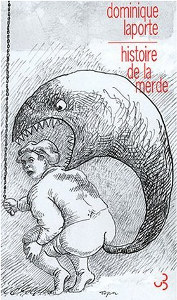
I am reminded of Adrian Johnston’s 2001 review of the newly republished English translation of Dominique Laporte’s History of Shit (first published in 1978). Whereas most Foucaultians and Althusserians were disconcertingly vague in pointing out the concrete material conditions for subjectivity and economical production, Laporte boldly contended that the genealogical hypothesis to all modern civilisations was tied to one concrete material condition: the infrastructure of bodily waste management, or, the desire to control and sublimate our need to defecate. In his usual Žižekian repartee, Johnston suggested that Laporte’s bizarre history of modernity implicitly accepted the anti-Cartesian embodiment thesis (that cognition cannot be separated from the actions of the body), but pushed its logic to the end. That for all the affirmative, encompassing, sensual, emergent, potential images embodiment philosophy prefers to agree and discuss, it completely ignores one of our central and basic bodily requirements: to excrete our bodily waste or fecal matter, and remove it from sight and smell (and we don’t need to remind the reader of art’s fascination with this area).
Whilst Johnston’s tongue was firmly planted in his cheek, he did happen to put a psychoanalytical finger on the central problem with process based embodiment. That often enough, sincere accounts of embodiment designed to affirmatively depict and encompass implicit environment material engagements leave behind an unacknowledged stain: one which says more about these accounts than their proponents actually do. And it is precisely because Stern focuses on the most aesthetically agreeable areas of bodily engagement in interactive art, that something as habitual and ritualistic as the excretion of digested matter, or the infrastructure of sewage networks exposes that image.
In terms of materiality this is doubly important. Laporte’s intervention brings into conflict two competing performative materialisms which disclose our own bodily relationships with non-human processes (in this case, computational and networked material): the first is Stern’s own account of the material body as some sort of ‘nebulous material’ which is always emergent, lived, relational and thinking with its own engagement in the world of humans and non-humans. The second is Laporte’s material body seen as ‘brutal material’ – an explicit input-output, complex, evolutionary processing machine, strictly determinate and bounded in its biological function. Despite Stern arguing earnestly for the nebulous form, it doesn’t appear to me that he can hold off the brutal form, or at least prevent the latter from antagonising the former. And often enough, this happens because Stern’s accounts of embodiment, and the philosopher’s accounts he relies on, are already meant to be nebulous in themselves.
This logic unravels by chapter seven, when Stern expands the implicit body framework to analyse other examples of new media art which aren’t preoccupied with bodily participation to work, as work. He terms this “potentialized art” (206) where “audience members do not *make* the work directly through their interactions (207) but are subject to visual performances of potential movement and relation mediated by generative computation and networks. In citing Gordan Savičić and Jessica Meuninck-Ganger – amongst others – Stern argues that these ongoing performances harness generative information participating in embodiment relations, and invite metaphorical sensory change and bodily movement (in the case of Savičić’s performances, quite literally inflicting pain and suffering onto his own body using network data and social media).
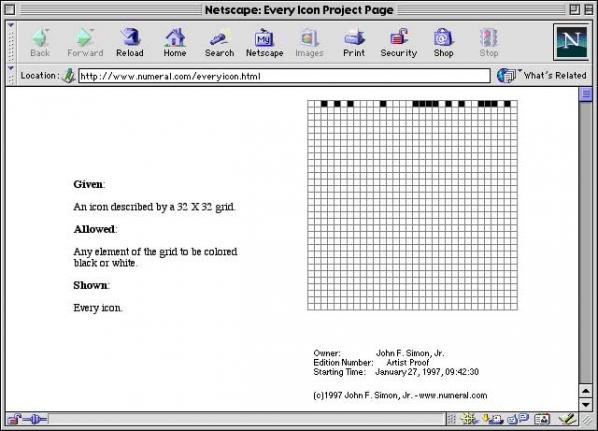
However when Stern cites John F. Simon. Jr’s infamous work Every Icon (1997), (227 – 230) (a cellular automation piece which takes approximately several hundred trillion years to complete) it becomes clear to me that the aesthetically agreeable areas of embodiment start to break down. It might be that my own reading of the piece is fairly unorthodox [5] (I don’t consider the work to be primarily conceptual for a start), but Every Icon eschews what Stern writes as giving “both the corporeal and incorporeal a present and future presence as time and sign” (230) or something that generates attention to our “sensual and conceptual experience of temporality” (230).
Yet, isn’t it the case that Every Icon is probably one of the least potentialised artworks ever made? It doesn’t actually generate anything, (in the strict sense of unpredictable outcomes from simple rules) it simply enumerates configurations of pixels one by one. Neither can we be said to “feel the potency of several hundred trillion years” (230) than we feel the cold, indifferent execution of a real java applet function to which we are forever limited in experiencing directly. If anything, Every Icon is deliberately constructed to forgo a relation with us.

To conclude: this is perhaps why Penny’s predicament with the Kinect is so stark. To demand, as Stern does, that we treat digital interactive art as setting a stage for examining how we “per-form” with our bodies within media, material, conceptual frames and selves, is no longer enough of a stage to give voice to the technological ecologies we find ourselves in: nor of the art that satisfies intervening in it. Credit must be given to Stern for writing over interactive art’s emancipatory myth of disembodied immateriality, but his endorsement of embodiment only serves to realise that the problem isn’t forgetting to focus on material engagement, but forgetting the cold, hard and brutal materiality of procedural performance of infrastructure, that often moves faster than we do. When Microsoft’s Kinect co-opts all the same values of Traces, it does so not because embodiment is totally flawed, but that bodily movement has now become ecologically implicated in deceptive infrastructure.

Just as Penny’s Traces may once have evoked a renewed attention to moving-thinking-feeling, such engagements are now suitably tracked and are in service of non-transparent infrastructures of geo-social activity, which propagate themselves beyond our sensory engagement, yet paradoxically they also indirectly sustain that ordinary engagement. For example, this is now a world where Google funds a 60tbps undersea cable connecting the West Coast to Japan, in order to propagate the reach of their services. The technological engagement of our bodies cannot be restricted to how we move-think-feel, but now weaves itself within layers upon layers of platforms and pervasive surveillance structures. And I don’t disagree with Stern that the implicit body is, perhaps, deeper than the account I give here. But maybe that’s because the body is also another type of performative infrastructure, tightly bound into other formations that are just as deep, complex and engaged. We now live in a time where digital interactive art has to intervene in the performances of geo-social infrastructure: where our bodies have curiously taken on their self-directing performances, rather than our own.
Featured image: Curt Cloninger’s ‘Twixt The Cup And The Lip #3
“A glitch is more than an error: It is a rupture in our collective techno-hypnosis, a herald of underlying realities.” – Paul Hertz
If you haven’t heard about Chicago glitch, you haven’t been paying attention to all the “noise” emanating from the Windy City. The self-proclaimed “dirty new media” crowd in Chicago has captured the imagination of artists around the world with their funky (as in Chicago blues), punk-inspired disruptions and hacked creations. As of this writing, glitChicago: An Exhibition of Chicago Glitch Art at the Ukranian Institute of Modern Art is about to close after an impressive two-month run, with works, performances, and discussions involving 22 artists heralding from Chicago and beyond.
While glitch may have a raw, subversive, outlier sensibility, it has also catalyzed a cohesive and collaborative group of artists that has organized an impressive array of community-based conferences, DIY workshops, exhibitions, and spontaneous happenings within the local media culture over the past five years. Ironically, the Chicago high-art academy is also a co-conspirator, as many of the glitch artists are based at the School of the Art Institute of Chicago, which has become the de facto experimental laboratory for the study and practice of glitch.
I spoke via web-conference with the show’s main organizer, artist and historian Paul Hertz, along with two of the artists and co-organizers, Nick Briz and Jon Satrom, in a collective effort to unpack the glitch phenomenon.

Randall Packer: Nice to meet everyone in the third space. I am going to begin with Paul because you were primarily responsible for organizing glitChicago. There are many artists in the show who do not reside in Chicago. Is the work intended to demonstrate Chicago glitch tendencies and influences, or perhaps to situate Chicago as a spiritual home of glitch, like say Chicago blues?
Paul Hertz: I think the latter to some extent, but it’s also a joke about location in a networked society.
RP: From the perspective of being outside of Chicago, I can’t think of another place in the world right now that has a more cohesive community of artists working together, building things together, breaking things together, it’s quite an extraordinary moment in time in Chicago. So my question is: how much diversity, difference of opinion, even polemical positioning is there between the artists who are part of the glitch community.
PH: He wants us to wash our underwear!
Nick Briz: I’m glad it looks so cohesive on the outside, there is disagreement, but it’s a respectful community kind of disagreement.
RP: Nick, as the author of the Glitch Codec Tutorial, in which you describe a method of making glitch, is the idea of a “glitch tutorial” perhaps contradictory to glitch as accident, mistake or rupture?

NB: No, I think it’s the most appropriate format, because it’s not a glitch tutorial, it’s a glitch art tutorial and that’s an important distinction for me. Glitch is this unexpected occurrence within a system that we come to with a certain set of expectations, and a glitch is when those expectations are broken. Glitch art is when that happens intentionally. For me, this is a personal thing. What’s really special about glitch art as a practice are the realizations you come to when you instigate those moments, the political potential for drawing certain connections, for exposing certain invisible politics within a system. That happens in process. So to produce a tutorial is not only, technically, how you produce glitches for your work, but also for people to have those realizations themselves, really experiencing glitches.
RP: So, how does that relate to the idea of intentionality, accident, and indeterminacy in glitch. Is there a right or a wrong way of doing glitch?
Jon Satrom: No, I don’t think there is a right way to do the wrong thing. I think Nick said it in his performance: “do it wrong the right way.”
NB: Do it wrong, but also doing it wrong. As in doing it wrong is the way that you do it. And then I quoted you, Jon: “there are no right ways to provoke the glitch, only the wrong ways prevail.”
JS: I think the right way to do it wrong is to always cycle back or “level up” or go “meta” to a point where you are able to view what you are doing as a structure so that you can then glitch it again.
PH: Once you have a formula though, in a sense, you’ve captured something, but it is no longer glitching when you start saying that there is a right way and a wrong way.
RP: I am curious about this problem of glitch as style, glitch as genre, glitch as a pre-determined method. It seems there is a need to avoid stylization, avoid the predictable, to avoid the preset. So it does seem as though there are boundaries to glitch, there is an area where you don’t want to go.
JS: I feel like everything is fair game.
PH: There were places we had already gone where we weren’t likely to go again and so you could say farewell to jpeg glitching, farewell to png glitching, jpeg2 glitching, to datamoshing. I have argued that those are more like tools that we have and it’s about the new technologies. Going into the show I was quite prepared actually to say that glitch is now art historical, that’s why I was doing the show. But I was surprised at how lively the subculture is, how lively the artists are who have gone on to do new things. I think glitch belongs in many ways to an earlier tradition of noise, and in that sense, it has a history, it has a future in all kinds of directions.

RP: The idea of history seems like a dark cloud that hangs over the practice of glitch, to avoid becoming rigid or formed. In regard to the roundtable discussion you just had, Paul asked the question: “once we induct glitch art into art history, is glitch art dead?” What was the outcome of this discussion? Is glitch as we know it history, has it already become part of the art-historical discourse?
PH: We did shift the conversation a little and started by talking about glitch as having a memory and glitch as having a potential future. And I think we sidestepped the history question by and large. But it was stated by a number of people, including Curt Cloninger in his essay for the show that as long as there are new technologies, there are going to be new glitches.
RP: So is there a reason why the historical question was avoided?
PH: I think it became uninteresting as time went on. We’re having so much fun just doing it, it doesn’t seem like such a serious question. It seems like a question an art historian would ask.
RP: But Paul, you’re an art historian!
PH: We all got around to being artists again.
JS: I think that when you look at history as a rigid structure and if you take a glitch perspective towards a rigid structure you’re looking at it as something that isn’t as static as may come across. Histories are presented in different ways, different agendas, different people, and I think it’s more interesting to consider our job as glitch artists to create structures that are radically inclusive, and experimental, and have enough space for agency, and individuality moving forward, rather than considering whether or not it is dead.
RP: Returning to the glitChicago show, which aspired to the inclusive, open source, community-based, DIY nature of glitch: Nick, you’re project is called 0p3nr3p0…
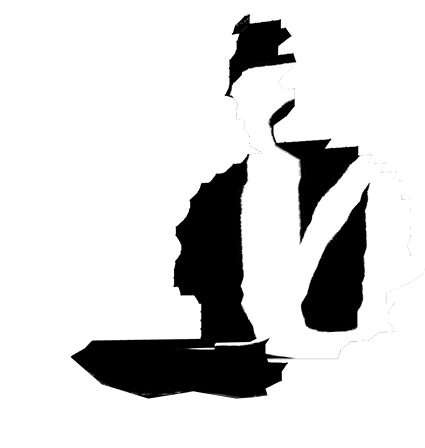
NB: It’s pronounced “open repo,” short for open repository.
RP: How does this project involve the local community as well as expand itself through the network to engage a more globally social reach?
NB: 0p3nr3p0 is at the moment a project that myself and Joseph Yolk Chiocchi maintain, an unfiltered, open port for uploading glitch art. It was an offspring of the GLI.TC/H conferences in 2010, 2011, and 2012 in Chicago. It was a result of our paranoia to be radically inclusive as a conference. So we didn’t do a call for works that last time, instead what we did was a call for threads, which is we tried to carve out spaces for other people to bring in certain conversations. And while we showed and exhibited work in the evening, all that work as best as we could was actually the result of those communities coming together. There is only so much space, there are only so many people who could show, but there are a lot of people online who we could recognize and include and so 0p3nr3p0 would become that back door entrance to the physical exhibition via the network.
RP: It seems to me that there is something about the nature of glitch that encourages democratization and inclusivity in terms of the accessibility of its practice and the techniques involved.
JS: It comes back to social structure. One way to get around the hierarchies of a social structure is to try and present things in a more populist, more open, more democratized way.
PH: There is also this transgressive aspect to glitch. Glitch itself represents a rupture, instability, of images and media. And that instability has an ideological function, as Nick is very careful to point out in the Glitch Codec Tutorial. If we are transgressing both the technology and exposing the ideology, there are reasons for us to want to expand that kind of rupture to online communities.
RP: I spoke with jonCates in an earlier interview for Hyperallergic about dirty new media. I would like to get your perspectives. Jon (Satrom), it seems like your work particularly reflects this idea as a reaction against the clean, glossy, polish of technology, a reaction against the fetish of the technological object.

JS: Yes, it is a reaction to the sleek, brushed metal of new technology. When I think of dirty new media in terms of Chicago, there is an organic quality to it, literally you can think about dirt. This dirty style: it’s the grit, it’s the rust, it’s the realization of a false promise of technology that many of us just accept and are fine with. We’re purchasing things that are broken and need updates, and yet our agency of not being part of these updates has been stripped from us. Things are changing under our feet all the time. With dirty new media, you don’t bother hiding the cords, you don’t bother sweeping up, there’s a sense of realism to it, there’s the grit, and there is also a kind of a comfort in that. It’s not trying to hide behind these mirrored surfaces.
RP: Perhaps it’s a critique of our relationship with technology in terms of humanizing that relationship.
NB: Maybe trying to take agency back in that relationship. In the computer industry, a very specific relationship has been imposed, we’re told how we’re supposed to use these things, both as consumers and as producers. As consumers we’re told this is what you are supposed to do with your technology, to have a kind of reverence for technology. Dirty new media is an irreverent response to that. And then as producers they’ve imposed a certain relationship. There are “right” ways to do things as programmers, and “right” ways to do things as media artists and dirty new media tends to be kind of punk: how can you finagle the technology. It’s through experimentation that you learn how to do things with these systems. And just like the punk ethic, once you learn those first three chords you can start a band and you’ll learn the rest of them along the way. Once the reverence is defused, and it’s OK to break things and experiment, all these things become possible.
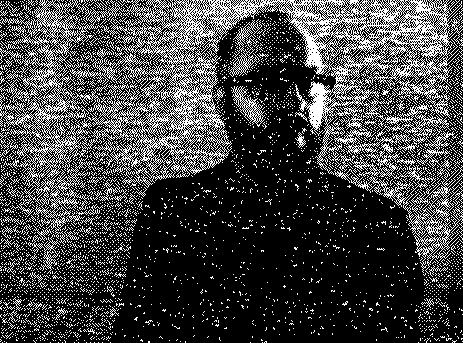
PH: I would also say there is a differentiation in dirty new media between an aesthetic and a capture of instability. There are the pleasures of the glitchy image but at the same time it’s very much about the underlying systems. It seems to me that they play off of one another and there is a certain tension there, and a healthy one.
RP: I believe there is also a tension in glitch in terms of constantly needing to move forward. This leads me to a question about Rosa Menkman, a significant artist and writer in the international glitch community. She’s written some very influential pieces such as The Glitch Moment(um) and the Glitch Studies Manifesto. Her writing critiques this tension while theorizing glitch, putting it into an art-historical perspective, perhaps encouraging its formalization. Is glitch now an actual genre, to be taught in art schools? What’s going on in Chicago seems very healthy because that’s where the locus of glitch is, but what happens when glitch is taught in all the other art schools around the world and everybody is imitating it?
JS: I think it becomes a powerful moment and I think it can be utilized very well in education, just in terms of giving students agency to break something and learn about its guts.
NB: But are you asking, what if glitch becomes a kind of Adobe Photoshop class? Here’s how you reproduce that exact artifact? Because that would be cool in its own sort of way if it happens, but I wouldn’t necessarily call that glitch art. You can perhaps draw a line between glitch artifacts and certain aesthetics and then glitch as a process, or as an ethic, as a practice, as an impetus for triggering these unexpected moments within systems for the plethora of reasons that artists like to do that. But glitch is not necessarily wedded to any particular aesthetic. Sure, if you search glitch art on Google, you get certain things that look the same, but that’s just because that’s what glitch art happens to look like now. But as technology and as systems change, and as the methods for exploiting those systems change, it will look, sound, taste, feel, and augment in totally different ways.
RP: So how do you feel about datamoshing, for example, which is working its way out into popular culture, where mainstream musicians, media artists are using glitch techniques straight out of the book.

PH: Kanye West’s Welcome to Heartbreak is the example most people think of. Datamoshing is used as a preset of a certain kind, which is OK, but it also means those problems were already solved. We know if we “hit” the header of a jpeg there are all kinds of things we can do. Once you go through the process, then it’s another effects module in a certain sense. But there is a point in which it’s all a surprise. Datamoshing is no longer a surprise for us, but it’s probably a surprise for nationwide television audiences. And even for them it’s going to eventually cease to be a surprise.
RP: Then what do you do in Chicago to stay on the edge, when everybody is practicing glitch?
NB: You can only stay on the edge if everybody is practicing glitch. The Kanye West example is a beautiful moment as initially I was upset because I felt co-opted, the pop culture aesthetic is going to destroy it. A lot of folks had that sort of sentiment and rhetoric. But the reality is that people are introduced to the aesthetic and look of glitch through that video and then are curious to know how to do that and then they fall down that rabbit hole. So more people join the conversation and like any conversation it gets better when more people join and there is more to talk about. And when everybody knows how to bend a jpeg, it means the general literacy level is up, the glitch literacy level is up. You can’t get into more complicated concepts, the next chapter, until everybody can have that conversation.
PH: And on the aesthetic side, it broadens the lexicons that people have to think about images, to think about media. It means that the aesthetics of punk, the aesthetics of noise creep in as something we should get used to. The popularization of glitch makes it possible to say, yes, we’re going to learn to live with the instability of technology, because we have to.

glitChicago: An Exhibition of Chicago Glitch Art, Ukranian Institute of Modern Art, with works by: Melissa Barron, Benjamin Berg aka Stallio, Nick Briz, jonCates, ChannelTWo, Joseph Yolk Chiocchi, Curt Cloninger, James Connolly, Kyle Evans, Paul Hertz, shawné michaelain Holloway, Nick Kegeyan, Jeff Kolar, A. Bill Miller, Pox Party, Rob Ray, Antonio Roberts, Alfredo Salazar-Caro, Jon Satrom, Lisa Slodki, Jason Soliday, Ben Syverson, I “heart” Presets, and OP3NR3PO.
Randall Packer is an artist, educator, and writer who critiques the unfolding media culture from his underground studio bunker in Washington, DC. Follow him at Reportage from the Aesthetic Edge.
JENIFA TAUGHT ME
CONSTANT Dullaart’s solo show Stringendo. Vanishing Mediators, Caroll/Fletcher.
Occupying both floors of the ultimate O’Doherty white cube of Carroll/Fletcher, Dullaart’s first solo UK survey show Stringendo, Vanishing Mediators consists of 27 works – many of them newly commissioned. The works have in common Dullaart’s pervasive aspirational tactic of queering and laying bare the architecture – both physical and virtual – of our networked yet doggedly analogue broadcast lives. Retaining a sense of sepia-tinted nostalgia for the Pong era Internet, many of the works in the show pay tongue-in-cheek homage to the revolutionary and democratic aspirations placed on the web at the beginning of its popular adoption – albeit primarily by white, male middle class Americans. Throughout the exhibition, Dullaart forensically tracks, seeds and traces remnants of our digital past and places them in direct dialogue with the power relations embedded in the terms and conditions of how these technologies have remediated the way we encounter and interpret our world now. This unveiling and excavating of the digital gesture – whether personal or brand mediated – and the freezing of the smoke and mirrors affect of software semantics isolated on the plinth of the gallery. It will be familiar ground for many of us in the business of the aestheticization of our precarious position as prosumers in surveillance society. However, as Dullaart lays bare the soft terrorism of the interface and the slowly encroaching disillusion of the clunky binary “digital” and the “physical”, he points towards a new way of visualising the architecture of our messy public/private, social/political pathological states of disarray by introducing The Balcony as a newly envisaged site of resistance and broadcast.

Stepping off the street and into Constant Dullaart’s recent solo show Stringendo, Vanishing Mediators at Carroll/ Fletcher on a sweltering summer afternoon I am immediately transported into a trippy AC’d noughties Snappy Snaps.

Dullaart’s signature, and now Guardian-famous, eponymous series Jennifer in Paradise acts as the hero image for the immersive world of blissfully glossy software-mediated wallpaper and slickly produced lenticular prints hanging in the entrance gallery. A Miami-hued display of software’s extensive lexicon of brushstrokes, filters and masks is flamboyantly demonstrated on the lonely yet aspirational image of a beautiful woman sitting on the beach looking out onto the tropical horizon. The promiscuous past of this image is well rehearsed; from its origins as a 1987 holiday snap – taken by co-creator of Photoshop John Knoll – to its use as crash test dummy for his ground-breaking popular software and its voracious adoption by the newly indoctrinated Photoshop masses as a subject of visual vivisection frames the staging of this exhibition. Dullaart’s archeological impulse to sniff out the rare software artefact of Jennifer points towards a general fetishization of the magic tipping point of the analogue/digital past –conjuring up a time when photography’s authenticity was still a battle to be fought. In a conversation with the artist at the appropriately ambiguous location of The Photographers Gallery shortly before his show opened, Dullaart emphasises the enduring pull of the image in his own practice. Describing the logic of the exhibition’s strategy, he sees the pasting of the Jennifer wallpaper as a “doubling” [1], or colonisation of his ongoing Jennifer experiment.
Dullaart’s Jennifer journey through the lexicon of data manipulation started when he embedded a secret stenographic message in the first re-appropriated images of Jennifer as a kind of “prize” for his growing online viral public. The first iteration(s) of Jennifer in Paradise explored the Internet’s opacity, highlighting the extent to which onscreen data is manipulated and controlled, enhanced or deformed. By celebrating and transporting the cyber-famous Jennifer into the gallery context in the form of selective editions, copies, or “abbreviations” of the digital, networked manipulation of the image, these artefacts act as both signifiers of the artists’ practice and as tempting photographic editions in their own right. A fact the artist is well aware of. However, the overarching social commentary implied in the freezing of this signifier of mass viral circulation is that the image became a coded Trojan horse for the prosumers’ 2.0 hypermarket as it was seeded, tracked mediated, remediated and mimetically distributed through the newly democratised digital commons.
It is in this mimetic gesture of versioning – a trope embedded in the very DNA of software development – that the artist does not just reference and make visible software’s surface gestures, but actually performs software’s versioning impulse, exposing it as a form of corporate cultural imperialism and spotlighting the newly negotiated role of authorship in the process. The artist’s persistent and persuasive disruption of the role of authorship is a common and recurring obsession running through his practice – from objects, to online queering of domain names, to his performances. A personal/impersonal example of this is played out in the exhibition by a row of seemingly innocuous family photographs. The series of family pictures from the 1980s are, according to Dullaart, the cleanest example of performative authorship. The photos were simply sent to Apple co-founder Steve Wozinak for him to sign and send back to the artist – resulting in the “re-authoring” of Dullaart’s childhood memories. This simple performance of capital control and authorship of so-called private identity is mainlined into Dullaart’s practice, and speaks to the artist’s core impulse: “this is exactly what I do – I take what isn’t public and I re-posses and reprocess these artefacts and re author them into a different spectrum”. [2]
In another act of ambiguous reverie of the commercial canon of software are the three pieces entitled Bill Atkinson demonstation drawing, (no.5, 12 and 18) hanging on the other side of the gallery, positioned against the Jennifer-tiled wallpaper. These drawings from the 23 stages of the first drawing made by Macpaint creator Bill Atkinson are printed in monochromatic hues sandwiched between photopolymer plates. These meticulously restored physical gestures of one of the first drawings executed by commercial software are particularly important for the artist. He sees this attempt at drawing made in the “strong consumer software” of Macpaint as a kind of totem or signifier of the emerging lexicon of the new canon in art history.

Beautiful fetishistic rubbery objects in themselves, the physicality of these works demonstrates the materially-dependent, performative intent in Dullaart’s practice. As these monochromatic objects react and change to UV light – hardening and cracking – any collector of his work needs to embrace the precarious temporality of the objects themselves. This is true of all of his work – including domain names, websites, his own online identity etc. and Dullaart emphasises that the conscious situating and staging of his works in the framework of time is one of the most vital components of his practice.
This animated relationship to instability and time- dependency is clearly demonstared in his player paino piece Feedback with Midi Piano Player at the heart of the exhibition. An algorithm interpreting polymorphic songs is played out through the grand piano in the gallery in an apparent circus-like celebration of the computer’s magical powers. However,as the recital unfolds, it is full of little mistakes – the songs are too complex for the computer to relay in a coherent feedback loop. For Dullaart, the inaccuracy and amateur quality of the computer/piano recital delivers a quasi -human quality of cuteness – an increasingly desirable quality in our popular technology, and an indication of the drive towards the synthetic anthropomorphism of digital objects and structures in general. This inevitably recalls Marx’s highly questionable use of anthropomorphizing comparisons of the commodity to children and women to underscore the “fetish character” [3] of commodities – the phantasmatic displacement of the sociality of human labour onto its products, as they appear to confront each other as if operating independent social lives of their own. In this sense, the “cuteness” in Dullaart’s piece might be seen as an intensification of commodity fetishism’s logic redoubled (like Jennifer) – as the viewer is connected to the unavoidable fantasy of fetishism, itself already an effort to find an imaginary solution to the irresolvable “contradiction between phenomenon and fungibility” [4] in the commodity form.

However, if this “cuteness” maintains fetishism’s overarching illusion of the object’s animate qualities – in this case the clumsy performance- at the same time it wants to deny what, in Marxian terms, these animated commodities articulate as “Our use-value may interest men, but is no part of us as objects…We relate to each other merely as exchange values.” [5]
Dullaart then shifts his attention to the main focus of the exhibition – the conscious construction and showcasing of his proposition of a new way of entering into a contract with our networked, hyper-published -selves: the balcony. The two physical balconies presented in Stringendo, Vanishing Mediators (one of which is accompanied by a digital ticker-tape text of his Balconism manifesto) are both visual prompts and, in a sense, demos, of Dullaart’s concept of balconisation. In direct acknowledgment of the hyper- mediated image of Julian Assange standing on the balcony of the Ecuadorian Embassy in London – Dullaart starkly illustrates this liminal, politically charged space where we bear witness to a clear slippage between UK and Ecuadorian territory. To Dullaart, the balcony represents a ‘space outside society’ [6], and this new space of public address marks a shift in responsibility in self-broadcast/publication in the digital commons and the social media sphere. According to Dullaart, we all need to recognise our position on the balcony in our hybrid public/private pathology and modus operandi of quasi-addictive self-broadcast.
On the balcony we should be ready to escape the warm enclosure of the social web, to address people outside our algorithm bubble. In the context of the show, the balcony is positioned as a higher order theory for how we should respond to the process of digitalisation as a whole, to how corporations and programmes structure our understanding of the world. We need to stand on our particular balcony ‘and choose to be out in public and we have to define cultural codes of how to do that’. [7]
What Dullaart’s exhibition Stringendo, Vanishing Mediators offers anew is an alternative proposition of spatial code through which to understand our steadily (re) negotiated locations of private and public space and the possibility of somewhere inbetween from which to enact a certain kind of everyday De Certeauian [8] tactic – the Balcony.
Dullaart’s solo exhibition ended at Carroll / Fletcher on 19th July 2014.
Jonas Lund’s artistic practice revolves around the mechanisms that constitute contemporary art production, its market and the established ‘art worlds’. Using a wide variety of media, combining software-based works with performance, installation, video, photography and sculptures, he produces works that have an underlying foundation in writing code. By approaching art world systems from a programmatic point of view, the work engages through a criticality largely informed by algorithms and ‘big data’.
It’s been just over a year since Lund began his projects that attempt to redefine the commercial art world, because according to him, ‘the art market is, compared to other markets, largely unregulated, the sales are at the whim of collectors and the price points follows an odd combination of demand, supply and peer inspired hype’. Starting with The Paintshop.biz (2012) that showed the effects of collaborative efforts and ranking algorithms, the projects moved closer and closer to reveal the mechanisms that constitute contemporary art production, its market and the creation of an established ‘art world’. Its current peak was the solo exhibition The Fear Of Missing Out, presented at MAMA in Rotterdam.
Annet Dekker: The Fear Of Missing Out (FOMO) proposes that it is possible to be one step ahead of the art world by using well-crafted algorithms and computational logic. Can you explain how this works?
Jonas Lund The underlying motivation for the work is treating art worlds as networked based systems. The exhibition The Fear Of Missing Out spawned from my previous work The Top 100 Highest Ranked Curators In The World, for which I assembled a comprehensive database on the bigger parts of the art world using sources such as Artfacts, Mutaul Art, Artsy and e-flux. The database consists of artists, curators, exhibitions, galleries, institutions, art works and auction results. At the moment it has over four million rows of information. With this amount of information – ‘big data’ – the database has the potential to reveal the hidden and unfamiliar behaviour of the art world by exploring the art world as any other network of connected nodes, as a systemic solution to problematics of abstraction.
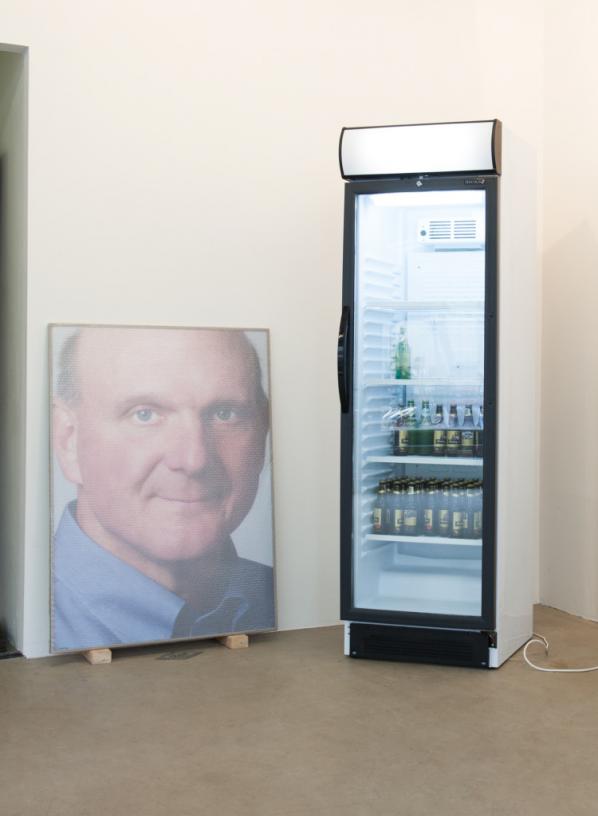
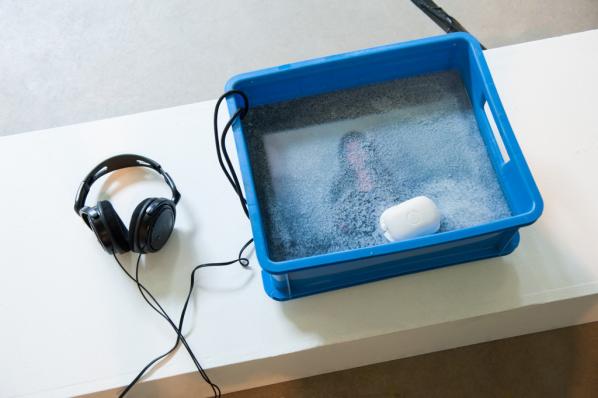
In The Top 100 Highest Ranked Curators In The World, first exhibited at Tent in Rotterdam, I wrote a curatorial ranking algorithm and used the database, to examine the underlying stratified network of artists and curators within art institutions and exhibition making: the algorithm determined who were among the most important and influential players in the art world. Presented as a photographic series of portraits, the work functions both as a summary of the increasingly important role of the curator in exhibition making, as an introduction to the larger art world database and as a guide for young up and coming artists for who to look out for at the openings.
Central to the art world network of different players lies arts production, this is where FOMO comes is. In FOMO, I used the same database as the basis for an algorithm that generated instructions for producing the most optimal artworks for the size of the Showroom MAMA exhibition space in Rotterdam while taking into account the allotted production budget. Prints, sculptures, installations and photographs were all produced at the whim of the given instructions. The algorithm used meta- data from over one hundred thousand art works and ranked them based on complexity. A subset of these art works were then used, based on the premise that a successful work of art has a high price, high aesthetic value but low production cost and complexity, to create instructions deciding title, material, dimensions, price, colour palette and position within the exhibition space.
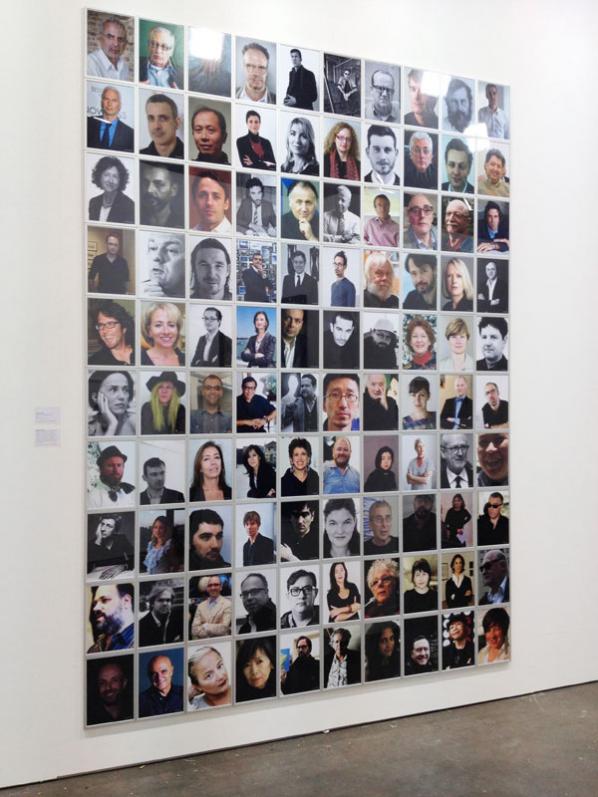
Similar to how we’re becoming puppets to the big data social media companies, so I became a slave of the instructions and executed them without hesitation. FOMO proposes that it is possible to be one step ahead of the art world by using well-crafted algorithms and computational logic and questions notions of authenticity and authorship.
AD: To briefly go into one of the works, in an interview you mention Shield Whitechapel Isn’t Scoop – a rope stretched vertically from ceiling to floor and printed with red and yellow ink – as a ‘really great piece’, can you elaborate a little bit? Why is this to you a great piece, which, according to your statement in the same interview, you would not have made if it weren’t the outcome of your analysis?
JL: Coming from a ‘net art’ background, most of the previous works I have made can be simplified and summarised in a couple of sentences in how they work and operate. Obviously this doesn’t exclude further conversation or discourse, but I feel that there is a specificity of working and making with code that is pretty far from let’s say, abstract paintings. Since the execution of each piece is based on the instructions generated by the algorithm the results can be very surprising.
The rope piece to me was striking because as soon as I saw it in finished form, I was attracted to it, but I couldn’t directly explain why. Rather than just being a cold-hearted production assistant performing the instructions, the rope piece offered a surprise aha moment, where once it was finished I could see an array of possibilities and interpretations for the piece. Was the aha moment because of its aesthetic value or rather for the symbolism of climbing the rope higher, as a sort of contemporary art response to ‘We Started From The Bottom Now We’re Here’. My surprise and affection for the piece functions as a counterweight to the notion of objective cold big data. Sometimes you just have to trust the instructionally inspired artistic instinct and roll with it, so I guess in that way maybe now it is not that different from let’s say, abstract painting.
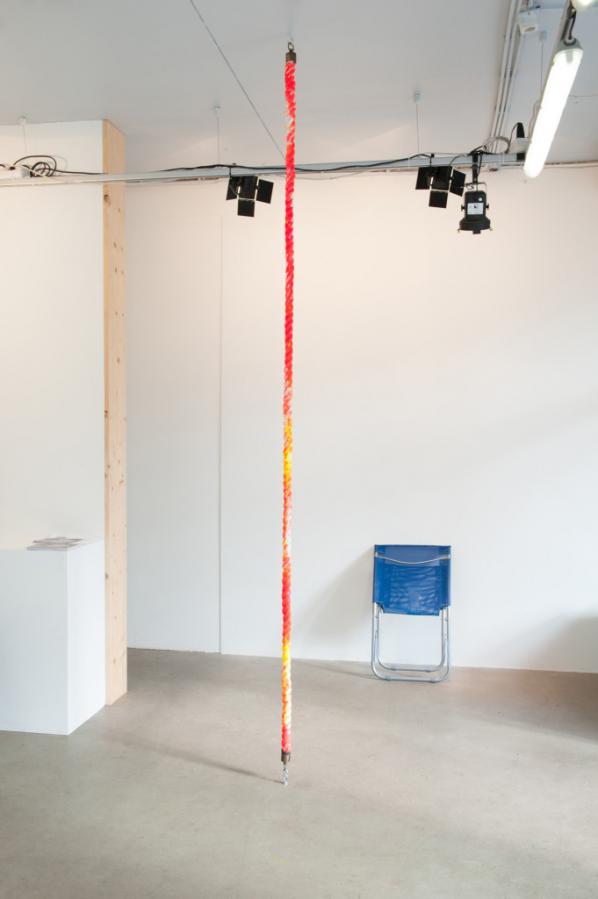
AD: I can imagine quite a few people would be interested in using this type of predictive computation. But since you’re basing yourself on existing data in what way does it predict the future, is it not more a confirmation of the present?
JL: One of the only ways we have in order to make predictions is by looking at the past. Through detecting certain patterns and movements it is possible to glean what will happen next. Very simplified, say that artist A was part of exhibition A at institution A working with curator A in 2012 and then in 2014 part of exhibition B at institution B working with curator A. Then say that artist B participates in exhibition B in 2013 working with curator A at institution A, based on this simplified pattern analysis, artist B would participate in exhibition C at institution B working with curator A. Simple right?
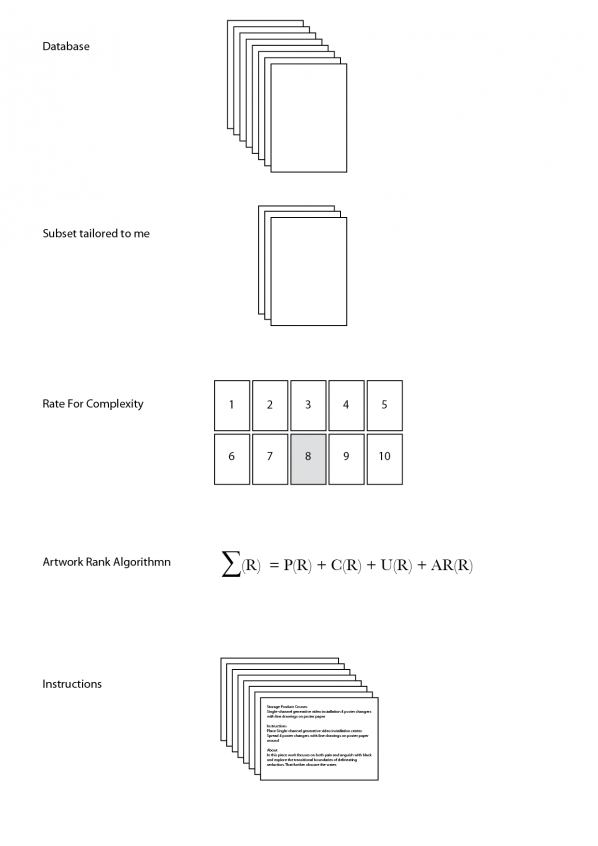
AD: In the press release it states that you worked closely with Showroom MAMA’s curator Gerben Willers. How did that relation give shape or influenced the outcome? And in what way has he, as a curator, influenced the project?
JL: We first started having a conversation about doing a show in the Summer of 2012, and for the following year we met up a couple of times and discussed what would be an interesting and fitting show for MAMA. In the beginning of 2013 I started working with art world databases, Gerben and I were making our own top lists and speculative exhibitions for the future. Indirectly, the conversations led to the FOMO exhibition. During the two production phases, Gerben and his team were immensely helpful in executing the instructions.
AD: Notion of authorship and originality have been contested over the years, and within digital and networked – especially open source – practices they underwent a real transformation in which it has been argued that authorship and originality still exist but are differently defined. How do see authorship and originality in relation to your work, i.e. where do they reside; is it the writing of the code, the translation of the results, the making and exhibiting of the works, or the documentation of them?
JL: I think it depends on what work we are discussing, but in relation to FOMO I see the whole piece, from start to finish as the residing place of the work. It is not the first time someone makes works based on instructions, for example Sol LeWitt, nor the first time someone uses optimisation ideas or ‘most cliché’ art works as a subject. However, this might be first time someone has done it in the way I did with FOMO, so the whole package becomes the piece. The database, the algorithm, the instructions, the execution, the production and the documentation and the presentation of the ideas. That is not to say I claim any type of ownership or copyright of these ideas or approaches, but maybe I should.
AD: Perhaps I can also rephrase my earlier question regarding the role of the curator: in what way do you think the ‘physical’ curator or artist influences the kind of artworks that come out? In other words, earlier instructions based artworks, like indeed Sol LeWitt’s artworks, were very calculated, there was little left to the imagination of the next ‘executor’. Looking into the future, what would be a remake of FOMO: would someone execute again the algorithms or try to remake the objects that you created (from the algorithm)?
JL: In the case with FOMO the instructions are not specific but rather points out materials, and how to roughly put it together by position and dimensions, so most of the work is left up to the executor of said instructions. It would not make any sense to re-use these instructions as they were specifically tailored towards me exhibiting at Showroom MAMA in September/October 2013, so in contrast to LeWitt’s instructions, what is left and can travel on, besides the executions, is the way the instructions were constructed by the algorithm.
AD: Your project could easily be discarded as confirming instead of critiquing the established art world – this is reinforced since you recently attached yourself to a commercial gallery. In what way is a political statement important to you, or not? And how is that (or not) manifested most prominently?
JL: I don’t think the critique of the art world is necessarily coming from me. It seems like that is how what I’m doing is naturally interpreted. I’m showing correlations between materials and people, I’ve never made any statement about why those correlations exist or judging the fact that those correlations exist at all. I recently tweeted, ‘There are three types of lies: lies, damned lies and Big Data’, anachronistically paraphrasing Mark Twain’s distrust for the establishment and the reliance on numbers for making informed decisions (my addition to his quote). Big data, algorithms, quantification, optimisation… It is one way of looking at things and people; right now it seems to be the dominant way people want to look at the world. When you see that something deemed so mysterious as the art world or art in general has some type of structural logic or pattern behind it, any critical person would wonder about the causality of that structure, I guess that is why it is naturally interpreted as an institutional critique. So, by exploring the art world, the market and art production through the lens of algorithms and big data I aim to question the way we operate within these systems and what effects and affects this has on art, and perhaps even propose a better system.
AD: How did people react to the project? What (if any) reactions did you receive from the traditional artworld on the project?
JL: Most interesting reactions usually take place on the comment sections of a couple of websites that published the piece, in particular Huffington Post’s article ‘Controversial New Project Uses Algorithm To Predict Art’. Some of my favourite responses are:
‘i guess my tax dollars are going to pay this persons living wages?’
‘Pure B.S. ……..when everything is art then there is no art’
‘As an artist – I have no words for this.’
‘Sounds like a great way to sacrifice your integrity.’
‘Wanna bet this genius is under 30 and has never heard of algorithmic composition or applying stochastic techniques to art production?’
‘Or, for a fun change of pace, you could try doing something because you have a real talent for it, on your own.’
AD: Even though the project is very computational driven, as you explain the human aspects is just as important. A relation to performance art seems obvious, something that is also present in some of your other works most notably Selfsurfing (2012) where people over a 24 hour period could watch you browsing the World Wide Web, and Public Access Me (2013), an extension of Selfsurfing where people when logged in could see all your online ‘traffic’. A project that recalls earlier projects like Eva & Franco Mattes’ Life Sharing (2000). In what way does your project add to this and/or other examples from the past?

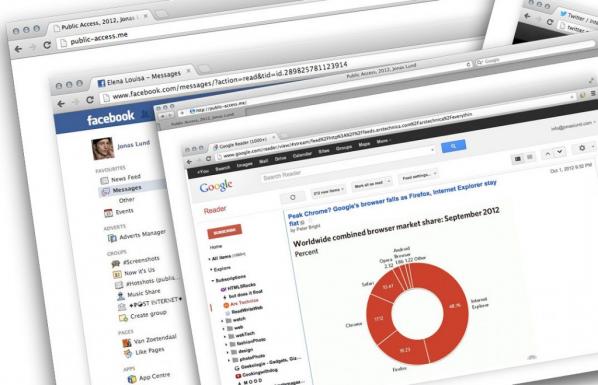
JL: Web technology changes rapidly and what is possible today wasn’t possible last year and while most art forms are rather static and change slowly, net art in particular has a context that’s changing on a weekly basis, whether there is a new service popping up changing how we communicate with each other or a revaluation that the NSA or GCHQ has been listening in on even more facets of our personal lives. As the web changes, we change how we relate to it and operate within it. Public Access Me and Selfsufing are looking at a very specific place within our browsing behaviour and breaks out of the predefined format that has been made up for us.
There are many works within this category of privacy sharing, from Kyle McDonalds’ live tweeter, to Johannes P Osterhoff’s iPhone Live and Eva & Franco Mattes’ earlier work as you mentioned. While I cannot speak for the others, I interpret it as an exploration of a similar idea where you open up a private part of your daily routine to re-evaluate what is private, what privacy means, how we are effected by surrendering it and maybe even simultaneously trying to retain or maintain some sense of intimacy. Post-Snowden, I think this is something we will see a lot more of in various forms.
AD: Is your new piece Disassociated Press, following the 1970s algorithm that generated text based on existing texts, a next step in this process? Why is this specific algorithm of the 70s important now?

JL: Central to the art world lies e-flux, the hugely popular art newsletter where a post can cost up to one thousand dollars. While spending your institution’s money you better sound really smart and using a highly complicated language helps. Through the course of thousands of press releases, exhibition descriptions, artist proposals and curatorial statements a typical art language has emerged. This language functions as a way to keep outsiders out, but also as a justification for everything that is art.
Disassociated Press is partly using the Dissociated Press algorithm developed in 1972, first associated with the Emacs implementation. By choosing a n-gram of predefined length and consequently looking for occurrences of these words within the n-gram in a body of text, new text is generated that at first sight seems to belong together but doesn’t really convey a message beyond its own creation. It is a summary of the current situation of press releases in the international English art language perhaps, as a press release in its purest form. So, Disassociated Press creates new press releases to highlight the absurdity in how we talk and write about art. If a scrambled press release sounds just like normal art talk then clearly something is wrong, right?
The end of boom and bust ended with the credit crunch. Following the global financial crisis of 2008, the Eurozone crisis has produced technocracy and poverty rather than democracy and wealth. Reactions to these failures of monetary policy are informed by technology as never before, from austerity being imposed thanks to an Excel spreadsheet bug to the rise of the anti-statist cryptographic currency of Bitcoin.
Against this backdrop of monetary failure and technological critique, _MON3Y AS AN 3RRROR | MON3Y.US is an ambitious online survey of net art depictions and critiques of money and its institutions curated by the pseudonymous curator “Vasily Zaitsev”. As well as the work from 70 or so artists invited to participate an open call for work increased the number of pieces in the show in total to around 200. I only consider the invited artists here, but the work in the open call section is well worth looking at as well.
The show web site has a simple HTML interface, starting with a single image and a pull-down menu of other works. Disable your pop-up blocker and you’re ready to start.
Miron Tee’s “Shame” is the image that fronts the show, an image of a dollar modified to show George Washington peering out nervously from behind the oval frame in the center.
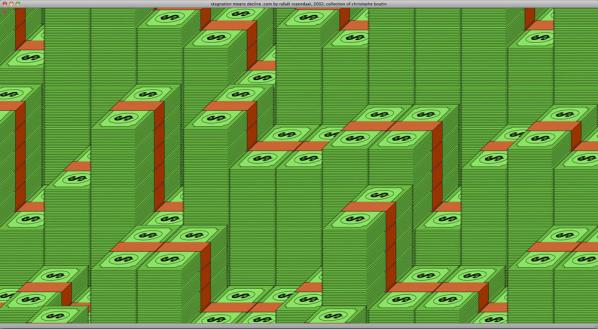
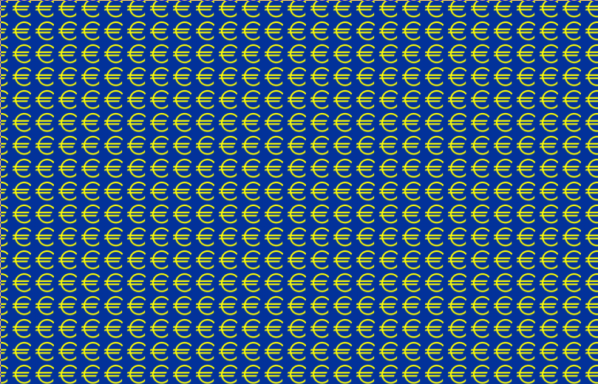
Dominik Podsiadly’s “Joy to ide” starts the pull-down menu with a flowing grid of Euro signs on a blue background to the sound of “Ode To Joy” playing backwards. It’s an all-over, closed temporal loop of the kind that animated GIFs exemplify and encourage, the Euro falling forever.
Nuria Güell’s “How to expropriate money from the banks” is a more direct action based work of culture jamming explaining presented in a well laid out document in the style of HSBC’s First Direct brand.
Paolo Cirio’s “Loophole for All” makes offshore tax havens, those loopholes in taxation regimes that allow corporations and the super-rich to avoid repaying society, available to everyone through a web site interface.
Rafaël Rozendaal’s “Stagnation Means Decline” is a screenful of geometric pixel-art dollar bill stacks that fill the screen with their edges only to be obscured by new columns like an economic game of Life.
Filipe Matos’s “Crash” is an undulating animated monochrome concrete poetry American flag with the stars made from the letters of “me” and the stripes as “you”.
Adam Ferriss’s “paper$hredder” is a Vimeo video clip of American dollar bills speeding by faster and faster until they dissolve into a blur.
Aaron Koblin + Takashi Kawashima’s “Ten Thousand Cents” is a composite image of a hundred dollar bill crowdsourced by paying people a cent to paint each piece through Amazon’s Mechanical Turk service.
Maximilian Roganov’s “When the Mao was small, he worked for CIA” is a looped animated GIF colour 3D scan of a dollar bill, polygonally glitched or possibly crumpled over time.
Dave Greber’s “Self Portrait With Dog” video is aptly titled, apparently taking place as the custom graphic on a Visa Mastercard.
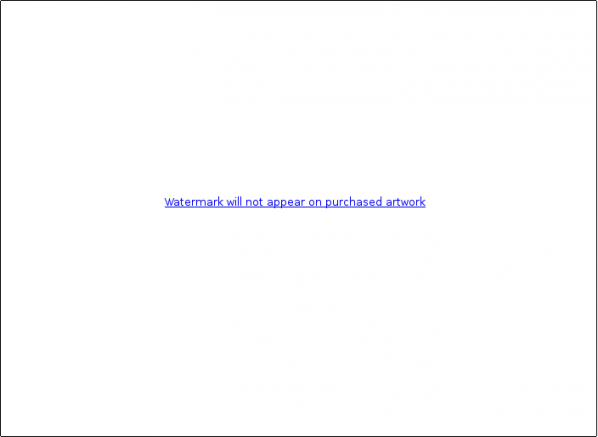
Agente Doble | UAFC’s “Watermark will not appear on purchased artwork” is a million dollar blank artwork if you email them and purchase it, otherwise it’s just a url on a blank web page.
JUST DO IT’s “Fifty Euros Inside/Fifty Euros Outside” are animated GIF loops of fifty Euro notes pulsating as if to sound waves on an oscilloscope.
Mitch Posada’s “$$$” is a Flash video of Silicon Graphics-era-style VR models of skeletons exploding and morphing into their constituent polygons while texture mapped with Deutschmarks.
Emilio Vavarella’s “Money Complex” is a tube map-style world map with banknote-collage continents and a key for numeric labels that can be zoomed in on by moving the mouse to reveal their often incongruous labels. It’s one of the more complex works in the show art historically and conceptually.
Lorna Mills & Yoshi Sodeoka’s “Money2” is a Vimeo video loop collage of roughly extracted elements from videos of commodity fetishism, fire and death.
Fabien Zocco’s “Cloud” is a generative composition of black dollar signs scattered up over a yellow background over time like a plume of smoke.
Jasper Elings’s “Territory” is an animated GIF loop of a dollar bill flag blowing in the roughly simulated wind on a white background. It’s not the only such piece in the show.
Robert B. Lisek’s “FuckinGooglExperiment” is online statistical analysis code that tries to correlate the change in Google’s stock price with changes in their PR strategy. It also uses the excellent Fluxus livecoding environment.
Alfredo Salazar Caro | TMVRTX’s “How to make money on internet remix” is a tightly tiled video loop of a rotating stack of dollar bills in a lava-lite-like flow of colour psychedelia.
Anthony Antonellis’s “How to make money on the internet” is simply that rendered block of spinning virtual hundred dollar bills, plucked from the era of RenderWare and VRML.
Gustavo Romano’s “Pieza Privada #1” is another piece of net art for sale at a specific price, with a carefully described contract and application form.
Tom Galle’s “One Million Dollars For iPhone” is an app available on the iTunes Store that allows you to count a virtual million dollar wad on your iPhone.
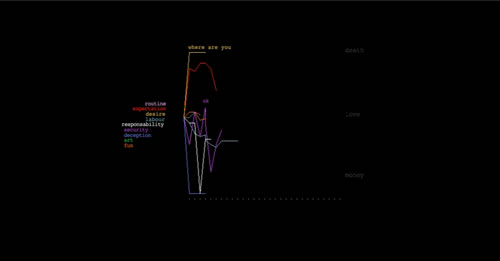
Geraldine Juarez’s “Love Not Money” tracks the associations of various words with “death”, “love” and “money”. I had to Google this one: it’s a Processing visualisation of a personal stock market tracking the artist’s conceptual assets over six weeks. I love it.
Nick Kegeyan’s “C.R.E.A.M. (Cash Romney Eat A Lot of Money)” is simple, direct and effective video burst of an American news interview subject morphing into a cloud of falling texture mapped dollar bills.
Dafna Ganani’s “Apple Dollar Explosion” is another descriptively titled piece, a Maya-looking apple texture mapped with a dollar bill spinning against a grey background then exploding into its constituent polygons.
Haydi Roket’s “$” takes a dollar bill portrait and literally deconstructs it by pixelating it in increasingly primitive ways, first as 4-bit grey patterns, then in monochrome ANSI characters, alternating to inverse video and changing the contrast to give a flickering effect.
Jennifer Chan’s “Infinite Debt” is a video of a twenty Euro not being dipped in batter and fried mixed in with a collage of clipart images and video on the cynical economics of contemporary art and consumerism.
Frère Reinert’s “Money as a waste of time” is a deliberate excercise in futility; a blurred, zoomed in silent video of the MacOS X SBOD on a white backdrop.
Cesar Escudero’s “Captura de pantalla 2013-03-08 a las 21.46.23” is a Mac OS X desktop image of a gas masked protester who appears to be reaching for a folder named “$$$$$$$”.
Jefta Hoekendijk’s “Money Is Data” is an animated GIF loop of a glitchily texture mapped virtual fifty Euro note in artificial colours.
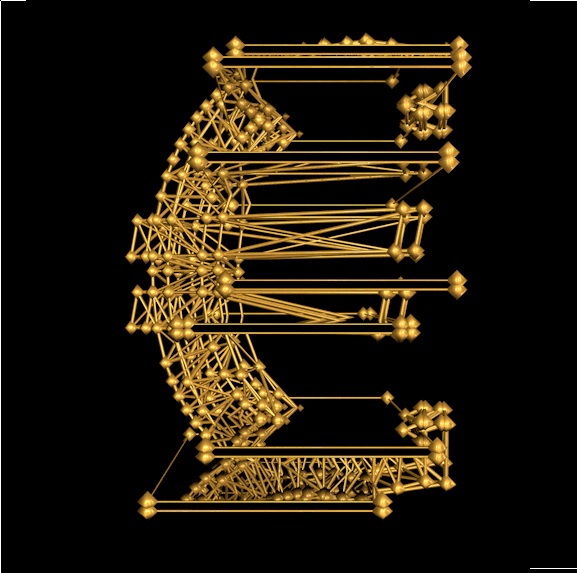
V5MT’s “¥€$ or N0T” is a rap video or Designers republic album cover-style animation of monumental metal morphing currency symbols made from struts and spheres like newton’s cradles or molecular diagrams.
Addie Wagenknecht’s “How To Make $$$$$” is a grid of money counterfeiting video tutorials, which are apparently a genre. Playing all at the same time they become an all-over aesthetic rather than incitement to a crime.
Gusti Fink’s “infinite loop of money drowning in water oil” is a slow, monumental simulation of a platinum visa card sliding into dark liquid that the camera pans over as if it were a sinking ship.
Marco Cadioli’s “You are here” shows globe and landscape maps constructed of dollar bills, with a pin or map icon to show your place in the economy.
Keigo Hara’s “Making Of Fake Bills” is more halftoned (or possibly shape grammared) dollar bills.
Jan Robert Leegte’s “Currency Graph” shows European flag yellow bars over a European flag blue gradient background. It’s a mutated and abstracted evocation of news information graphics aesthetics in CSS and JavaScript.
Ellectra Radikal’s “Disolved €uro” is a flickering autotraced, find edged and glitched animated zoom into a hundred Euro note that renders it spatial and architectural.
Paul Hertz’s “5,000,000$” it the purest glitch art piece in the show, rows of corrupted and miscoloured banknote imagery that looks like nothing so much as classic street art.
Aoto Oouchi’s “It’s all good” is an uncanny New Aesthetic 3d rendering of liquid or possibly mirrored texture mapped banknotes pouring from a wall.
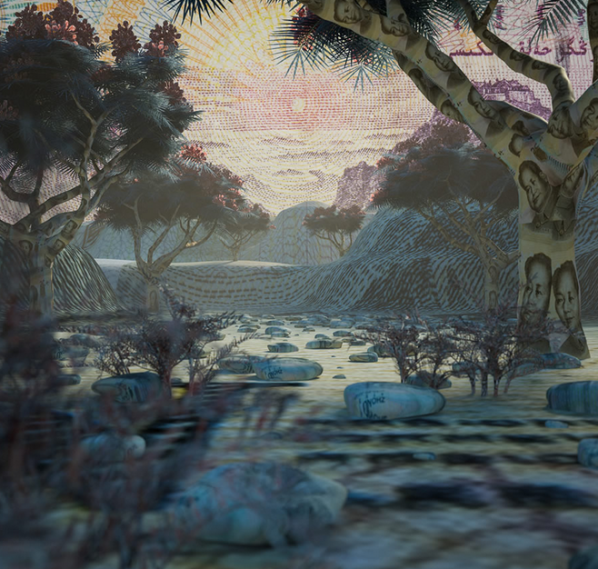
Kim Laughton’s “Landscape” is a rendered and collaged landscape of banknotes, resembling nineteenth century engravings of dramatic landscapes thanks to the inconography and texture of its source material.
Andrey Keske’s “Tell Me What You Want” is a search engine-style text box prompt that shows the economic coercion inherent in neoliberal use of technology by only allowing you to finish one word beginning with “M”.
A Bill Miller’s “3xpl0d3m0n3y” combines a grainy analogue glitch aesthetic explosion of a dollar bill into waveform stripes into a black space of drifting Matrix-green dollar signs.
Martin Kohout’s “Watching $100 Note Unveiling Video” has a ChatRoulette look, with the unseen unveiling causing a small smile to break out on the depicted viewer’s otherwise affectless face.
Marc Stumpel’s “pH0r 7|-|3 L0\/3 0Ph /\/\0|\|3’/” is a glitched and colourised monochrome television popular music performance from the age of mass media. Again I had to Google it but the song is ‘For the love of money’ by The O’Jays.
Benjamin Berg’s “$(0x24)” (the hexadecimal number that represents the dollar sign in ASCII) is a colourful and stripy glitch animation that resembles test cards, 8 and 16 bit graphics, and even woodcut as it breaks down.
LaTurbo Avedon’s “$$$$$$$$$$$$$$$$$$$$$” is an ambient modern html5 animtion of the avatar-artist reclining on money texture-mapped couches floating up and down a Google image search page for the word “millions”.
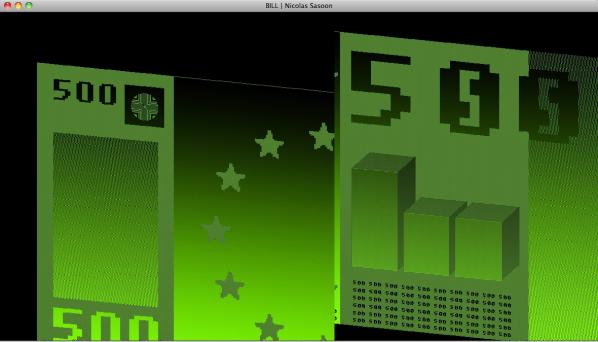
Nicolas Sassoon’s “BILL” is a flickering green screen terminal or slow scan TV-style rendering of a 500 Euro note that plays with the visual language of digital images: the letters and stars are highly pixellated but the backdrop to them is a smooth gradient.
Curt Cloninger’s “i want KANDY” loops images of a dancing sniper camouflaged figure montaged with dollar bills and fruit over a more slowly changing background collage of the american flag, a dollar bill, and fruit making a post MTV-styleguide image of the military-economic-entertainment complex.
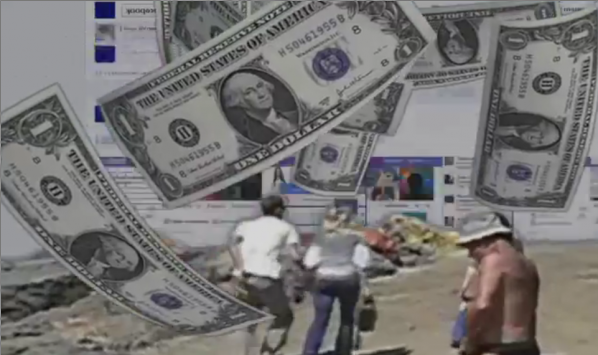
Systaime’s “ʞooqǝɔɐɟ Dollars” video portrays a world where curvily rendered dollar bills rain over an amateur video of tourists at a beach with a sky of quickly cycling Facebook pages.
Erica Lapadat-Janzen’s “Money Troubles” is a PhotoShop Pop Dada montage of exploitatively normative female beauty and monetary and drug excess that subverts the imagery of the fashion pages.
Milos Rajkovic’s “Mind Wheel” is a wonderfully Gilliamesque collaged animation depicting a mental wage labourer.
Émilie Brout & Maxime Marion’s “Cutting Grass” depicts the pointless and trivial labour that video games such as “The Legend Of Zelda force players to engage in for unrealistic rewards such as gold coins and rubies so they can get on with their quest.
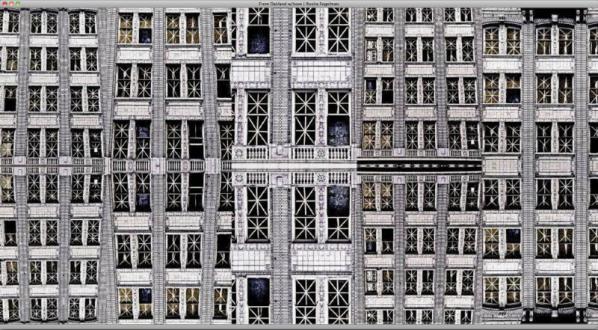
Rozita Fogelman’s “From Oakland w/Love” is a point-and-click kaleidoscopic archtitectural portrait of gentrified Bay Area architecture.
Georges Jacotey’s “am I enough political now” is a Chatroulettish video selfie of an augmented reality Euro flag and symbol drawing and dancing session.
Δεριζαματζορ Προμπλεμ Ιναυστραλια’s “Major Problem” is a rendering of a stack of dollar bills as seen through heat haze or under water, rippling and undulating against a white background.
Lars Hulst’s “0 €uro” is a rendering of a zero Euro note.
Nick Briz’s “a return to secularism” is a video documentary of twenty dollar bills being printed with the words “a return to secularism” flashing over it, framed by a repeated loop of the words “in God we trust” being crossed out on a dollar bill where they were added in the 1950s.
Jon Cates’s “MØN3¥-Δ$-3ɌɌɌØɌ” is a Classic Mac monochrome bitmap or fax aesthetic PDF essay for the show and an exposure of the print on demand economics of that essay in the same style.
León David Cobo’s “Conversation With Machine” has a 1990s broadcast graphic feel, showing the soundwaves of the feedback of a conversation with Siri asking it for money in Euro blue and yellow.
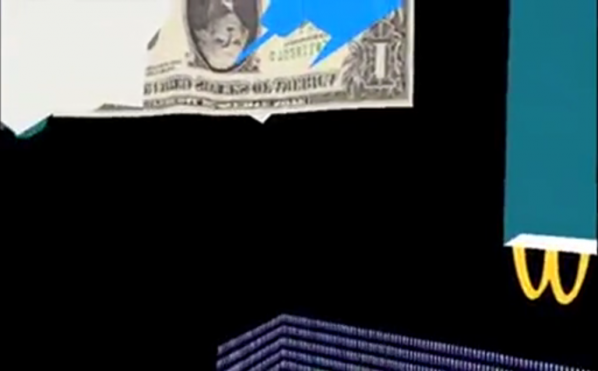
Guayayo Coco’s “Money | GLıɫcʜ ᴬᴺᴰ GLıɫɫɛʀ” is a video of a journey through a VRML-style virtual environment of discrete polygonal objects texture mapped with dollar bills, corporate logos and more abstract patterns with a radio channel-surfing soundtrack.
Vince Mckelvie’s “MONEY” is a reactive interactive deconstruction of a hundred dollar bill into a grid that reacts to the viewers’ mouse movement, revealing pulsating colours behind. It’s a good example of how suitable html5 is for this kind of thing.
Ciro Múseres’s “YOU HAVE WON” is a classic net.art style HTML bomb of overlaid text and links with content from financial web sites such as Barclays, Halifax and Santander that continuously adds and removes layers in different shades red, black, blue and green text to make new compositions.
Adam Braffman’s “Money Loading” is an animated GIF of the frame of a 100 dollar bill with a “Loading…” speech bubble in the centre. It makes the show’s themes of absent and delayed wealth more obviously explicit.
Rollin Leonard’s “Portrait of a NetArtist” is an two-frame animated GIF of the artist naked in the bath with bundles of fake hundred dollar bills with which they are lighting their cigar.
Thomas Cheneseau’s “100€ sequence” is a grid of glitched sections of a hundred Euro note that moires with colour as you scroll it. There’s a link to the facebook album that constitutes the actual work, and it works much better as a clickable album than as a static single image.
Yemima Fink’s “This is not money” is an abstract postmodernist collage of graphical quotations from the counterfeit-resisting elements of banknotes that is both witty and a very effective defamiliarisation of the iconography of banknotes and the power that they represent.
Mathieu St-Pierre’s “Untitiled” is a glitched jpeg of a dollar bill that in its straightforward application of glitch aesthetics makes the most direct link between them and the economic “glitch” of 2008.

Kamilia Kard’s “Amazon VIP girls” is the lone tumblr in the show, with an aesthetic that is either post-internet or pre-Google depending on how old you are applied to the supposedly perfect clothing models used by web sites.
José Irion Neto’s “Untitled” is a glitched banknote that turns JPEG artefacts into Klimt patterns.
There are definite historical trends and formal themes within the included work. Polygonal, texture-mapped, 90s-style VR-style objects that spin or explode. Net art and functional web sites that track or create financial and legal entities and transactions. Looped animations of textures, rendered flags, or video detournements. The imagery of accumulation, consumption, and destruction, always ironically. Imagery and symbols presented in simple loops fast or slow for contemplation. Graphs and maps of real and imagined economic signifiers.
In terms of genre, _MON3Y AS AN 3RRROR | MON3Y.US includes classic VR and video art, more modern GIF loops, textual and institutional net.art, glitch art, even some New Aesthetic. The language of computer graphics, texture mapping and polygons, allows the imagery of banknotes to be defamiliarised and deconstructed. Less often, personal experience and iconography displace the cultural imagery of wealth, consumption and debt.
This historical, formal and genre coverage of the variety of artworks included in the show comprehensively illustrates the chosen theme of “money and error”. This creates its own genre and lineage for the included artworks, which gain by comparison to their newly identified peers. They also contribute to the social and economic critique of the show. It’s a very successful balancing act, which the simple interface and presentational strategy of the show’s curation are key to achieving.
_MON3Y AS AN 3RRROR | MON3Y.US is an almost overwhelmingly successful in its comprehensive review of net art’s critical depiction of and engagement with money. By taking a technologically simple but historically, conceptually and logistically ambitious approach to net.curation for net.art it demonstrates the effectiveness and lasting value of net art’s contributions in this area and the power of online thematic curation to draw together and contextualise this value without giving in to the often perceived need for offline institutional underwriting.
LIVE LINK HERE
In collaboration with Annie Abrahams and Emmanuel Guez, Furtherfield presents two new ReadingClub sessions based on excerpts from McKenzie Wark’s A Hacker Manifesto [version 4.0] and the ARPANET dialogues.
ReadingClub proposes a text and an interpretive arena to 4 readers. These readers write together their reading of a text inside the text itself. The audience sees an evolving, cinematographic picture of thoughts and collaborative writing in the making.
Join the performance online at readingclub.fr and use the chat window to exchange, discuss and comment on the performance.
Monday 21 October 2013, 8pm London Time – A Hacker Manifesto [version 4.0]
Online performance session based on an excerpt from A Hacker Manifesto [version 4.0] by McKenzie Wark – with Aileen Derieg, Cornelia Sollfrank, Dmytri Kleiner and Marc Garrett.
Drawing in equal measure on Guy Debord and Gilles Deleuze, A Hacker Manifesto offers a systematic restatement of Marxist thought for the age of cyberspace and globalization. In the widespread revolt against commodified information, McKenzie Wark sees a utopian promise, beyond the property form, and a new progressive class, the hacker class, who voice a shared interest in a new information commons.
Tuesday 22 October 2013, 8pm London Time – The ARPANET dialogues
Online performance session based on an excerpt of the ARPANET dialogues from 1975-1976 – with Alessandro Ludovico, Jennifer Chan, Lanfranco Aceti and Ruth Catlow.
The ARPANET dialogues is an archive of rare conversations within the contemporary social, political and cultural milieu convened between 1975 and 1979 that were conducted via an instant messaging application networked by computers plugged into ARPANET, the United States Department of Defense’s experimental computer network. All participants in the conversation were given special access to terminals connected to ARPANET, many of them located in US military installations or DOD-sponsored research institutions around the world.
What was originally thought to be a historic moment, when figures from within and without the established art canon first encountered the disruptive effects of digital network communications, turned out to be an ongoing research project by Bassam El Baroni, Jeremy Beaudry and Nav Haq.
Further reading:
“This pre-Internet chatroom conversation between Jim Henson, Ayn Rand, Yoko Ono and Sidney Nolan is fake. But it’s amazing” – Robert Gonzalez in io9, December 2012.
“Ronald Reagan has joined the chatroom” – Interview by Richard Fischer, CultureLab with Jeremy Beaudry, one of the artists behind the project, April 2011.
The ReadingClub is a project by Annie Abrahams and Emmanuel Guez, inspired by Brad Troemel’s Reading Group and the Department of Reading by Sönke Hallman.
The project is supported by Dicréam.
+ More information about ReadingClub
“a symbol of indeterminate meaning, floating/rotating into the empty white WAG room with no viewers” Bill Miller
Widget Art Gallery. July 17th – August 17th 2013.
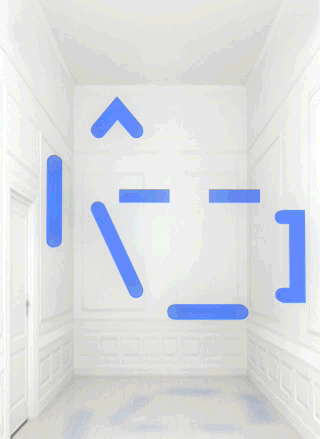
Chiara Passa’s Widget Art Gallery (WAG) has been serving art online since 2009. Named for the ability to install the contents of its web pages as a Mac OS X “dashboard widget” or iOS icon, it presents virtual art objects against a standard backdrop or in a standard virtual environment that looks like a white-painted townhouse room repurposed as a small gallery space in an exclusive part of town.
The instructions for using the WAG are Apple hardware-centric, and as I don’t have an Apple device I had to cheat and view it on my GNU/Linux desktop. Digital art’s medium specificity consists in part of its reliance on the facilities of particular hardware and operating systems. This can be exclusive, not everyone owns Apple hardware, but it can also be realistic, Apple’s hardware currently defines computing in the popular imagination.
The image of the gallery in the widget, like the image of a leather desk organizer or a wire mesh microphone in an mobile app, or the very idea of “the desktop” in a desktop GUI, it is a skeuomorph. It is a non-functioning symbolic form that cues the viewer in to the affordances that the experience of the software offers. Like the white cube of a real art gallery, it frames the experience of looking at the artwork and emphasises its seriousness, value, and singularity.
From July to August 2013 the work inhabiting this virtual space is Bill Miller’s “A Symbol“. The titular icon is a composition of soft light blue graphic elements that look like ASCII art that are not aligned to a teletype grid. Or like a misaligned LED matrix. It evokes the art of early military computer games, or the more complex emoticons, or maybe a lamp or a teapot. It rotates, blurs, flickers and stops, glitching and returning.
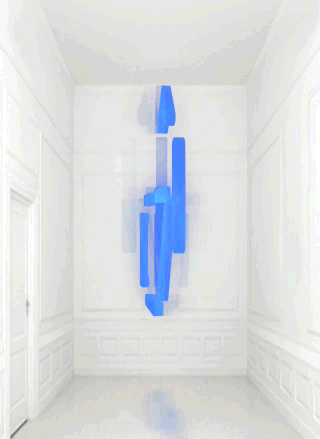
Widget Art Gallery installations are presented as animated GIFs, but they are different from the usual hilarious recuperations of Compuserve’s low-bandwidth image format in their lack of all-overness and of mass media appropriation. Animated GIFs are often glitched, but with “A Symbol” it is the object depicted in the animated image that is glitching, not the image itself.
The rotating symbol used to be a staple of broadcast television identities. The flickering or glitching symbol signifies signal hacking, technical difficulties, or coming into or out of being by teleportation or rezzing. Popular culture reactions to technology emphasize its flaws and failures to make its smooth surfaces tractable to the imagination. But this symbol remains opaque and self-assured, always returning to its original state.
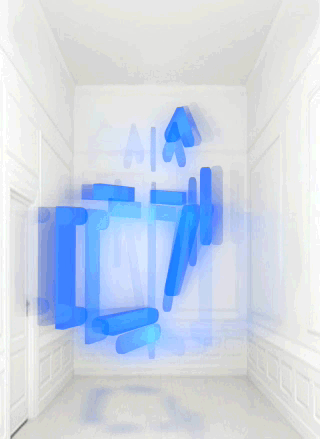
The symbol’s reflection on the floor pushes it into and anchors it in the imaginary space of the gallery. Like drop shadows in graphic design or the handling of shadows and highlights in paintings it is a visual spatial strategy to make its subject seem more real and in the same space as the viewer. The rhythm and pauses in its rotation, especially the pauses, make it seem intentional and sculptural, they give it a solidity in time as well as space.
The accessibility and framing of the Widget Art Gallery mean that “A Symbol” can travel with and be accessed by its audience over time in a variety of settings, making it even more a reflection of their lives. “A Symbol” is retro digital but with a contemporary electroluminescent aesthetic glow like a Tron Legacy costume or an Android startup screen, militaristic but emotive, hard-edged but glitching, opaque yet evocative. It is a sign of the times.
#Carnivast (Windows and Android apps, 2012) Mez Breeze and Andy Campbell.
Behind the rollercoaster hype cycle of Virtual Reality (VR) over the last quarter of a century, artists have kept working with VR as an increasingly mature medium. Realtime interactive 3D computer graphics is the most visually immersive medium for illusion in art, and text is the most imaginatively immersive. Both have been used to create virtual reality, with 3D virtual worlds in the case of the former and text-based worlds such as MUDs, MUCKs and MOOs in the case of the latter. They might appear to clash but there is a long history of 3D VR that incorporates text into or as its spatial environment.

I reviewed Mez Breeze’s book “Human Readable Messages”, which collects Mez’s “Mezangelle” micro net.text artworks, for Furtherfield here and wrote:
Mezangelle surfaces and integrates the hidden aesthetics of computer mediated human activity, setting computing and human language in tension and synthesizing them. It expands the expressive possibilities of text and is a form of realism about the conditions in which human reading is currently flourishing. “Human Readable Messages” provides an ideal opportunity to familiarize ourselves with Mezangelle in the depth that it deserves and rewards.
Collected in book form, the ephemerally distributed but thoughtfully crafted code-like text of Mezangelle becomes a book of days. Placing the avowedly low-bandwidth textuality of Mezangelle into virtual space might seem perverse, but that is what the App “#Carnivast”, produced with Andy Campbell, does very successfully.
Launching #Carnivast displays a virtual world looking like the insides of a nebula rendered in cheesecloth, accompanied by a glitchy, breathy, echoey, wavey, phaser-y, stringy soundscape. Superimposed over this in white formal capital san-serif type is the hashtag title “#CARNIVAST”. To the top left of the screen are some small button controls. Warm autumnal evening motes of colour flicker slowly across the view as the virtual world rotates slowly giving a combined impression of immensity, solidity, weight, and atmosphere. The textures on the surfaces of the world (or that are the surfaces of the world) slide slowly over each other creating interference patterns.

It’s a sensuous world, although not entirely a comfortable one, and one that invites exploration of its depths, or at least a closer look at its surfaces. The motes and the breathing are reminiscent of Char Davis’ ambitious “Osmose” (1995), the aqualung-controlled immersive virtual forest environment.
Selecting a world from the buttons and exploring it by swiping and pinching shows that the texture of the surfaces of the virtual world is Mezangelle, undulating over and through the world in a way reminiscent of some of the scenes from Laurie Anderson’s interactive CD-ROM “Puppet Motel” (also 1995) or of Michael Takeo Magruder’s VRML visualizations. The finesse of the text and the undulating environment contrast with Jeffrey Shaw’s “Legible City” (1989), a virtual environment of larger-scale text, Barbara Kruger’s Futura gallery installations, or the jagged phosphor green glow of Neo’s view of the underlying code of reality in the Matrix.
#Carnivast is very much its own experience, a series of distinctive spaces to float in. The first and third world are curvilinear and warmly coloured, the first feels like the interior of a nebula or a tokamak, the third feels like the inside of a cell or an atom. The second world is rectilinear and more acidicly coloured, closest to traditional imaginings of cyberspace. They are all meditative spaces, somewhere to spend time outside of the everyday world and to reflect. Mezangelle is an unlikely construction material for such a space, it demands too much attention to be decorative and contains rough ASCII symbols that contrast with the smooth curves or rectilinear forms of each space. It exists in tension with the surfaces of the virtual worlds, and it is this that gives #Carnivast its conceptual energy.

If you’re unfamiliar with Mezangelle, the [] button switches the screen to a rotating carousel of panels of coloured Mezangelle text that you can swipe through. Mezangelle is personal expression in an impersonal style with a social context. The geometry of the virtual spaces of #Carnivast is a substitute for the latter, and it creates an unlikely but compelling allegorical visualization of the flow of Mezangelle through mailing lists and blogs. It is a model of the social and conversational Internet rather than its technological infrastructure.
#Carnivast is finely tuned to make a space that you can lose all sense of time and self in as you explore it. As well as running on Windows PCs it works well on different sizes of portable device (I tried it on a phone, on a small tablet and a 9 inch tablet), and would work well large-scale in a gallery. How I would love to see it is modified to work with the Oculus Rift, the new consumer stereo vision head-mounted display (HMD). A Rift-enabled #Carnivast would afford a less constant opportunity of escape than the mobile version, but would be even more immersive. It’s a shame that the software is proprietary (closed source), as otherwise the community could add that feature.

#Carnivast is a mature VR artwork that represents an immersive extension of the strategies of Mezangelle into an exploration of virtual and network space. Explore it in evenings at the desktop, or keep it on your phone and get away from commuter noise and crush whenever you need to. It is a meditative experience deepened through restraint in its choices of navigation and materials and through fine tuning of its aesthetics and experience.
The text of this review is licenced under the Creative Commons BY-SA 3.0 Licence.
Opening Event: Seeds Underground Party – Sat 31 August, 2-5pm
Contact: info@furtherfield.org
Visiting Information
ABOUT THE EXHIBITION
ABOUT THE ARTWORKS
ABOUT THE ARTISTS
EVENT: SEEDS UNDERGROUND PARTY
TALK: SHU LEA CHEANG – ART, QUEER TECHNOLOGIES AND SOCIAL INTERFERENCE
LOCATION
SEE IMAGES FROM THE PRIVATE VIEW
WATCH VIDEO OF THE OPENING
This exhibition by Mark Amerika (US) and Shu Lea Cheang (US/FR) at Furtherfield Gallery marks a significant moment for contemporary art. Amerika and Cheang are both ‘net native’ artists. They share many of the obsessions of the growing multitude of artists who have grown up with the net since the early 1990s.
They are also big “names” – internationally established artists who regularly show their work, to critical acclaim, at contemporary art galleries around the world. They have crossed over into the mainstream art world whilst maintaining a critical edge.
Amerika is a media artist, novelist, and theorist of Internet and remix culture, named a “Time Magazine 100 Innovator” in their continuing series of features on the most influential artists, scientists, entertainers and philosophers into the 21st Century.
Cheang is a multimedia artist who works with net-based installation, social interface and film production. She has been a member of the Paper Tiger Television collective since 1981 and BRANDON, a project exploring issues of gender fusion and techno-body, was an early web-based artwork commissioned by the Guggenheim Museum (NY) in 1998.
Both artists continue to shape and be shaped by contemporary networked media art cultures of remix, glitch, social and environmental encounters.
Shu Lea Cheang and Mark Amerika at Furtherfield Gallery provides a physical interface in a local setting in the heart of a North London park to the thriving, international, networked art scene.
The exhibition features Cheang’s UKI viral love installation and Composting the Net. These are shown alongside pieces from The Museum of Glitch Aesthetics (MOGA), Amerika’s latest work in his collaborative series of transmedia narratives.
The exhibition features large stills from two performance installations. UKI viral love is the sequel to Cheang’s acclaimed cyberpunk movie I.K.U. (premiered at Sundance Film Festival, 2000) conceived in two parts – a viral performance and a viral game. The story is about coders dispatched by the Internet porn enterprise, GENOM Corp, to collect human orgasm data for mobile phone plug-ins and consumption. In a post-net crash era they become data deprived and these coders are suddenly dumped into an e-trashscape environment where coders, twitters, networkers are forced to scavenge from techno-waste.
![UKI – Trash Mistress [Radíe Manssour] (2009) by Shu Lea Cheang – Photo by Rocio Campana](http://www.furtherfield.org/wp-content/uploads/2013/05/radie.jpg)
In 2009, Cheang moved into the art studio at Barcelona’s Hangar medialab with 4 tons of E-trash, collected in Barcelona’s city recycling plant in one day. Amidst the rubble of wires, cables, boards, keyboards and computers, along with the coders and the hackers, UKI the defunct replicants are part of the e-trashscape seeking parts and codes to resurrect themselves.
UKI viral love is developed with collaborations and residencies at HangarBCN [artistas residentes] (Barcelona, Spain), Medialab Prado [Playlab] & [Desvisulizar] (Madrid, Spain) and, LABoral Centro de Arte y Creación Industrial [Plataforma Cero] (Gijón, Spain). The work presented at Furtherfield Gallery is the first physical installation of UKI in a gallery setting.
Composting the Net sources Internet net cultures’ accumulated data. It appropriates open (un)moderated mailing list communities, used for collaboration, sharing information and dialogue, and reprocesses the information into a virtual compost. For this exhibition Cheang composts the Spectre mailing list, a channel for practical information and exchange for media art and culture in “Deep Europe”, initiated in August 2001. The abundant info-data is reused and given extra life – an artistic legacy beyond its original purpose. It is also a celebration of the independent spirit of net culture that exists outside of corporate dominated Web 2.0 platforms such as Facebook.
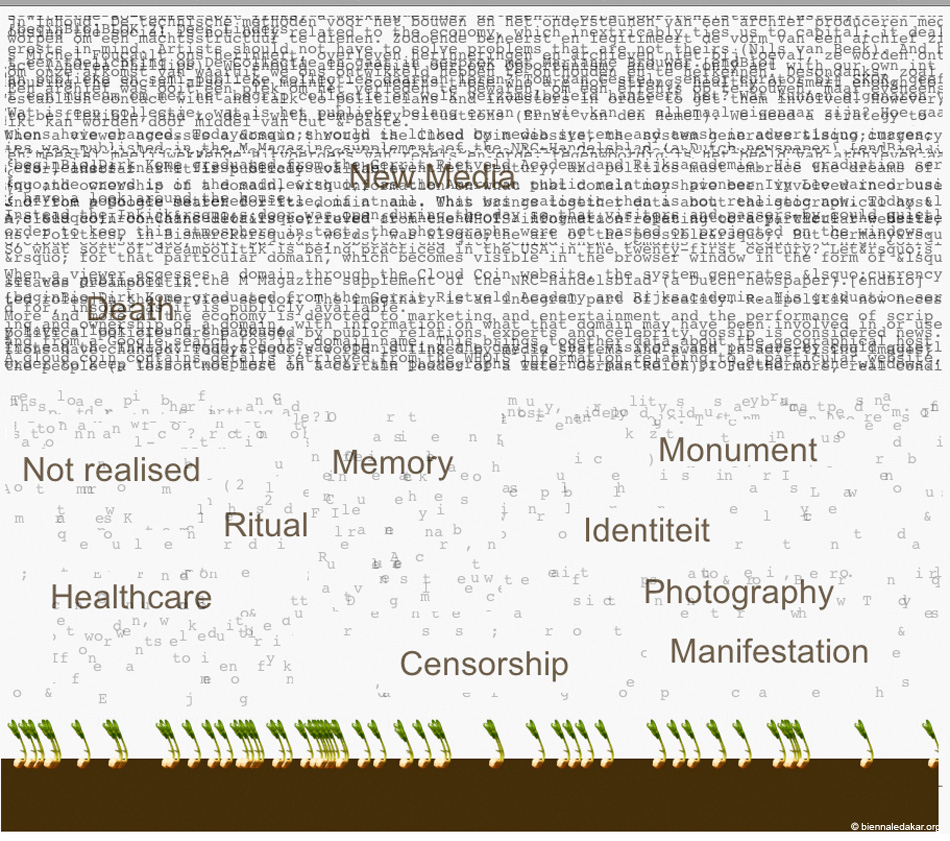
Amerika’s The Museum of Glitch Aesthetics (MOGA) features the work of The Artist 2.0, an online persona whose personal mythology and body of digital artworks are rapidly being canonized into the annals of art history. The narrative traces the life of the artist and his ongoing commitment to a practice of ‘glitch aesthetics’. MOGA features a wide array of artworks intentionally corrupted by technological processes, including net art, digital video art, digitally manipulated still images, game design, stand-up comedy, sound art, and electronic literature.
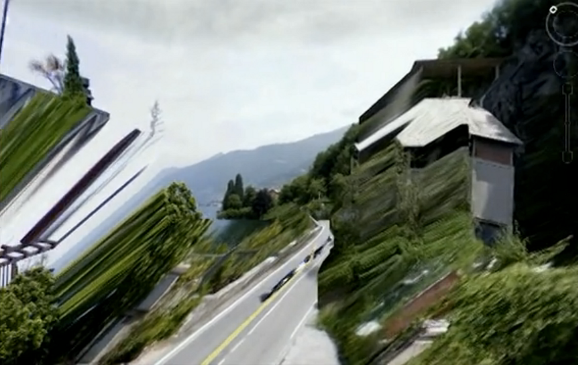
Featured in the Furtherfield Gallery exhibition are three works from the MOGA series: Lake Como Remix, The Comedy of Errors and 8-Bit Heaven.
Museum of Glitch Aesthetics was commissioned by Abandon Normal Devices for the 2012 AND Festival.

In conjunction with Shu Lea Cheang and Mark Amerika exhibition opening, Furtherfield is pleased to host Shu Lea Cheang’s Seeds Underground Party on Saturday 31 August, 2-5pm. Join us for a seed exchange party where packets of seeds change hands and go underground in the fields around Finsbury Park.
+ More information about the Seeds Underground Party.
To coincide with the exhibition, on Monday 02 September The White Building hosts a special talk by Shu Lea Cheang who will be in conversation with curator and writer Omar Kholeif.
+ More information about the Event.
Mark Amerika
Mark Amerika’s work has been exhibited internationally at venues such as the Whitney Biennial of American Art, the Denver Art Museum, the Institute of Contemporary Arts in London, and the Walker Art Center. In 2009-2010, The National Museum of Contemporary Art in Athens, Greece, hosted Amerika’s comprehensive retrospective exhibition entitled UNREALTIME. He is the author of many books including remixthebook (University of Minnesota Press, 2011) and his collection of artist writings entitled META/DATA: A Digital Poetics (The MIT Press, 2007). Amerika is a Professor of Art and Art History at the University of Colorado at Boulder and Principal Research Fellow in the Faculty of Humanities and Social Science at La Trobe University.
Shu Lea Cheang
As an artist, conceptualist, filmmaker, networker, Shu Lea Cheang (USA/France) constructs networked installation and multi-player performance in participatory impromptu mode. She drafts sci-fi narratives in her film scenario and artwork imagination. She builds social interface and open network that permits public participation. Engaged in media activism with transgressive plots for two decades (the 80s and 90s) in New York City, Cheang concluded her NYC period with the first Guggenheim Museum web art commission/collection BRANDON (1998-1999). Cheang has expanded her cross-genre-gender borderhack performative works since relocating in Eurozone in 2000. Currently situated in post-net BioNet zone, Cheang is composting the city, the net while mutating virus and hosting seeds underground parties.
Furtherfield Gallery
McKenzie Pavilion, Finsbury Park
London N4 2NQ
T: +44 (0)20 8802 2827
E: info@furtherfield.org
Furtherfield Gallery is supported by Haringey Council and Arts Council England.
This exhibition is sponsored by Rowans Tenpin Bowl, Carroll/Fletcher and Arts Catalyst.
Featured image: A random Geocities homepage, last updated sometime around 1997
Daniel Rourke visits the Photographers’ Gallery in central London and reviews their latest exhibit One Terabyte of Kilobyte Age by artists Olia Lialina and Dragan Espenschied, on THE WALL. Over an eight week period (18 April – 17 June 2013) they feature a non-stop stream of video captures of what they term as the lost city and its archival ruins. A documentation of a past visual culture of the web and the creativity of its users with new pages changing every 5 minutes. The project provides a glimpse into web publishing when users were in charge of design and narration in contrast to the automated templates of Facebook, YouTube and Flickr.
Sifting through a dormant internet message board, or stumbling, awestruck, on a kippleised [1] html homepage, its GIF constellations still twinkling many years after the owner has abandoned them, is an encounter with the living, breathing World Wide Web. At such moments we are led, so argues Marisa Olson, ‘to consider the relationship between taxonomy à la the stuffed-pet metaphor and taxonomy à la the digital archive.’ [2] How such descript images, contrived jumbles of memory and experience, could once have felt so essential to the person who collated them, yet now seem so indecipherable, stagnant, even – dare we admit it – insane to anyone but the most hardened retro-web enthusiast.
On show at London’s Photographers gallery until June 17th is an extensive archival exhibit designed to manage, reveal and keep these experiences alive. One Terabyte Of Kilobyte Age (1tb) is the fifth work to be commissioned for the Photographer Gallery’s ‘The Wall’, curated by two artists long associated with the era of the web the exhibition reveres: Olia Lialina and Dragan Espenschied. Perhaps best known for their book Digital Folklore (2009) the artists and retro-web evangelists have, with the 1tb project, strengthened their status as archivists, an impulse Hal Foster famously argued ‘concerned less with absolute origins than with obscure traces’ [3]. In the same year that Dragan and Olia launched their guide to the folk web, Yahoo! announced they were to close one of its greatest sources of inspiration: Geocities. A vast expanse of personal webpages, many of which had long since slid into html decrepitude, represented for Yahoo! little but financial embarrassment. So ancient and outmoded was Geocities that many contemporary browsers were incapable of capturing its essence, fragmenting images and link rolls randomly across modern laptop screens in an attempt to render their 800×600 pixel aura. Scraping and downloading the terabyte or so of data that made up the Geocities universe was thought important enough by some that a taskforce was put together, made up of technical wizards and wizardesses driven by the profound notion that all existent culture is worth saving. From Olia and Dragan’s webpage:
In between the announcement and the official date of death a group of people calling themselves Archive Team — managed to rescue almost a terabyte of Geocities pages. On the 26th of October 2010, the first anniversary of this Digital Holocaust, the Archive Team started to seed geocities.archiveteam.torrent.
Olia and Dragan’s gesture, to feed the wealth of culture contained in that torrent back to the masses in a palatable form, is a project whose fruition at the Photographer’s Gallery is but a minor part. After downloading, storing and sorting the 16,000 archived Geocities sites the task of exactly how to display them is a problem. Since most browsers would mangle the look and feel of the Geocities pages Olia and Dragan have turned to two main methods of re-representation. The first, let loose on an automated Tumblr blog that updates over 70 times a day, is an ever growing series of front-page screen captures. In this form 1tb bends to the will of a contemporary web user who concerns themselves with likes, reposts and uplinks.
Reflecting on the Tumblr-archive of the torrent-archive of the Geocities-archive, Olia and Dragan’s site contemporary-home-computing highlights particular screen captures that have garnered the most reposts and likes from their Tumblr followers. The results say much for the humour that still drives online culture, but perhaps little about the original contexts from whence those screen captures came. For instance, the screen captures that garner most attention are usually the ones that have failed a part of the retrieval/display/capture process. These ‘obscure traces’ may be GIF heavy sites, half loaded to interesting aesthetic affect, or, perhaps the most telling, captures that show nothing but the empty shell of a Netscape Navigator browser, caught forever like a millennium bug in digital amber.
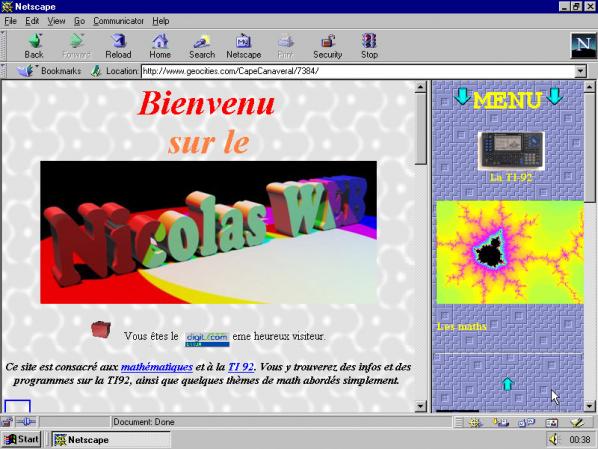
The second mode of capture and re-display takes place at the Photographer’s Gallery itself. Depicted on nine large intersecting HD video screens set into ‘The Wall’ of the entrance-cum-café, one’s first experience of the exhibit is ponderous. The display cycles through the vast array of Geocities homepages at five minute intervals, giving viewers a more than generous dose of 800×600 px nostalgia. Whether the websites that fade into view are a barrage of animated GIFs,insightful commentary on life in the late 1990s, or a series of barren ‘Under Construction’ assemblages, is up to chance.
As a reviewer, sent to derive something from the gallery experience, the wall leered at me with gestures that sent my inner taxonomist into a frenzy. Confronted with such tiny slithers of the archive, in such massive doses, it quickly becomes obvious that the real potential of the project has not been quite realised. Rather than static screen captures The Wall shows cleverly rendered quicktime videos, allowing the GIF whiskers of a Hello Kitty mascot to quiver once more. If you are lucky, or have the patience to watch a long series of the sites fade into view, you’ll be greeted by flickering ‘Welcome’ banners, by cartoon workmen tirelessly drilling, by unicorns cantering and sitemeter bars flashing. But The Wall also feels wholly at odds with its content, caught up in a whirl of web nostalgia that minimises the lives, experiences and aesthetic choices of a defining generation to static flashes that you can’t click on, no matter how much you want to. Archives are living, breathing entities wont to be probed for new meanings and interpretations. Whether depicted as static or faux animated, One Terabyte Of Kilobyte Age is a project with an endless surface, with little way for its viewers to delve deeper.
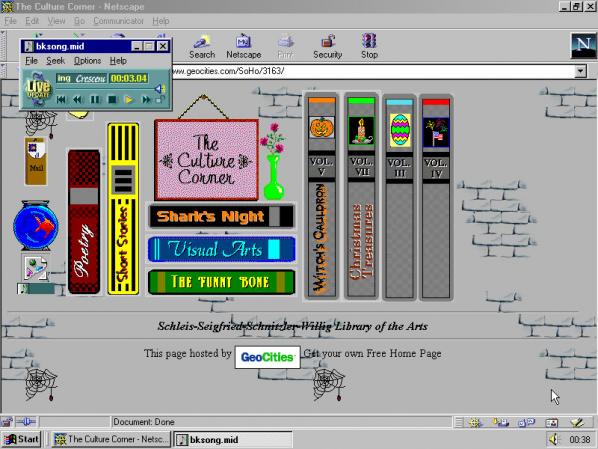
Trawling through the 1tb Tumblr is a much more visceral experience than the one that greets you at the Photographer’s Gallery, but the sense of a journey waiting to be embarked on is lost somewhat in the move to the Tumblr kingdom. Every five minutes offers a new chance to spot similarities on The Wall, to ponder on the origins of a site or, more profoundly, wonder where the people that toiled to make them are now. Before the days of user driven content, of Facebook timelines, and even before RSS feed aggregators, the whole web felt something like this. Today’s web is unarguably more dynamic, with a clean aesthetic that barely shifts behind the waves of content that wash over its surface. But the user has been relegated to shuffler of material.
The Geocities homepage was designed, and kept updated by an army of amateur enthusiasts, organising bandwidth light GIFs in ever more meaningful arrays, in the unlikely event that another living soul would stumble upon them. There is much to love about One Terabyte Of Kilobyte Age, and much to be learned from it given the time. But part of me wishes that the Photographer’s Gallery had given over their trendy café to a row of beige Intel 486 computer stacks, their unwieldy tube monitors better capturing the spirit of the web alá 1996. The clash between the 90s amateur enthusiast and the avid content shuffler of the 2010s is inherent in the modes of display Olia and Dragan chose for their project. Beginning from a desire to save and reflect on our shared heritage, 1tb now represents itself as pure content. An impulse to probe the archive replaced by an impulse to scroll endlessly through Tumblr streams, clicking like buttons on screen captures we hope will distract/impress/outrage our friends until the next cat video refreshes into view.
Go, go to the Photographer’s Gallery tomorrow, grab yourself a coffee and let the Geocities archive wash over you. If you can do it without Instagramming a snap to your friends, without updating your Facebook page with tales of your nostalgic reverie, if you can let the flickering screen captures do their own talking , only then can you claim you truly re-entered the kilobyte age.
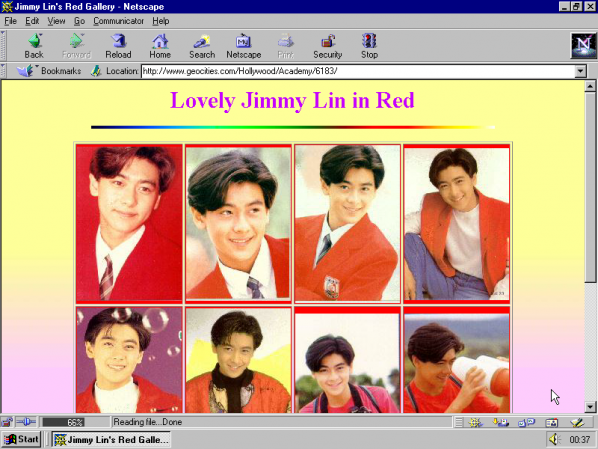
Some have proposed Jennifer Chan to be part of what has been termed as the post-internet era. But, this is an inadequate representation of the spirit, criticality and adventure at play in her work. Chan’s awareness and use of the Internet reflects a way of life, that situates its networks as a primary resource. Chan lives amongst various worlds and engages in different shades of being; a self-described ‘amateur cultural critic’, a net artist, a media artist, and academic. Her work exists both online and in physical realms, it is always present and contemporary. This is because her work lives in a world where the scripting of official art definitions loses its power. People have exploited technology to facilitate new behaviours where the artist or art amateur redefine what art is on their own terms. We are now in a post-art context. It reflects a very real, societal shift. Mainstream art culture no longer owns the consciousness of art, Chan and others like her are pulling it apart.
Marc Garrett: In your video Interpassivity a kind of docu-performance made for the exhibition REALCORE, you’re in a park spraying a brown cardboard box, silver. As you go through the process of walking around the box whilst spraying it, you comment on the object’s formal aspects. But, what you mainly discuss are your own personal views about contemporary art. It then becomes apparent that the box is a prop for the performance, enabling the subject to be explored.
Alongside your interpretations of the work my own thoughts on the subject feel as though they are included in the conversation. I know as a viewer, that the artist is not aware of my thoughts on the matter. However, it feels like there is space for me to be a part of the conversation. Not literally through a feedback system or interaction, but as an individual considering your personal questions. The artwork knows I am experiencing it, it knows that a consciousness out there is somehow engaging with its dialogue.
It is clear you are in tune with the feeling of dysfunction. You say, “I need to spit out some creative truth”. On hearing this, I was not sure whether this was a parady, irony or an expression of despair, or all these. You also say “contemporary art is removed from our everyday feelings”. As you express these words I begin the view the box as a symbol of contemporary art as a centralized, institutional monolith? So, before I unwittingly place my own meanings onto the work could you tell us what it means to you?
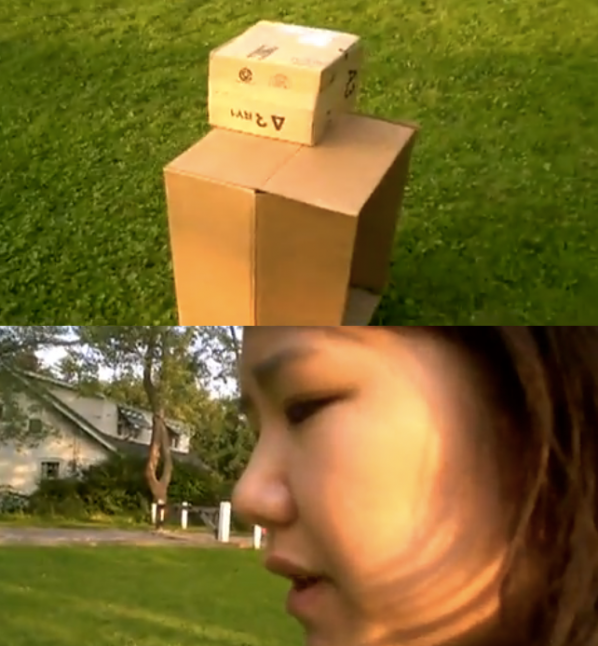
Jennifer Chan: Interpassivity is the instance of something cueing an audience to feel a certain way, such as canned laughter to stand in for humoured social reaction to jokes in a sitcom– even when it’s not funny. I titled it that because I felt like another art student trying to convince herself or the viewer what she made is art. I feel embarrassed about this self-aware but privileged complaining. A few people have found this work online and screened it, but I’m still mortified to watch it with them.
I made that video because I think a lot of contemporary art is sterile, mannered and removed from emotion. I wasn’t thinking of Donald Judd at that point but I could see the box standing in as a poor attempt at work, like his work. What I was working on (or seven years of art education) had little to do with what was happening in my life. (So to answer your question, yes, it is despair) Using my flipcam and talking over it was immediate for recording those ideas. It’s also a big trope of Canadian video art… a breathy voiceover conveys something serious and personal.
re: REALCORE. The title came about as a play on the idea of “real life”, or face-to-face life away from keyboard. Likewise, users would say “irl”(in real life), or “so real~” in Facebook comment threads to joke about the divide between online/offline contexts. The curator David Hanes felt the video was important to contextualize my use of sincerity and clichés, I was not being ironic in my intention. Arielle Gavin and Jaakko Pallasvuo thought it was questionably ironic and an emotive perspective on the Internet as a form of new sincerity.
I later found that someone wrote a paper by someone who coined “realcore” as a kind of amateur user-generated porn, which is a cool double-meaning. The “interpassivity” video was used to promote the show online but I showed my kitschy found footage videos on twisted pizza box plinths for the show. This was my fuck-you to geometric minimalism and boring white plinths, but I suppose it resulted in a different take of it…
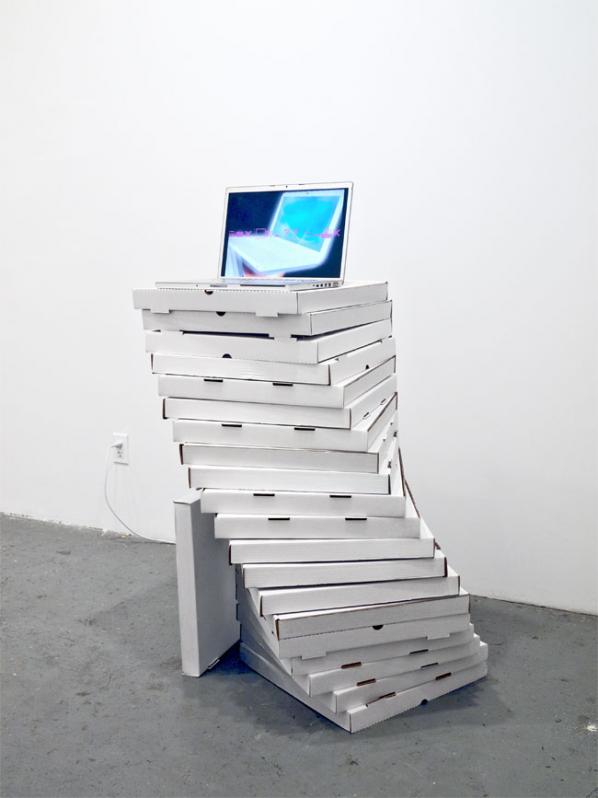
MG: In one of your recent videos “Grey Matter” when watching it felt like I was immediately pulled into a remixed world of teenage celebrity, products and brands, dripping in an orgasmic noise of techno-capitalism. Most of it is found footage, images, video and sound remixed into an edited compilation. Running through the video in between the high octane fuelled cuts and glitches, are messages to the Internet user who chances upon the video. These messages feel like they are from an individual voice but also of a multitude – caught up in a constant state of mediated folk hedonism.
What intentions lie behind this work as an artistic explorer of the entertainment culture you have remixed?
JC: Grey Matter is a first person account on feeling politically inactive online while having access to a wealth of information. I wanted to use remix in a confessional manner, so I combined obscure nostalgic media with embarrassing statements. The video begins with sped up footage of early 3D simulator ride called “Millennium Bug”. Y2K was the first technological “crisis” I recalled with clarity when I was growing up. The rest of the video includes cynical commentary on online spaces I’ve engaged with in the past year. (shopping on aliexpress.com and lurking people on OkCupid) “Little Prince” is compressed 25 times and sped up by 400%. I included old profile pics and some summary text from my OkCupid profile–I thought it was quite telling about how I wanted to be seen online and irl. I think it’s possible to feel mutually exclusive feelings at the same time, or maybe the experience of being active on different social networks produces a kind of schizophrenia. Collaging Internet pop culture is a way to appreciate it-as artifacts-in a complex light, and to be critical of it by acting out within its language.
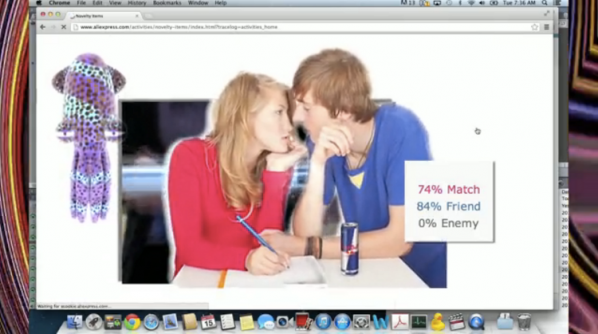
MG: What do you find fascinating about popular culture on the Internet?
JC: Anything minuscule has the potential to be popular amongst disparate users and they form vernaculars to talk about their interest in that. I find that desire relatable. That is what I think of as “community” online. It’s based on human interest and media fandom. Justin Bieber is made into something of a scapegoat for the first world’s shortcomings; people who like his image/music idolize him, and people who hate him are waiting for him to crack. Both are forms of fanaticism (one based on affinity; the other on hate-watching something.) Supercuts of Justin Bieber hairflips, object crushing fetishists, disease forums, long threads debating a detail…etc. I like the solipsism and intensity of all that.
MG: Can you share with us some of your critical insights and personal pleasures on this subject?
JC: Pop culture is paradoxical and audiences selectively enjoy it. (like teens dancing to hip hop with irreverence to its violent or sexist content.) Consuming and sampling pop allows people to indulge into its meanings, and through this there is a reconsideration of what “the masses” find important. Like the use of “users”, “masses” is what cultural studies calls everyone or everyone except-you. But every “user” has a specific relationship with interfaces and platforms, so they aren’t so homogenous.
Pop culture is also political. There was a time when more people voted for American Idol than the US elections, and if 10,000 people showed up to the 2012 cat video festival, entertainment is generally more seductive than current affairs–until there is a gatekeeping emergency (like mainstream media not covering the early days of Occupy). In terms of “internet pop culture”, perhaps traffic with social networking has overtaken porn and gambling online, but social news is also a kind of entertainment.

MG: Olia Lialina and Dragan Espenschied in their book Digital Folklore they celebrate everyday people’s use of personal computers with “glittering star backgrounds, photos of cute kittens and rainbow gradients”. They value the non-professionalism and amateur spirit that has come about from millions of people enjoying the Internet since it started. There is a difference now, the Internet masses have been shifted and prodded into large web 2.0 frameworks such as Facebook, and an abundance of personal web projects have been lost since.
And, like them do you find reassurance or a personal connection with the Internet Amateurs of the world?
JC: In context of new media art, it’s probably more accurate to think of amateurs as people who don’t self-identify as artists or technicians. What non-artists do with software and video appears facile, sincere, and intuitive. I make amateur-looking work to dialogue with that.. I like to say something dumb to say something serious. Something that’s made simplistically and filled with kitschy references can be packaged as critique that also appeals to non-art audiences.
I caught the tail end of the homepage-o-sphere/webring 1.0 period. Non-artists made personal websites out of a genuine interest in something. tumblr and pinterest is used in a same way today–to collect indiscriminately. Like 2.0 frameworks, the early internet also had free webpage hosting that users relied on (Geocities and Lycos). Personal website design isn’t over either; net artists still make them or bind together to create their own sites (like tightartists.com). I think I have an idea of what you mean though; it was less commercial and there weren’t as many distinct “most-visited” places online.
I made a lot of gothy dark art on DeviantArt before I knew about contemporary art, and my sensibility towards Photoshop was more romantic and impulsive without the baggage of art education. Maybe this “revival” cult of amateur-looking digital folklore happened because I/we exoticize that kind of amateur production. Web vernaculars have also become stylized and this aesthetic is shared with seapunks and filmmakers. Artists need to adapt to that.
MG: What do you feel is still alive and open for everyday online expression and play, in respect of what Lialina and Espenschied perceive as Digital Folklore?
JC: I think a lot of emerging artists have a greater awareness of obsolescence and upgrade culture than we give them credit for–while still complacent to the socialization structures on Facebook. Many seem more interested in navigating these networks to question their inner control mechanisms than overthrowing them or innovating new ones. It can be simple things like friending as many users as possible, looping webcam feeds, archiving and re-uploading banned content on different platforms, having an anonymous/alternate personas/using multiple accounts…etc. People like glitchr and Ian Aleksander Adams are always looking for ways to use a system against its intended functions in the same way jodi did all the cheat moves in max payne CHEATS ONLY. I admire glitch practices for that.
There’s also the possibility for re-appropriating anything to rebrand or critique particular communities. I think Angela Washko and Jaakko Pallasvuo are doing this in a compelling way that covers a large territory between art and Internet culture.
MG: So, what are you working on at the moment?
JC: <–for some reason this sounds less perverted than if I were an old guy doing this to teen girls but its really just as perverse–>
I’m observing what young adult/teen boys do on YouTube: bulking up, performing dares, talking about how to pick up a White/Asian girls etc. I’m also making a video about Asian guys (both diasporic, Asian American, and more specifically, Korean and Taiwanese men) and their interpretations of mediated masculinity. There is something disturbingly tantalizing in terms of how they have learned to look at the webcam as if they are boy band stars yet they are not fully grown men. A lot of this is informed by growing up in Hong Kong, and knowing that fashion and romance, is inspired by many “neighbouring” cultural media from Japan, Korea and Taiwan even though American/British influence is also prominent in the club scene.
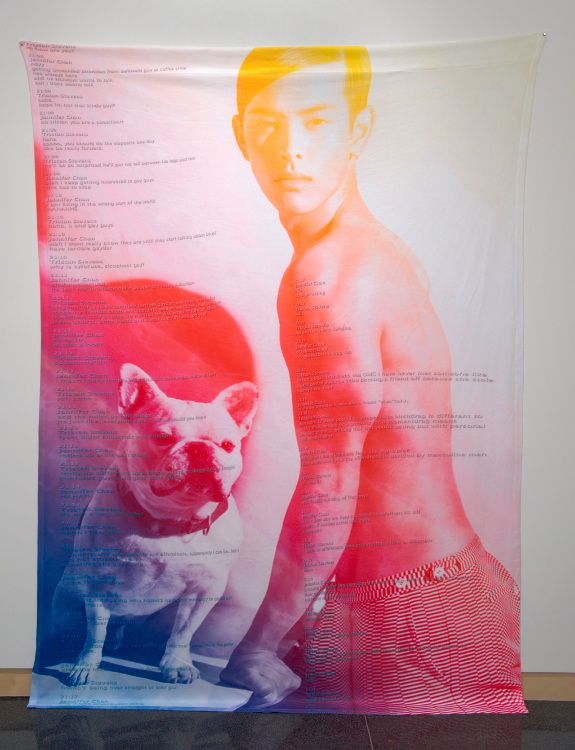
Here are two images from my late installation that will foreshadow this interest. It’s chat text over layered on modified fashion and makeup adverts targeted at Korean and Chinese men, and printed onto micro-fibred bedding. I feel like they’re treated as pleasant freak shows on tumblr but this imagery is a banal, idealized kind of masculinity in Asia. I think western facial features are really common amongst these popular images of Asian-ness, and most would tend to read it as aspiring to western culture, though the hyperfemme “doll” look or metro-masculinity has been a regional style since the 90s.
Chan’s work reflects an emerging condition described by Zizek as “interpassivity” in which our engagement with interactive experience has lost traction and is replaced with “its shadowy and much more uncanny supplement/double “interpassivity””[1], a “Fetish between structure and humanism”[ibid]. We are pulled into a paradox, where ‘interaction and passivity’ are joined together as spectacle of constant mediation. Millions have joined online centralized, megastructures such as Facebook, and this is not a black and white situation. Many are coerced from social and consumer pressures into the state of being seen as interacting. As the futuristic time machine streams onwards at high-speed, agency slouches into a spurious and distant dream. Others and the same are enjoying the flow for the sake of self expression within these scripted frameworks.
Chan’s work critiques, plays with, and exploits this networked, social intervention, as well as her viewers’ desires. Her imaginative palette revivifies questions about agency, passivity, sexuality, privacy, individuality, behaviour, networked consumption and its production. These remixed artworks have much material to work with, as the endless ether of everyday noise is uploaded and distributed through blogs and social networking sites; then returned into the ether as cut-ups where a transforming culture is engaged in its own mutation.
Its noise engages us whether we enjoy it or not, in the medium of “interpassivity”, and we all find ourselves caught within this spectacular enticement driven by the Netopticon. “On a holiday trip, it is quite common to feel a superego compulsion to enjoy, one “must have fun” — one feels guilty if one doesn’t enjoy it.”[ibid]
Jennifer Chan – http://www.jennifer-chan.com/
Heavy MetaVernacular video after the popularization of the internet
http://jennifer-chan.com/index.php?/curatorial/heavy-meta/
SELF-LOVE A non-consensual exhibition of emerging net art
http://jennifer-chan.com/index.php?/curatorial/self-love/
New Insularity Peer backpatting. A screening of works by friends and users whose works I admire.
http://jennifer-chan.com/newinsularity.html
Feeling VideoThe affective appeal of antisocial video
http://jennifer-chan.com/index.php?/curatorial/feeling-video/
Trivial Pursuits Distracting “new media art”
http://jennifer-chan.com/index.php?/curatorial/trivial-pursuits/
Curated by Rosa Menkman & Furtherfield.
Opening Event: Saturday 8 June 2013, 2-5pm
with Glitch Performance by Antonio Roberts at 3pm
Open Friday to Sunday 11-5pmContact: info@furtherfield.org
DOWNLOAD PRESS RELEASE
IMAGES OF THE OPENING ON FLICKR
READ Glitch as a Symbolic Art Form BY ROB MYERS
WATCH VIDEO OF THE OPENING
“The glitch makes the computer itself suddenly appear unconventionally deep, in contrast to the more banal, predictable surface-level behaviours of ‘normal’ machines and systems. In this way, glitches announce a crazy and dangerous kind of moment(um) instantiated and dictated by the machine itself.” Rosa Menkman [1]
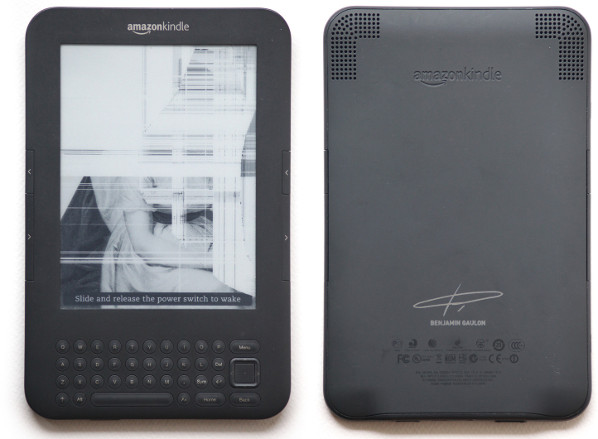
Glitches are commonly understood as malfunctions, bugs or sudden disruptions to the normal running of machine hardware and computer networks. Artists have been tweaking these technologies to deliberately produce glitches that generate new meanings and forms. The high-speed networks of creation and distribution across the Internet have provided the perfect compost to feed this international craze. The exhibition shows various approaches by artists hacking familiar hardware and their devices which include mobile phones, and kindles. They disrupt both the softwares and the digital artefacts produced by these softwares, whether it be in the form of video, sound and woven glitch textiles.
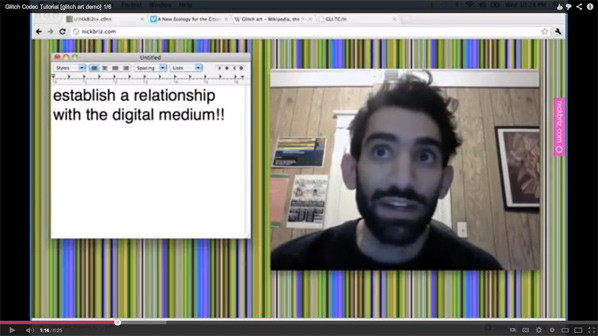
Glitch art subverts the way in which we are supposed to relate to technology, causing playful, imaginative disruptions. It is a low-tech and dirty media approach with a punk attitude. These artists appropriate the medium and forge expressions that go beyond what the mainstream art world expects artists to do, it is unstoppable – it is Glitch Moment/ums.
Copies of Rosa Menkman’s groundbreaking Glitch Art critique The Glitch Moment(um) will be available for purchase during the exhibition.
![numbermunchers from the untitled [screencaptures] series by Melissa Barron](http://www.furtherfield.org/wp-content/uploads/2013/04/melissabarton.jpg)
Empty Spinning Circle become Full (part b) (2012) from the Further Abstract series by Alma Alloro
One Square in colors (2012) from the Further Abstract series by Alma Alloro
untitled [screencaptures] (2010) by Melissa Barron
The Glitch Codec Tutorial by Nick Briz
KindleGlitched (2012) by Benjamin Gaulon
Thoreau Glitch Portrait (2011) by José Irion Neto
Copyright Atrophy (2013) by Antonio Roberts
What Revolution? (2011) by Antonio Roberts
Beyond Yes and No (2013) by Ant Scott
Glitch artists and enthusiasts are invited to add their work to GLI.TC/H 0p3nr3p0.net, a Glitch Art repository coded by and developed by Joseph ‘Yølk’ Chiocchi & Nick Briz. The submissions will be showcased during Glitch Moment/ums at Furtherfield Gallery. To include your work in the 0P3NR3P0 component of Glitch Moment/ums submit a link to any visually wwweb based file (html, jpg, gif, youtube, vimeo, etc.) and your piece will automatically be included in the line-up (one work per artist).
This new IRL exhibition has been organised in collaboration with Nick Briz and Joseph ‘Yølk’ Chiocchi.
SUBMIT && SHOW on 0P3NR3P0.NET.
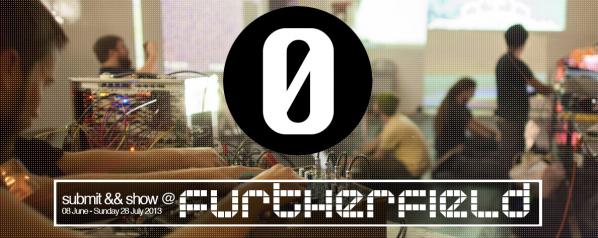
Alma Alloro
Alma Alloro (IL) is an artist, musician and performer from Tel Aviv. She is rooted in the backyard of popular culture using diversified media from drawing, installation, music, and animation to internet; her recent works focus on the correlation between old media and new media.
Melissa Barron
Melissa Barron is an artist living and working in Minneapolis, Minnesota. She studied at the School of the Art Institute of Chicago where she focused on new media and fiber. In her work she combines these two fields by reinterpreting hacked Apple 2 software through different fiber techniques. Her work has been shown at various international events, including the Notacon hack festival in Cleveland, Ohio, GLI.TC/H in Chicago and ISEA 2011 in Instabul.
Nick Briz
Nick Briz is a newmedia artist, educator and organiser based in Chicago IL. His work has been shown internationally at festivals and institutions, including the FILE Media Arts Festival (Rio de Janeiro, BR); Miami Art Basel; the Images Festival (Toronto, CA) and the Museum of Moving Image (NYC). He has lectured and organized events at numerous institutions including STEIM (Amsterdam, NL), the Museum of Contemporary Art Chicago, Marwen Foundation and the School of the Art Institute of Chicago. His work is distributed through Video Out Distribution (Vancouver, CA) as well as openly and freely on the web.
Benjamin Gaulon
Benjamin Gaulon is an artist, researcher and art college lecturer. He has previously released work under the name “Recyclism”. His research focuses on the limits and failures of information and communication technologies; planned obsolescence, consumerism and disposable society; ownership and privacy; through the exploration of détournement, hacking and recycling. His projects can be softwares, installations, pieces of hardware, web based projects, interactive works and are, when applicable, open source.
José Irion Neto
José Irion Neto is native of Santa Maria, in southern Brazil. His first contact with computers was in 1982 using a machine equivalent to Sinclair ZX Spectrum. He has an academic background in Media Advertising and worked for some years as a Graphic Designer. Today, he has been working with advertising only occasionally, focusing on creating posters, dedicating most of his time on developing Glitch Art. He has worked and researched Glitch since 2008.
Antonio Roberts
Antonio Roberts is a British digital artist whose artwork focuses on the errors and glitches generated by digital technology. Many people would simply discard such artefacts but Antonio preserves these errors and displays them as art. With his roots in free culture he develops his techniques using open source and freely available software and shares his knowledge through the development of software.
Ant Scott
Ant Scott (UK) is a glitch artist and co-author of the first glitch aesthetics coffee table book Glitch: Designing Imperfection (New York: MBP, 2009). His work is informed by cognitive distortions.
Rosa Menkman
Rosa Menkman is a Dutch visualist who focuses on visual artifacts created by accidents in digital media. The visuals she makes are the result of glitches, compressions, feedback and other forms of noise. By combining both her practical as well as an academic background, she merges her abstract pieces within a grand theory artifacts (a glitch studies), in which she strives for new forms of conceptual synthesis of the two. In 2011 Rosa wrote Glitch Moment/um, a notebook on the exploitation and popularization of glitch artifacts (published by the Institute of Network Cultures), organized the GLI.TC/H festivals in both Chicago and Amsterdam and co-curated the Aesthetics Symposium of Transmediale 2012.
Furtherfield Gallery
McKenzie Pavilion, Finsbury Park
London N4 2NQ
T: +44 (0)20 8802 2827
E: info@furtherfield.org
Furtherfield Gallery is supported by Haringey Council and Arts Council England
Cyposium
an online symposium on cyberformance
Friday 12th October 2012
http://www.cyposium.net/
We all perform on the Internet. The social media profiles that we are contractually obliged to give our real names to are just as much performances as our World Of Warcraft or Minecraft avatars. Yet these impromptu performances of our socialised and fantasy selves lack the literary quality of drama. Not drama in the sense of a Usenet or Tumblr flamewar, but in the sense of theatre.
The 1993 New Yorker cartoon captioned “On the Internet, nobody knows you’re a dog” identifies two important features of the early public Internet. Firstly it’s a place, somewhere you can get onto. Secondly that place has limited bandwidth for establishing identity and communicating affect. This meant that the Cyberspace of the net became a site for identity play and imagined realities.
As the text-based virtual reality of MOOs gave way to the image-based Palace Chat and then three dimensional AlphaWorld the available bandwidth increased and with it the available ambiguity decreased. Describing a character or a scene or an action with a few words leaves the members of the audience much freer to exercise their own imaginations than seeing it in full motion animation with a high polygon count.
The visual, social and even economic order of virtual worlds and social media have become a more fixed and uncritical embodiment of mass media and the established social order. This has reduced their potential for alterity but it has made them useful representations both of shared reality and shared fantasy that can be used as a stage on which to perform critically, reintroducing the literay against the grain of their unreflective consumption of identity and spectacle.
Throughout this history, from the early 1990s to today, the Internet’s affordances have been used to produce dramatic performance in Cyberspace, “cyberformance”. The problem is we don’t remember this, at least not as clearly as we should. Individually, institutionally, and technologically we have lost our memories of artistically groundbreaking and important performances.
This problem is not unique to cyberformance. All digital art suffers from the decay of digital media and the creeping obsolescence of the hardware that it runs on. Internet art suffers from bitrot, software obsolescence, linkrot, the loss of web pages and sites elsewhere on the net that are connected to the work, and netrot, changes in the protocols used to distribute it.
Above and beyond those problems, cyberformance involves live perfomance. Unique events produced by historical communities at a particular moment using media that will rapidly become obsolete need to be recorded in order to be remembered or at least to be critically re-evaluated later. This creates a second layer of conservation and archiving problems.
Take the example (outside of Cyposium) of Judy Malloy’s “Brown House Kitchen”, a narrative environment created in the LambdaMOO text-based virtual reality. Despite being mentioned in surveys of virtual art in the 1990s, despite being produced with institutional support, and despite being stored on one of the longest-running textual virtual world servers the software objects that made up the work were recycled as part of the normal running of LambdaMOO and are now lost. Many other text-based virtual realities, some specifically designed for dramatic works, are not even online any more. And the protocols used to access them are old, with software to connect to them increasingly not installed by default on newer operating systems. Even those created after the Internet Archive started will not appear in it, as they are not web-based.
I mention LambdaMOO as by chance I was researching text based virtual worlds and performance in the months before Cyposium was announced. One work that was described in the literature but untraceable online was Stephen A. Schrum’s “NetSeduction”. Which Schrum presented and discussed at Cyposium. And the script of the original performance was made available through the Cyposium website. Without Cyposium, these resources would not have been made available.
These contrasting examples drive home just how badly needed Cyposium was. The Internet does enable us to digitise and experience more culture than ever before, but it also erases our memories of the culture that is native to it. And the often highly experimental nature of cyberformance makes it harder to record and remember than almost any other kind of technologically enabled art.
As well as addressing a specific need to recover the history of net performance, Cyposium is an exemplary model for a new kind of online event in the era of Massively Online Open College courses. It performs the function of a symposium or convention online, reducing barriers to access and increasing reach for institutions, speakers and audience members. The Waterwheel Tap software used for most of Cyposium allows side-channels of audience communication, which help to build a sense of place and community and allow the audience to ask (and answer) questions and share knowledge among themselves and with the speakers.
The panel discussions that Waterwheel enabled meant that old and new net performers could discuss each others work in the light of new developments or freshly reconsidered history. And we, the audience, wheoever we were and wherever we were, could watch and learn from this discussion and join in. I am often wary of the word “open”, but there was an intellectual and social generosity and inclusiveness to Cyposium that made it feel like a very open event.
A ripple of excitement went through the mailing lists I subscribe to when Cyposium was announced. Its organizers and line up promised something special, and the event itself didn’t disappoint. To be part of the audience, chatting in text alongside the live streaming video presentations, was to be part of both a welcoming ad hoc conversational community of interest and participating in a key moment in a larger historical conversation.
Cyposium went beyond recovering and presenting the history of online performance. It brought together net performers old and new in productive dialogue in front of an engaged audience and served as an example of a new kind of net native event. Now that the event itself has finished the Cyposium web site serves as an important record of an important aspect of online creativity.
This essay will appear in the forthcoming Cyposium book.
The text of this review is licenced under the Creative Commons BY-SA 3.0 Licence.
In September 2012, Italian tactical media artist Salvatore Iaconesi got the diagnosis. He had a glioma (glial cell brain cancer) of approximately 2×3 cm on the surface of his right hemisphere. Upon asking to see all the data relating to his condition, he found that all of the documents, MRI scans, and so on were in obscure not readily used formats. This meant that if one wanted to view the data, you needed specific or corporate software.
What he did then was remarkable. Iaconesi then hacked the formats of the documents and converted them into open-source ones that anyone could read could read with FLOSS (Free Libre Open Source) software. He then created the site, La Cura, where he presented his records as an “open source cure”. People around the world could access his records and then add their recommendations and findings about his condition, cancer, and so on. I begin this interview with Salvatore on September 15, 2012, and the La Cura website already has a rapidly expanding database of information at http://www.artisopensource.net/cure/.
Patrick Lichty: Salvatore, thank you for having this conversation. I remember that it was only a year and a half ago when we were shop-giving copies of the REFF tactical media book from your project, Fake Press in Rome. So, it was a shock when I learned of the glioma the day you launched the site. Could you talk a little about what is on the La Cura site?
Salvatore Iaconesi: Hi Patrick! Yes I do remember, too. And that is also a great explanation on what can be found at La Cura site: it is like one of our “fakes”, except that it is not a fake.
La Cura is about an alternative reality which I want to materialize on this planet, now. In this alternative reality, when someone has a serious disease, life does not end. One can be social, creative, and friendly. Work, art, design, fun and entertainment are possible for diseased people in this alternative reality, just as it is possible to reach out to find cures in any philosophy, time, strategy, culture or way one wishes. And consider that even technologies in this alternative reality are designed to enable and facilitate all this, actively promoting the freedom and autonomy of people.But, sadly, life is not like this alternative reality.
I wanted it to be my alternative reality, so I just did everything it took to bring that reality into the world. It’s like when you make an Augmented Reality application: you do a series of things to “materialize” some other things into ordinary reality. And then you have them, right there. So, La Cura is my personal Augmented Reality, in which, if I want to, I have all the tools and information I need to find a “cure” for my disease in one of multiple ways and strategies, which are medical, cultural, technological, emotional, artistic, political etc.
To achieve this, I have had to go through a series of obstacles:
The first is connected to language and information, as the first thing you notice at the hospital is that they are not really talking to you. Medical language is difficult and complex, and they rarely take action to make things more understandable to you. One of the testimonies I received in La Cura was that of a lady who has found herself in front of a doctor shouting at her: “You really think that I will explain to you why your thyroid has to be removed? It has to be removed! That’s it!”
This is really not “open”, in any sense. And, in more than one way, it is an explicit evidence of the approach which medicine has towards patients: they cease to be “humans” and become sets of parameters on a medical record subject to certain protocols and standards. When you are in the hospital, it’s often as if you’re not there. The only thing that matters is your data: blood pressure, heartbeat, magnetic resonance etc.
And the way in which information reflects this if handled in this context. Data formats may be, technically “open”, meaning that they are described somewhere but they’re really an explicit reflection that when you’re sick you “step out of society”. That data is usable and accessible only to “professionals” and to those people who have tools and skills to handle them.

I, as someone with considerable expertise with computers, have had some difficulties in opening them. Imagine someone else with less skill! Most people would not have been able to benefit from all the types of “cure” which I am currently accessing from a variety of sources and modalities. They would not have access to a “cure” that doesn’t end at a list of medicines and dosages, but spreads out into society.
To do that, I have had to hack into the information and convert it into really “open” data, using multiple formats that could be used by many kinds of people to do multiple things. In the format that the data was originally in, even if it was “technically open”, that data would have been seen only by “professional doctors” and, instead of being a “human being”, I would only have been a “patient”, or worse yet, a “case”.
PL: What do you want people to do with the information?
SI: Whatever they wish! Obviously! What is important in this case is that we must agree on what the “information” is… What I am publishing is my autonomous will to disclose my state of disease, including all data and medical information. I have my own purposes for this, but it does not necessarily mean that this purpose must/should be shared by others.
My personal purpose for this disclosure is to autonomously shape my own human condition. I have a disease but I am not a “diseased person”. I am a person. And, as such, I wish to create my personal “cure”, which has to do with my life, not with my disease. For what people know, I might even consider cancer as not being a “disease” at all! I might, for example, consider it an expression of the “cure”, such as if I adhered to Hamer’s theories. Which I don’t, or, at least, not in the sense that “I believe” in Hamer’s theories; I take them into consideration, but I don’t believe in them, just as I don’t believe in chemotherapy, in Aloe Vera, in Caisse Formula, in surgery, in shamanism, in healers, oncology or in any of these things. I take all of them into serious consideration, just as I seriously consider certain philosophies that say that we are made of energy, energy creates matter, and cancer is “matter” and so on. Therefore, cancer must be created by energy in some form. And so it could possibly be that I created cancer myself in a way or another.

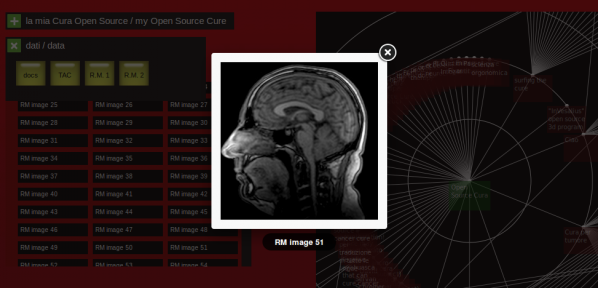
So in this sense, I think it is very important to be able to easily look at the images of my cancer and to say “hello” to them. It is important to turn them upside down, to edit them with GIMP, to make mosaics out of them, to speak to them, asking “hello?” What are you doing in there? Did I do something to cause you? Can I change something to make you/myself feel better?”
Both scientific and traditional evidence shows that art, positive emotions, laughter, reduced stress, and a good social life have great practical benefits to the human body, I want to seriously consider that part of my cure could be formed by receiving an image of my brain with a smiley face drawn across it over the tumor, or a picture of a friend of mine, or a video of a projection mapping done with Processing in which the images of my cancer cover a whole facade of a building.
And since I don’t want to believe, but I want to take all of these things into serious consideration, I cannot focus only on the “medical” approach (and the related information, and its formats). I need to access all of my information in multiple ways, and I wish that everyone could do the same (as, from my point of view, it’s part of my Cure). And, even if “technically open”, the format in which my medical records have been disclosed is not enough, because it is “open for professionals” and so the only thing I could do with it would be “show it to professionals”, missing out on all the other wonderful parts of the “cure” which are available in the world.
This for me, is an interesting starting point to think about what things such as “OpenData” could mean. This is far beyond the idea that some government can some data according to ways in which some “professionals” could grab it and, do something like make a visualization or an App out of them. Who knows? In this sense, instead, we would not be talking about “technology”, we would be talking about “humanity”.
In the end, this is exactly what I’d like people to do with the “information”. I want the world to take the fact that I decided to disclose the fact that I have a disease and that I want to actively search for a cure for from all of these perspectives. In the meantime, I want to reconsider what it means to be “diseased” in current times and what new conceptions of the word “cure”, “medicine” associated with my condition could mean.

PL: What has happened since you launched the La Cura site?
SI: Lots of things. People are contributing and participating in multiple ways. There are testimonies, art, poetry, suggestions, videos, performances. Many doctors have called in to propose their methodologies and technologies. I have had very interesting and profound discussions with people who are prepared to deal with very complex things every day of their lives. I’ve communicated with doctors who are perfectly open to the possibility of such a paradigm change for the word “cure”. Artists, designers, activists, are giving me wonderful parts of “cure”. Many “patients”, “ex-patients”, “relatives” and “friends” of “diseased people” are sharing their experiences, are opening discussions, are sharing the information I found on possible medical cures. And so many people want to talk to someone in new and different ways, becoming again, simply, humans. Journalists from all kinds of media have started to ask for interviews, texts and videos. We stopped that after a while, as we don’t wish to turn this into merely a “spectacle”. We only keep on working on this with journalists which we know we can trust and which we know will not transform what we say to produce their news.
PL: For your information, I had an MRI in 2009 here in the States, due to my doctors’ concerns of something similar (nothing was found), but when I asked for the data, I got a CD full of JPEG images. Were you surprised when you found out your records were in particular formats?
SI: They were not really in a proprietary format. Let’s call them “exotic formats for professionals”. And yes, I would have expected something which I could have shared easily (such as your JPEG images, and maybe some meta-data in some easy to use format such as XML, or even a spreadsheet). But this was a sort of paradox: an “open” format which is really hard to open and to use for something else other than putting the CD in an envelope and (snail)mailing to the next doctor.
PL: What do you think the line is between privacy and data oppression? Would that be when the patient is denied access to their rights to access the information and distribute it as they wish?
SI: We should all know this by now. Privacy is not a problem unless the “system” is made by lousy people. We have tools to protect ourselves and to promote ourselves, and these tools are dangerous only when who runs them is a lousy person. Privacy protection arises through education (understanding what is privacy and when/where/how/why would I want to protect it) and through the acquisition of decent ethics from the people and organizations which run the entire infrastructure through which all our digital data goes through. And obviously, and most importantly, our ethics is created by helping each other out in a P2P way, teaching each other what we know, what we discover and how we decided to handle it when we found out.
There is no single line between privacy and data oppression. Not one which everyone would agree on. We have the tools for each one of us to tune this line to our own wishes, according to what we want to do, what are our desires, what are our objectives etc. We “just” need more places (physical, digital, virtual, institutional, occasional…) in which to discuss and share our points of view, as every time this happens, many things are learned on all sides.
PL: Do you consider your site a form of radical tactical media intervention?
SI: I can now say “I have a radical tactical media intervention in my head”. Cancer is the new Black. The Cancer is the Message. And we could go on. I don’t know. I guess I could call it that. I also guess I could call it a performance. I guess I could call it life. I guess I could call it hacking or whatever. I will just call it La Cura.
PL: What has been the most inspirational information, art, or otherwise that has resulted from the launching of the La Cura site?
SI: The most enlightening thing that happened is the experience of talking about the same exact thing using dozens of different languages. I have spoken with neurosurgeons, shamans, nutritionists, pranotherapists, doctors, activists, macrobiotics, hippies, cyberpunks, punks, friends, relatives. Most of the time, I received incredibly good advice. When you look at that advice from different points of view, you start to understand that you are really talking about the same thing, but in different languages.
For example, two of the most important things which you deal with when you talk about cancer are the idea of creating alkaline environments in your body (because cancer cells cannot stand them) and the facts that anti-oxidants are a great tool in support of any type of therapy (because of the molecular reactions which are at the base of cancer).
Well, speaking of just these two, it occurred to me that multiple theories deal exactly with these two concepts. I have had an esoteric master describe my cancer as an invisible living being, and he suggested to drive it away using sulfur and Rosa Rubiginosa oil, in ways which turn them into two incredible anti-oxidants and creators of alkaline environments as well as powerful stimulants of the immune system. I have also spoken with nutritionists and macrobiotics communities and learned about their instructions on choosing food, cooking and eating, many of which are directed exactly to that: anti-oxidants and creating alkaline environments, but through food.
And when an oncologist explained us his therapy, that’s exactly what it was about: powerful anti-oxidants and alkaline environments. And on, and on and on. Aloe Vera, Caisse formula, fungus theory, chemiotherapy, Di Bella method, potassium ascorbate, ketogenic diets, etc: all highlight cancer cells in some way; create an environment around them which is as alkaline as possible; anti-oxidate them; activate the immune system as powerfully as possible so that the highlighted weakened, cancer cells can be more easily “convinced” at mutating back to a decent form or to commit suicide with the help of the immune system. Realizing this is an enlightening experience: it spans across thousands of years and also helps you make some choices (things stand out when they speak about different things!).
Everything else that is going on in La Cura is wonderful, but having realized this fact is just incredible and fascinating. You start imagining about all the other things we discuss about in our daily lives using multiple languages (energy, politics, emotions…) and start to wonder what would happen if you turned on this shared, P2P modality in those cases as well.
PL: How do you hope that others will benefit from the conversation that you are starting through La Cura?
SI: I don’t “hope” anything. I did this because I felt I needed to. When one talks about “revolution” dialogues start arriving at the point when one says, “Let’s burn everything down!” “Let’s destroy everything!” and so on.
We know we can’t do it. We can’t “destroy everything”. It’s not possible. What we can do is to create a reality as if everything already happened – as if the “revolution” already happened, as if the world had been burned down already, and rebuilt, just the way you like it. We can live life like this. It is a bit more than “seeing things”. But you do Augmented Reality, Patrick. You know what I mean. It’s a bit more than “writing”, it’s about creating worlds.
PL: As of this interview, what is the prognosis of your condition?
SI: Depends on what perspective you look at it from. From the medical point of view I have a low-grade glioma at intensity which is still undecided, between 1 and 2 (we will have to wait an histologic exam to know for sure). From the human point of view: I am fine! I have no apparent symptoms. I just need to be careful because if I find myself in stressful situations I could react by having an epileptic shock. So it is not advised that I drive or things like that. It’s the perfect excuse! 🙂
PL: Don’t you think it’s funny that the abbreviation for your name is “si”?
SI: Sì! Obviously 🙂
Charlie Gere is a Media Theory and History professor in the Lancaster Institute for Contemporary Arts, Lancaster University. Co-curator of FutureEverybody, the 2012 FutureEverything exhibition in Manchester. In 2007 he co-curated Feedback, a major exhibition on art responsive to instructions, input, or its environment, in Gijon, Northern Spain. He has given talks at many major arts institutions, including the Centre de Cultura Contemporània de Barcelona, the Architectural League in New York, Tate Britain, and Tate Modern. Gere’s new book, Community without Community in Digital Culture (Palgrave MacMillan, 2012), is out now.
Previous titles include: Digital Culture (Reaktion Books, 2002), Art, Time and Technology (Berg, 2006), Non-relational Aesthetics, with Michael Corris (Artwords, 2009). Gere was co-editor of White Heat Cold Logic (MIT Press, 2009), and Art Practice in a Digital Culture (Ashgate, 2010), as well as writing many papers on questions of technology, media and art. He is also co-editing with Robin Boast an anthology entitled Allegories of the Information Age (forthcoming).
Marc Garrett: Digital Culture was originally published in 2002, which happens to be the version I’ve had all these years. In 2008 it was republished, revised and expanded. Now the book has an extra chapter ‘Digital Culture in the Twenty-first Century’. Of course, we already know that digital technology and society has changed dramatically since 2002. So, what themes and historical contexts did you choose, as necessary to include in this new and last chapter?
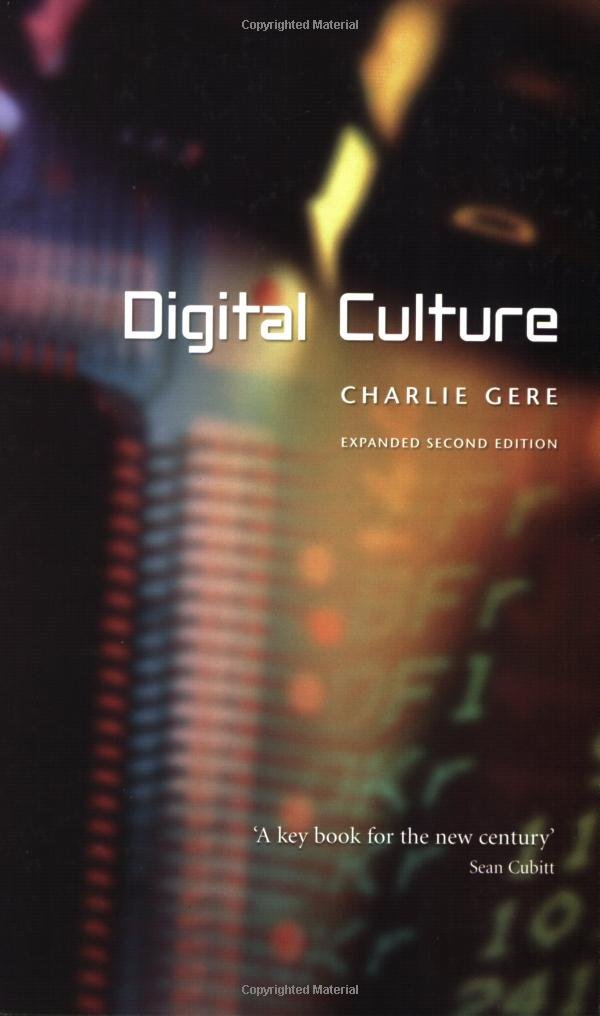
Charlie Gere: What happened after the first edition’s publication was of course, the rise of so-called Web 2:0, which was simply the greater exploitation of the reciprocal possibilities of the Web. I tried to reflect on how this reciprocity was visible beyond the Web itself and was becoming part of a more general culture of engagement and exchange, not that I share some of the more utopian visions of this phenomenon. Indeed, in my new book Community without Community in Digital Culture, I try to counter the, for me, more naive visions of community in relation to digital technology. I advocate a more ‘non-relational’ approach that does not deny the transformative effects of new media in terms of community but thinks of it more in terms of hospitality to the other.
MG: Many of the artists we have worked with are using new media to explore and critique the utopian assumptions you discuss: YOHA, IOCOSE, Liz Sterry, M.I.G (Men In Grey, Julian Oliver and Danja Vasiliev), Heath Bunting, Face to facebook (Paolo Cirio and Alessandro Ludovico), Annie Abrahams and more. Each of them work in a deeply relational way to intervene in the mythologies projected about digital technology; and, with a knowingly crtical eye of the technical limitations and the social controls at work when using networked technology. At different levels, all are producing work that ‘consciously’ incoporate relational contexts, in some way or another, this includes ideas and approaches with autonomy as part of their art, but not necessarily advocating technology as a singular, saving grace.
How do you view the role of this practice in the context of the wider corporate and state impact on the way technical cultures are evolving. How do you see the notion of hospitality working between the arts and these other more mainstream cultures?
CG: I greatly admire and like the work of the artists you mention and others doing similar things. For me they exemplify the complexity of the idea of hospitality. In general the Web is about exchange, whether that of money for goods, social links and relational exchanges in social networks, or the exchange of speech and dialogue in on-line fora. The work of these artists refuses this demand for exchange and profit within a restricted economy. Thus they are in a sense parasitical on the Web. The word ‘parasite’ comes from ‘para sitos’, meaning ‘beside the grain’, and refers to those animals that take advantage of grain stores to feed. They are the creatures to who must be offered hospitality, as a gift, without expectation of return, which means that while they are bound up with the technological systems that comprise the Web, they are not part of the restricted economy of exchange, profit, and return that is at the heart of capitalism, and to which everything else ends up being subordinated and subsumed. Thus they find an enclave away from total subsumption not outside of the market, but at its technical core.
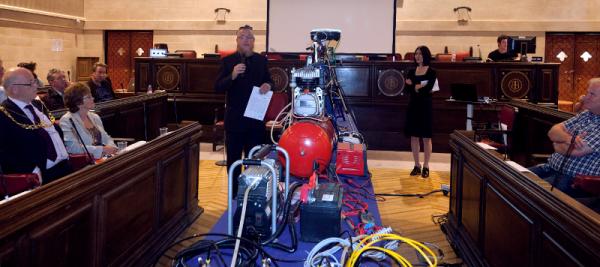

MG: Many are aware that technology and digital culture have changed the world we live in and appreciate their immediate effects on our everyday behaviours and situations. But there is a bigger story to tell, and history can offer us insightful glimpses, important clues and ways into this story about our relationship with technology and digital culture. One of the arguments outlined in your book ‘Digital Culture’ is that digital culture is neither radical, new nor technologically driven. With this in mind, which past developments do we need to acknowledge and be reminded of and why?
CG: For me the emergence of digital technology is part of a much longer story of abstraction, codification, quantification and mathematisation that can be traced back to numerous points in the history of the West, from Ancient Greece, to early Modernity to the rise of industrial capitalism. Here one might think of Heidegger’s use of ‘cybernetics’, a word we normally associate with post-war computing culture, to describe the technology and calculative enframing of modern society which he traces back to the Ancient Greeks and especially to Plato. I am not a particular advocate of digital technology, and while I appreciate its uses, I also think we must try to be aware of how it determines the way in which we think, and in which we conceive of the world. Above all we should not regard it as merely a conduit to an uncomplicated world simply out there, but rather the means by which a particular world comes to be for us. That said, this is very hard, given that in my view, and to adapt a well-known phrase from Derrida, il n’y a pas de hors-media, there’s no Archimedean point outside of our medial condition, from which we can understand it as from a god’s eye view. ‘Media determine our situation’ as Friedrich Kittler put it.
MG: In Digital Culture, you write about the composer John Cage and how he “has had the most profound influence on our digital culture”, and how his influence has opened up various different avenues of creative engagement. And, many of his ideas on interactivity and multi-media not only “have repercussions in the art world”, but also a strong influence on how computers are used as a medium. Which art movements in particular did he influence and what kind of legacy did he leave for others in relation to computers?
CG: Actually Cage’s influence on those using computers in the arts is probably less to do with what he himself did with such technology and more to do with his use of aleatory methods in many his different projects across many artforms. Also there is something about Cage’s own refusal of a normative Western subjectivity that is also consonant with aspects of our hyper-technologised existence with its emphasis on decentering the individual. Both the refusal of such subjectivity and the aleatory work together to produce a new model of the artist as conduit of contingent social forces rather than protean demi-urge or genius.
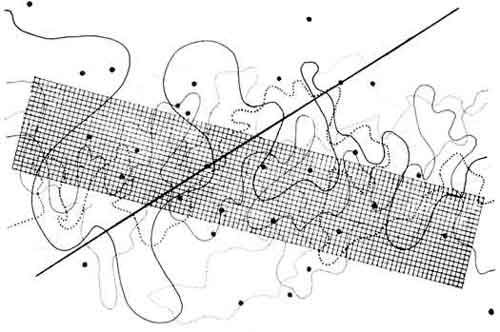
MG: Your new book ‘Community without Community in Digital Culture’, has come out at the same time as Geert Lovink’s ‘Networks Without A Cause: A critique of Social Media’. Lovink asks “How do we overcome this paradoxical era of hyped-up individualization that results precisely in the algorithmic outsourcing of the self? How do we determine significance outside of the celebrity paradigm and instead use intelligence to identify what’s at stake?” [1]
Where are your thoughts in regard to Lovink’s question, and does it relate to what you propose in terms of “hospitality to the other?”
CG: I haven’t read Geert’s book, yet at least… But I am highly sympathetic to what I take to be his position. My view is that the Web is part of a broader set of developments that apparently concern relationally, but actually emphasize the sovereign individual and autonomous subject of modernity, as well as promoting spectacular and image-bound forms of presentation and relation. The problem is that one alternative to this individualization is a kind of fascistic identification with the mass, in the form of fusion that negates the individual. A solution maybe to engage with the idea of the other in terms of difference, as both relational and separate, and yet also that which we depend on for our identity in a process of differentiation; thus the idea of hospitality as a reception of the other in difference.
MG: Community without Community in Digital Culture, is a curious title. It proposes contradictory meanings and these contradictions are clearly explained in the introduction. Although, the last sentence says “In this such technologies are part of the history of the death of God, the loss of an overarching metaphysical framework which would bind us together in some form of relation or communion. This can be understood in terms of contingency, which has the same root as contact.”
Could you unpack this last sentence for us, I’m especially interested in what contingency means to you?
CG: I owe my understanding of contingency to the work of philosopher Quentin Meillassoux, whose book After Finitude is causing a stir. Meillassoux is one of a small number of young philosophers sometimes grouped together under the name ‘speculative realism’, mostly because of their shared hostility to what they call ‘Kantian correlationism’, the idea that there can be no subject-independent knowledge of objects. Meillassoux follows the work of David Hume, who questioned the whole notion of causation; how one can demonstrate that, all things being equal, one thing will also cause another. For Hume causation is a question of inductive reasoning, in that we can posit causation on the grounds of previous experience. Meillassoux pushes the implications of Hume’s critique of causation to a point beyond Hume’s own solution, to propose the only necessity is that of contingency, and that everything could be otherwise, or what Meillassoux calls ‘hyperchaos’.
![Community without Community in Digital Culture [Hardcover]. Dr Charlie Gere. Palgrave Macmillan (2012) http://www.barnesandnoble.com/w/community-without-community-in-digital-culture-charlie-gere/1110025572 See on Amazon.](http://www.furtherfield.org/wp-content/uploads/2012/09/179510500.jpg)
I use his ideas to think through the implications of the ‘digital’. According to the Oxford English Dictionary ‘digital’ has a number of meanings, including ‘[O]f, pertaining to, using or being a digit’, meaning one of the ‘ten Arabic numerals from 0 to 9, especially when part of a number’, and also ‘designating a computer which operates on date in the form of digits or similar discrete data… Designating or pertaining to a recording in which the original signal is represented by the spacing between pulses rather than by a wave, to make it less susceptible to degradation’ (the word for data in the form of a wave being ‘analog’).
As well as referring to discrete data the dictionary also defines ‘digital’ as ‘[O]f or pertaining to a finger or fingers’ and [R]esembling a finger or the hollow impression made by one’, thus by extension the hand, grasping, touching and so on. Much of the book concerns deconstructing the ‘haptocentric’ implications of contact, and communication, especially in relation to the claims made for social networks, and to engage with what I understand as the relation between ‘contact’ and contingency’. ‘Contingency’ is derived from the Latin con + tangere, to touch. ‘Contingency’ enables us think through the implications of the term digital, by acknowledging both its relation to the hand and touch and also to the openness and blindness to the future that is a concomitant part of our digital culture after the death of God.
MG: What other subjects can we expect to read about in the publication?
CG: Touch in Aristotle and medieval theology, cave painting, mail art, Darwin and Dawkins, Luther Blissett, On Kawara, Frank Stella, Bartleby the Scrivener, Christianity – among other things… oh, and a lot of Derrida.
MG: If there is a message you’d like to send to the world, as it carries on regardless with its “permanent exposure of life, of all lives, to ‘all-out’ control […] thanks to computer technology” [2] (Virilio 2000), and it was printed on a banner, or on a billboard in the streets, what would it be?
I am reading Blanchot at the moment, so perhaps something like ‘the disaster has already happened’ (it’s suitably enigmatic to annoy people).
<———————————- The End (for now) ——————————>
Featured image: “Born in 1987: The Animated GIF” from the site’s page.
Marc Garrett interviews Katrina Sluis, the new curator of the Digital Programme at The Photographers’ Gallery, London. We discuss about the gallery’s recent show Born in 1987: The Animated GIF and what kind of digital exhibitions and projects we can expect from the gallery in the Future.
An edited selection shown on the London Photographers’ Gallery’s new digital wall, during the final weeks of the show. http://thephotographersgallery.org.uk/the-wall-2
The exhibition microsite. An open conversation where anyone can join in and contribute their own GIFs. http://joyofgif.tumblr.com/
Marc garrett: You have joined The Photographers’ Gallery and as part of the new digital programme launched the exhibition “Born in 1987: The Animated GIF”. Could you tell us about this project?
Katrina Sluis: The digital programme presents projects both online and offline, which respond to recent dramatic shifts in the digital image as it becomes increasingly screen-based and networked. As part of this new programme we have launched ‘The Wall’ – a permanent exhibition space on the ground floor of the Gallery, visible both to visitors and passersby on Ramillies street. The Wall itself is a 2.7 x 3m Sharp video wall which we installed after considering a number of different technologies. We were conscious not to use digital projection as it would locate the project within traditions of cinema and video art, and we wanted the screens to respond to the reception and distribution of images within wider visual culture.
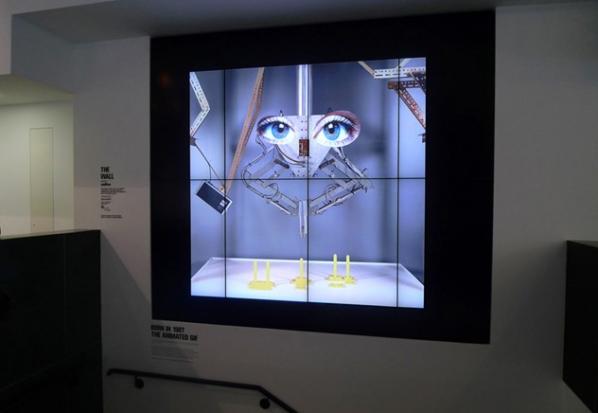
For the opening show, we decided to focus on the animated gif for a number of reasons. Firstly, the gif is a uniquely screen-based image format, in which the specific characteristics and limitations of the image file are inherent to the form, in contrast to the other kinds of images the gallery might show which might adopt digital techniques but result in traditional print-based photographic work destined for the gallery space.
I also wanted to disrupt certain expectations about the screens – the fetishisation of resolution and image quality, and what kinds of photographs The Wall’s programme might seek to address. The animated gif in this sense is very interesting – it is one of the first image file formats native to the web, and although it is 25 years old this year it has been undergoing a resurgence on platforms such as Tumblr. In a commissioned essay for the show, Daniel Rubinstein speculates that current resurgence of the gif “is not only part of the nostalgic turn towards the blurred, the unsharp and the faded but it is also a marker of a moment when the history of the network becomes the material from which the digital image draws its living energy.”[1] Frequently authorless and contextless, the gif image works on a different economy in which its value is based not on its uniqueness and scarcity (as in certain forms of art) but its circulation and proliferation. Although there have been significant practitioners of the gif form, it is a format which ultimately resists canonization. And, in the context of a photography gallery, it opens up other debates concerning medium specificity and the ‘post-photographic’.
In approaching the exhibition, I was keen to ask a diverse range of photographers, writers, organizations and other practitioners to contribute a gif for the show. In keeping with the unmonumental nature of the form, I asked contributors to respond within a short timeframe of 7 days. For many contributors, this was the first time they had made a gif; but other contributors already had large followings on Tumblr and some were established net artists. This opening show and associated Tumblr site (http://joyofgif.tumblr.com) became a starting proposition for the project in order to then open up The Wall to gif contributions from the wider public. We will continue to update The Wall with public responses on a daily basis until the final day of the show on 10th July.
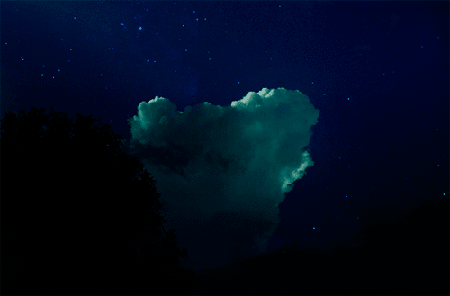
MG: At first, some may assume that the first part of the exhibition title ‘Born in 1987’, refers to the fact that today so many young people using computers these days were born in 1987. Yet, the GIF format, short for ‘Graphics Interchange Format’, was introduced to the world of computers by CompuServe in 1987. Was the title of the show deliberately playing with both notions?
KS: I like this idea! The title does self consciously play with the way in which the digital is valorised for its endless ‘newness’ and novelty but yet has this long and frequently overlooked history of creative experimentation. You can also see this reflected in the recent hype around the work of Kevin Burg and Jamie Beck who have (problematically and entrepreneurially) re-branded the gif as the ‘cinemagraph’.
MG: Do you consider this project to be net art, if so, how does it relate to other forms of net art?
KS: The project (and The Wall’s programming) does pose certain problems as it seeks to relocate certain forms of online practice(s) into the space of the art museum. At the same time, the project exists in an online context with its own very different life on Tumbr, where the work circulates in a very different context with a very different audience. I think there are many interesting opportunities which emerge from this intersection of the institutional frame of the museum (with its associated issues of cultural and curatorial authority and the legacy of aesthetic modernism) and the values and politics which inform certain kinds of networked arts practices.
But I also think the project also needs to be understood in the specific context of The Photographers’ Gallery, its history and audience. Whilst the project shares the concerns of net art by raising questions concerning authenticity, authorship and ‘the social’, it is also motivated by the need to rethink familiar notions of photography and temporality, indexicality and the economy of the image – concerns which presently haunt the field of photography theory.
![Kennard Phillipps. GIF image by Peter Kennard and Cat Phillipps. Born in 1987: The Animated GIF. The Photographers' Gallery 2012 [2]](http://www.furtherfield.org/wp-content/uploads/2012/07/fuck-the-markets-latest1.gif)
![Rad Racer glitch 3. GIF image by tracekaiser. Born in 1987: The Animated GIF. The Photographers' Gallery. 2012 [3]](http://www.furtherfield.org/wp-content/uploads/2012/07/tumblr_m5tqfl62wl1qew2moo1_400.gif)
MG: In what way do you see this form of creativity relating to others who may not be so well versed with net art culture, or digital networked practices?
KS: The Wall presents an opportunity for the Gallery to collaborate with diverse communities who can bring their distinct expertise and experiences to the programme, and the net art community has much to offer in this respect. For this reason, we aim to develop The Wall’s future programme through the framework of ‘collaborative research’, in which our audience, along with the organizations we partner with, are potential co-researchers. The co-researcher model developed as an approach to research democracy in the Social Sciences, particularly in the approach of Action Research in the NHS but in a more relevant cultural example was used extensively in the Tate Encounters: Britishness and Visual Culture research project. Co-research recognises both the collaborative and collective nature of meaning construction, through a process which attempts to trace and reveal the complex manufacture of meaning.
At the same time, there is still another related project to be done in highlighting and responding to digital projects whose life is online – this is of course something I admire Furtherfield for doing so brilliantly. On a smaller scale and with a more narrow focus, we hope to launch a blog which will draw attention to online work which relate to photography as it becomes polluted, valorized, hybridized and networked.
![GIF image by Paul Flannery. Born in 1987: The Animated GIF. The Photographers' Gallery. 2012 [4]](http://www.furtherfield.org/wp-content/uploads/2012/07/tumblr_m442xish4q1rvlji4o1_500b_0.gif)
MG: Some, may view this this exhibition as relating to Internet Folk Art. There is an interesting article by Kenneth Goldsmith[1] where he discusses the digital theorist Rick Prelinger’s claim “that archiving is the new folk art, something that is widely practiced and has unconsciously become integrated into a great many people’s lives, potentially transforming a necessity into a work of art.”
Now, this is not directly relating to the show itself, but it resonates something regarding the inclusiveness of the show. So, in respect of it ‘possibly’ possessing aspects of Folk Art, what connections do you see as relevant or not, and what does it mean to you?
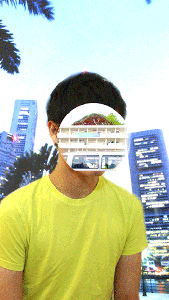
KS: By focusing on the gif the show does problematise the distinction between artist and audience, in which participation, openness and the ‘crafting’ of the image becomes key. However I have reservations about the use of the term Internet folk art, which could be construed as imposing a certain modernist logic on the discussion, burdening it with an analogue modeling of high and low culture. The research approach has been adopted precisely to avoid the trap of binary nominalism, and to problematise the tendency to shoe horn internet practices into the language of cultural studies and aesthetics.
MG: The Photographers’ Gallery was the first independent gallery in Britain devoted to photography and has been going since the 70s. It is the UK’s primary venue for photography and has been dedicated in establishing photography as an essential medium, representing its practice in culture and society. It seems that The Photographers’ Gallery is going through another transition. You have already mentioned how hybridized and networked the nature of future projects will be. So what kind of exhibitions and projects can we expect in the future?
KS: Because digital technology is not in itself a new photographic medium, but essentially a hybrid and converged set of technological practices, it raises many interesting problems, both theoretical and practical for a Gallery focused on photography. To the computer, the photograph is indistinguishable from the other binary blobs of data we used to call books, films and songs. The crisis of digitization and medium specificity now extends to the domain of the camera – Digital SLRs are coveted for their ability to shoot high quality digital video, and we turn to our mobile phones when we want to take snapshots. This is a very rich context for the programme to explore, and ideally the future projects will respond to the technical, creative and cultural languages of photography as produced by computer engineers, web developers, photographers, artists, networked communities, social scientists and other practitioners.
Our next show on The Wall (opening 13th July) features the practice based research of Susan Sloan into portraiture using motion capture and 3D animation techniques widely used in entertainment, medicine and the military. Her motion studies refer to the traditions and conventions of portraiture and the changing role of the camera as a recording device. At the same time, her work raises questions concerning the convergence of painting, animation, film and photography in the digital realm.
The future digital programme which will occupy different spaces and address various photographic practices including augmented reality, social media, electronic publishing, interactive media, mobile computing and synthetic imaging.
The Joy of GIF – the London Photographers’ Gallery’s new digital wall. Article by Wendy McMurdo.
http://www.foam.org/foam-blog/2012/may/photographers-gallery
So Alan Turing was born 100 years ago today. More or less every esteemed field of technological discovery has been plugging certain events and exhibitions surrounding the Turing centenary this week, each one steadily demanding a greater recognition of Turing’s astonishing legacy and achievement. There have been articles aplenty; some seeking to identify Turing alongside other persecuted scientists. Others argue that Turing’s achievements should be listed alongside calculus and relativity – perhaps something which should have been common-place anyway given the precarious computer age which surrounds us – (rather bewilderingly, despite the increased media coverage the UK Government are still failing to issue a full pardon for Turing’s shocking treatment in the last two years of his life).
It’s a testament to Turing’s fascination with nearly everything that 76 years since his first major paper, there’s still so much to write about his work. Expect this week to offer more events and glimpses into these projects: Neuro-computational studies into the functional basis of cognition. The ever forward march for genuine artificial intelligence. New methods of simulating the complexity of biological forms nearly 60 years after Turing’s paper on the chemical basis of morphogenesis (indeed this area of complexity theory is now an established area of major research). The slippery mathematical formalist discoveries which define what can or cannot be computed. And not forgetting key historical developments in cryptography, perhaps the field which Turing is most respected for. Moreover, Turing wasn’t just one of the greatest mathematicians of the 20th Century, but also one of the greatest creative engineers; someone who wasn’t afraid of putting his ideas into automation, through the negotiation of materials.
So for the positivist sciences and technological engineers, Turing’s curiosity continues to bequeath low hanging research fruit ready to be picked. But what of the arts and humanities? How have they contributed to the Turing centenary? How are they influenced by Turing?
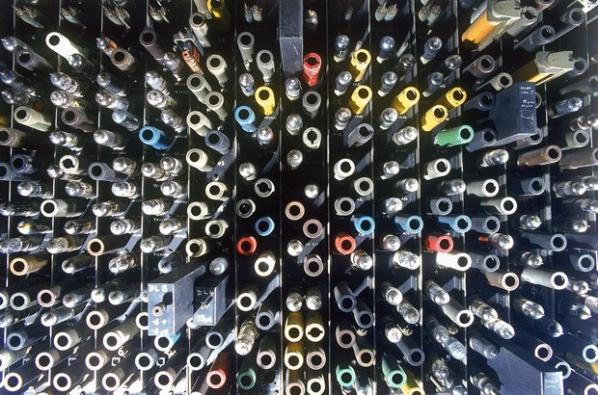
Indeed, its always more deeper than is actually realised. Clearly, in Analytic Philosophy where cognitive science is dominant, Turing’s legacy continues to elevate epistemological, ethical or moral questions about the nature of the human mind – with many offering high bids on the future foundation of a computable brain, by reducing the cognitive understanding into its putative evolved material constituents (see Daniel C. Dennett’s recent article in The Atlantic) – Others completely vilify the idea that consciousness could ever be fully engineered. Others speculate (naturally).
In the arts, a special Alan Turing centenary committee has been set up to fund art projects which deal with Turing’s legacy in various ways. The “Intuition and Ingenuity” exhibition in particular features work by Ernest Edmonds amongst others. In a more direct link, the mathematician Robert Soare has even argued for the existence of a pesudo-cryptic ‘Turing Renaissance’, establishing a link between classical recursion theory and the classical art of the Italian High Renaissance (which has more than a potent ‘Da Vinci Code’ whiff about it).
Some academics have chosen to focus on the biographical details of Turing’s own short life. In particular Homay King (and I only found out about this in conversation last week) has offered key insights into Turing’s research methods using Queer Theory, not simply because Turing was openly gay and speculated on thought experiments involving gender, but because Turing wanted to understand peculiar sociabilities of ambivalent miscommunication. Evan Selinger has written a recent article on how social scientists are using the “Turing test” to observe and understand deception in social groups. And also influenced by these same deceptive qualities, Prajwal Ciryam clarifies its influence on psychopathy and predicting when a psychiatric patient should be released. Here, difficult questions emerge as inspired by the difficult questions Turing himself raised, even if the fields wildly diverge from his own.
But here’s a question – could the arts and humanities move further into Turing’s legacy than admirable commentary on specific biographical revelations of his life, or questions which bother cultural ambiguity?
Perhaps we should ask whether the Turing Centenary will actually convince the humanities and the sciences to attentively read Turing’s work? Forgive the disingenuous patronising structure of the question; I clearly realise that people have read Turing’s work, especially his most famous and readable article, Computing Machinery and Intelligence published in 1950. But think back, have you actually read it?
Written off the back of a report done for the National Physical Laboratory between 1948-1949, Turing’s succinct article famously speculated on machinic intelligence, as well as launching the infamous Turing Test (the moniker “Turing Test” is a bit of a misnomer, Turing himself called it an imitation game). And yet, it strikes me as absurd that more hasn’t been written on how strange, bizarre, hysterical, paradoxically informal and wonderfully written this text is, as a text. Especially since it is a text which is often considered ‘scientific’ and ‘academic’ as opposed to ‘mere literature’.
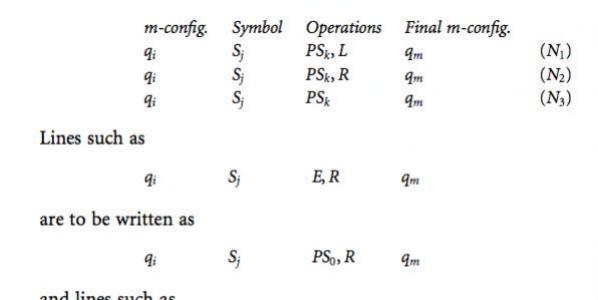
In a 2008 article, which again, no-one seems to have read (‘Powers of the Facsimile: A Turing Test on Science and Literature‘, written for an edited collection on the novelist Richard Powers) – Bruno Latour makes this strategic point about the ambivalent qualities of Turing’s 1950 article. For him, Turing’s text contains not clear analytic rigour, but “metaphors, tropes, anecdotes, asides and self description”; features of what he calls “matters of concern”. Turing considered the idea of machines having intelligence through the “most bizarre, kitschy, baroque text ever submitted to a scholarly journal“. Latour even jokes that Alan Sokal would no doubt have interpreted it as a hoax. It’s no wonder that Turing’s friend and logician Robin Gandy said of the essay that, “it was intended not so much as a penetrating contribution to philosophy but as propaganda […] He wrote this paper – unlike his mathematical papers – quickly and with enjoyment. I can remember him reading aloud to me some of the passages – always with a smile, sometimes with a giggle.“
“The problem” Latour states, “is that people never read.” Well, by ‘reading’ Latour means that the analytic sciences didn’t really pay attention to what Turing is saying. Even worse, some just ignore the deliberate ambiguity of Turing’s text by reading through it as a transparent window onto whether the mind is computational in nature or whether machines can actually think or not (a question which in the same article and subsequent lectures, Turing considered “too meaningless to deserve attention”, as well stating that his aim wasn’t to give a definition of thinking).
This, for Latour, begs a different type of Turing test; can one distinguish between a Richard Powers novel of realist literature (an exposition of which is given in the first half of the paper) and the scientific realism of Turing? If one is sufficiently fooled, then Latour “will have at least indicated that matters of concern might be best accessible through the joint inventions of literature and science.” And it’s here where the humanities and the arts should claim Turing as a kindred spirit, for Latour’s test terminates any significant difference between “an important scientific text and an important novel” precisely insofar as one cannot distinguish “dealing with demonstrations while the other deals with rhetoric, one dealing with proofs while the other deals with stories[…]” Turing had the nerve to slice and dice allusive, eloquent and creative persuasion together with an empirical understanding of electrical computation. I doubt various scientific proponents of the Turing centenary would take this significance with much seriousness, but I’m convinced artists and literary scholars would do.
So this begs a question, which should resonate loud and clear on Turing’s 100th birthday. What happens when we treat Turing even more seriously; not just as a mathematician, engineer or scientist, but also as a cryptic creative thinker and writer? What happens if we follow his words and not just his conclusions (although certainly the conclusions are worth following, if not extensively by others).
One element which stands out time and time again, is how much Turing was influenced by the reality of unproved conjecture rather than designating reality through deductive proof. This isn’t a quirky coincidence. Turing’s negative solution to Hilbert’s decision problem in his equally famous 1936 paper On Computable Numbers – the paper which conceived the computer as an abstract mathematical concept – showed that there was an intrinsic paradox at the heart of automation. It’s impossible to systematically predict what a certain function will do before you execute it. So in Turing’s 1950 article, we shouldn’t be at all surprised when he espouses the following point;
“The popular view that scientists proceed inexorably from well-established fact to well-established fact, never being influenced by any unproved conjecture, is quite mistaken. Provided it is made clear which are proved facts and which are conjectures, no harm can result. Conjectures are of great importance since they suggest useful lines of research.” Computing Machinery and Intelligence, p.49.
Another point of semblance is how uninfluenced Turing was by the work of his peers. Max Newman one said of him that it was a “defect of his qualities that he found it hard to use the work of others, preferring to work things out for himself.” I very much doubt it was a defect. To consider it so, probably undermines what was so particular and unique to Turing’s creativity. Turing wasn’t persuaded by other interpretations of computing machines other than his own personal tinkering, and this leads to some important insights worthy of aesthetic concern.
For instance in a surprisingly frank passage, Turing lays bare how little knowledge he has when it comes to speculating on the constructions he himself had constructed.
“A better variant of the objection says that a machine can never “take us by surprise.” This statement is a more direct challenge and can be met directly. Machines take me by surprise with great frequency. This is largely because I do not do sufficient calculation to decide what to expect them to do, or rather because, although I do a calculation, I do it in a hurried, slipshod fashion, taking risks. […] These admissions lay me open to lectures on the subject of my vicious ways, but do not throw any doubt on my credibility when I testify to the surprises I experience.” Computing Machinery and Intelligence, p.56-57.
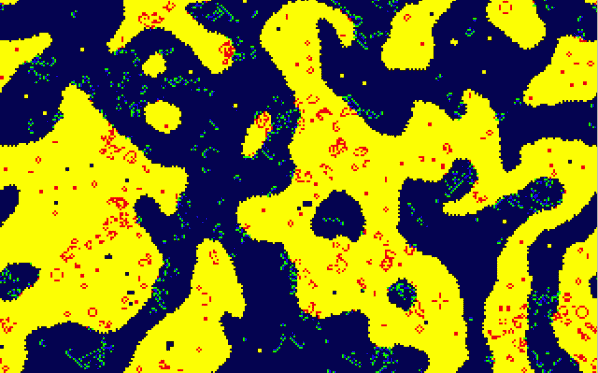
If Turing – the godfather of universal computation – had little knowledge on the output of his own discovery, what does this say about us now? (what does it say about Google’s own recent tribute?) Turing’s famous article lays bare a different interpretation; that he certaintly didn’t envisage computers as simple communication tools for human whims, but did he indirectly expose automatons with agency. What the hell is an automaton?
How he came to define what this agency is, was brutally cut short. However it’s clear from his work on morphogenesis (which Turing began at the same time as his theoretical forays into machinic thought) that some preliminary form of complexity theory was the way forward. It certainly undermines the positivist wing of artificial intelligence research which invests in some predictable form of knowledge where machinic intelligence can only be ‘known in advance’ when it passes for sentience. Do real world formal language systems already contain the type of surprising ambivalence which Turing noticed? Furthermore, do machines experience this level of ambivalence between each other themselves? This is a question which the transparency of analytic rigour and scientific provability would remove for being undisciplined. Turing’s own words suggest otherwise.
In a subsequent lecture broadcast on BBC Radio in May 1951 called “Can Digital Computers Think?“, Turing elaborates on this further using some exquisite metaphors and analogies;
“It is not difficult to design machines whose behaviour appears quite random to anyone who does not know the details of their construction. Naturally enough the inclusion of this random element, whichever technique is used, does not solve our main problem, how to programme a machine to imitate a brain, or as we might say more briefly, if less accurately, to think. But it gives us some indication of what the process will be like. We must not always expect to know what the computer is going to do. We should be pleased when the machine surprises us, in rather the same way as one is pleased when a pupil does something which he had not been explicitly taught to do.”
We have here, in the pangs of its birth, a self-confessed weird quality to the construction of computing in its preliminary stages. It’s this otherness, notably absurd quality to the agency of computing which the humanities (and especially the digital arts) could re-appropriate for it’s own unpredictable ends.
And to some extent this hardly exists as new territory for practising artists who began working with early structural computing systems from the late 1960s – the surprising reality of deterministic rules. I’m sure many artists and programmers, especially those who constantly negotiate their way through complex compilers, stack libraries, code, bugs, glitches and information loss, testify to the same surprises that Turing experienced. For it was Turing who originally suggested that writing and mechanism were almost synonymous.
While I’m sure no aficionado of the Turing Centenary would refute our own particular conjecture, they wouldn’t admit to a conflict between the rhetorical primacy of Turing’s text against the dominant and subsequent scientific uptake. For while the sciences of predictability continue to locate Turing’s legacy as their own, they leave open the chance for the humanities to account for the unpredictable qualities of Turing’s legacy which are ignored. I look forward to the next 100 years.

“Human Readable Messages_[Mezangelle 2003-2011]” is a book published by Traumawien containing almost a decade of Mez Breeze’s “Mezangelle” writings. Mezangelle is hand-crafted text with the aesthetics of computer code or protocols. What marks Mezangelle out is how deep its use of those aesthetics go and how effectively it uses them.
Computer programming languages have their own logic, and it is not captured by holding down the shift key and bashing the top line of the keyboard to add what looks like a cartoon character swearing or random line noise to text. It’s true that programming languages can look incomprehensible to the uninitiated. This Perl code:
y/A-Za-z/a-zA-Z/
will swap the case of lower and upper case English letters. But the conciseness of this notation hides a clear informational structure only in the same way that mathematical or musical notation do.
Likewise the markup language HTML that this article is written in:
<p>looks “<em>gnarly</em>”</p>
and a computer protocol such as email transmission via SMTP:
220 smtp.example.net ESMTP Postfix EHLO someone.example.org 250-smtp.example.net Hello someone.example.org [192.0.2.201] 250-SIZE 14680064 250-PIPELINING
is incomprehensible without reference to detailed technical documents. But all express clear semantic structures and instructions to the computer systems that have been programmed to understand them.
These notations have been created to express data and concepts in structured ways that are possible for computers to work with. They may look typographically arbitrary but they do involve aesthetic choices and historical precedent. They have associations, they have resonances.
We do not usually see the codes involved in our use of computers and the Internet when they function effectively, but they are always there. When they successfully empower or coerce us they become invisible. In the age of social networking, ecommerce, and mobile devices they are pervasive.
What, then, are we to make of Mezangelle? Human written, but intentionally structured in the style of computer code, it recreates the expressive, communicative underpinnings of software syntax rather than simply its surface aesthetics.
To read Mezangelle is to parse it. Parsing in computer software is the process whereby a computer breaks down textual input into smaller and smaller but more and more closely related chunks of meaningful information. Parsing Mezangelle requires the human reader to group and regroup word fragments into shifting webs of meaning. It takes time to do this, and different textual characters and formatting take different amounts of time, adding rhythm and pacing to the meaning of the text.
The history of literary typography, of mathematical notation, and of programming language design has lent a rich range of often contradictory precedents both to software and to writing that draws on its aesthetics. A dot can mean a fraction or a part of an object. A square bracket can instruct a computer to construct a list in memory, to access an element of an array, or to send a message to an object. As can a colon or two, or various arrows. Hashes can indicate comments, identifier numbers, or other entities.
The raw typographic aesthetics of character glyphs spring from their visual form (smooth, straight, long, slanted), size, and relative visual complexity. A full stop or a vertical bar is simpler than a hash or an ampersand. These factors affect how long it takes to perceive them and the effect they have on the eye as we look across them. The glyph-level and code level visual arrangement of code affects the pacing of our reading, building pace and meter. The more semantic aesthetics of the way these glyphs are used to structure code build on and interact with this. And it affects the relations and meanings that we build as we read the text.
Like computer program code, Mezangelle structures its content in order to communicate to and invoke the resources of its parser. Crucially this is a human parser rather than a software one so those resources are aesthetic and cultural. As well as pacing the experience of the text as spoken performance would, these destabilize and expand its meaning as the attention of critical writing does.
The intrusion of quoted plain English text such as an Alan Sondheim piece or an email from a mailing list that have been the inspiration for an answering piece of Mezangelle serves both to show how different Mezangelle is from written English and how effectively it can be part of a conversation.
Here is a line of Mezangelle (broken by the format of this page):
.. my.time: my time: it _c(wh)or(e)por(ous+h)ate_ _experience____he(u)rtz___.] [end]
Read as code, the underscores mean private data and variables, the square brackets mean list construction, message passing, references to individual elements of data structures. The full stops are decimal fractions or references to data or functions that are parts of larger objects. They do not decorate (in the sense of being frivolous), they evoke.
They also semantically structure and pace, allowing reading and re-reading as poetry. Underscores creates distance, brackets group and shift the meaning of words and fragments of words. Addition signs and colons combine concepts and further disrupt the parsing of language as a flat, linear, structure.
Mezangelle is distinct from much historical code poetry in its structural and semantic mastery of the aesthetics of code. It is distinct from concrete poetry in its semantic, destabilizing, temporal rather than merely structural use of typography.
Mezangelle is net art, it is produced and encountered in the environment of the Internet. Mezangelle lives in blogs and on mailing lists. But it does not die on the printed page, far from it. “Human Readable Messages” is typeset in Donald Knuth’s Computer Modern font, a beautifully spindly artifact of the early days of computer typesetting, with the occasional intrusion of Courier-style monospaced teletype/typewriter fonts. This gives the printed text a digital, online feel retaining a genetic link to the environment it originated in.
Mezangelle surfaces and integrates the hidden aesthetics of computer mediated human activity, setting computing and human language in tension and synthesizing them. It expands the expressive possibilities of text and is a form of realism about the conditions in which human reading is currently flourishing. “Human Readable Messages” provides an ideal opportunity to familiarize ourselves with Mezangelle in the depth that it deserves and rewards.
The text of this review is licenced under the Creative Commons BY-SA 3.0 Licence.
Anonymous, untitled, dimensions variable is the title of a show by 0100101110101101.ORG (Eva and Franco Mattes) at Carroll/Fletcher gallery in London from 13th April to 18th May 2012. Or at least it was. The title changes each day based on submissions to a blog (http://exhibitiontitlechange.tumblr.com/). The new titles have been printed out and displayed on the wall to the left as you walk in to the gallery.
You don’t expect this kind of playful intersection of the virtual and the real in a gallery off of Oxford Street, across from Soho, opposite other new galleries. Carroll/Fletcher’s glass-fronted welcomingly brutalist interior says “serious contemporary art space”. Inhabiting such a space presents a challenge to net and digital art that must be met with careful presentation and considered curation.
Through the glass front of the gallery, and as you enter, you see a sculpture or assemblage of a (stuffed) cat trapped in a birdcage by a (stuffed) canary (Catt, 2010). The cat has suffered Epic Fail as the Internet would say, and did in the meme image that the sculpture is based on. It’s a comic and unnerving object even without the extra layers of reference provided by the original meme and the knowledge that it was originally presented as a fake Maurizo Cattelan sculpture. It is art with its roots in the net that can stand on its own without that context. Its companion piece, Rot, 2011, is a fake Dieter Roth sculpture consisting of detritus in a glass jar on a plinth against the far wall. 0100101110101101.ORG briefly inserted it into the Wikipedia page on Roth, and the fact that its materials were all ordered via the Internet drives home just how commonplace this has become.
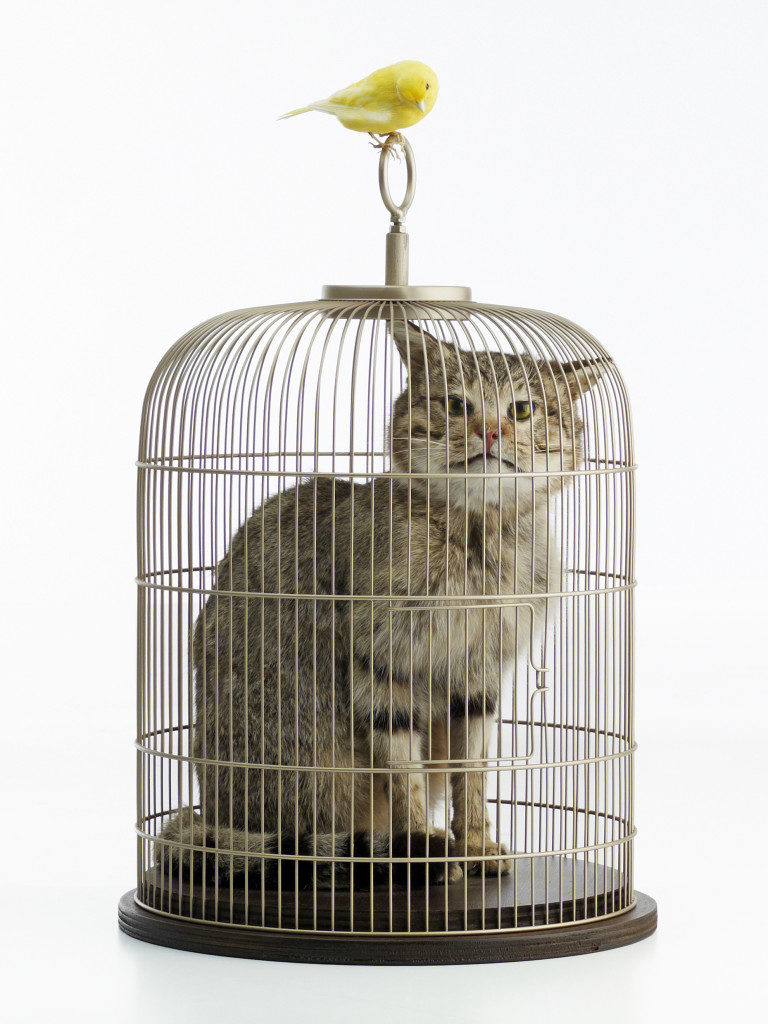
Both are given the room they need to work as objects in a gallery. Neither originates in itself as net art, more in 0100101110101101.ORG’s history of tricksterism and transgression. These are concerns that are easily linked to net culture, possibly too easily on the part of the reviewer, but it is telling that they are the works that the show opens with. They physically establish the playful appropriation and hyperreality that is the basis of much of 0100101110101101.ORG’s work.
Pride of place in the first room of the gallery goes to the projection The Others, 2011, 10,000 digital photographs (supposedly) copied without authorization from the folders of computers used by people on a peer-to-peer filesharing network that 0100101110101101.ORG used to distribute their own work. These are private images, projected at an angle and slightly across the corner. Configure your peer-to-peer filesharing client wrongly and it shares all the files in the folder you share. Including the images of you naked, drunk, lonely, partying, or whatever else you wouldn’t post anywhere a future employer might find them.
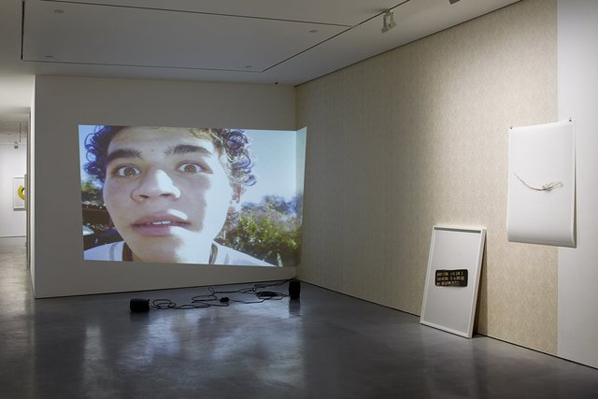
In the next, smaller, room is Colorless, odorless and tasteless, 2011. It is an old-fashioned car racing video arcade game retro-fitted with a petrol engine that starts up when you insert a coin and revs as you press the pedal to accelerate the virtual car on the screen, filling the (sealed…) room with carbon monoxide. Combining the virtual made physical of Catt and the moral impact of The Others, it is the most immediately dangerous artwork I’ve ever had to review.
Moving into the larger room at the back of the ground floor of the gallery, the video No Fun, 2010, is the most shocking piece in the show. Franco Mattes pretending to hang hineself on the random Internet webcam video chat switchboard Chatroulette is one thing, but the reactions of other Chatroulette users as they connect and see him apparently hanging there is quite another. Some laugh, some jeer, only one I watched displayed any lasting concern. This is the moral and aesthetic flipside of The Others.
Reenactments, 2007, is my aesthetic and technical favourite piece in the show. Videos of canonical performance art pieces being re-enacted by Eva and Franco’s Second Life avatars are displayed on CRT monitors arranged at floor level surrounded by the cables and adapters used to play back the video from SD cards. It’s much easier for an avatar to remain still as a “Singing Sculpture” than it is for a human being, making it even stranger, and Marina Abramovic’s “Imponderabilia” works much better with impossibly buff avatars than with mere naked human models stood in a doorway. It exquisitely foregrounds the social mediation of Second Life and its players self-presentation. A large cartoon wolf squeezes through between the naked avatars, their polygons intersecting. A vampire attempts to fly over them but hits the bounds of the architecture. The crowd in the background chat and bide their time. The virtual intensifies the real, out-doing and critiquing its appropriated source material.

Stolen Pieces, (1995, made public 2010) claims to move beyond fakery and unauthorized copying to physical appropriation. Stolen physical fragments of canonical postmodern artworks (Duchamp, Warhol, Koons, Rauschenberg) are displayed like forensic evidence, protected in small plexiglass containers, accompanied by large photographs of them and by documentary evidence of their theft. There’s no statute of limitation on theft in the UK, and damaging artworks shouldn’t be applauded. But it’s a daring performance and a concrete critique of the fetishism that lies at the heart of the art market and the institutions that help drive its value.
Following the brutalist concrete staircase to the basement reveals My Generation, 2010, a smashed but still working early-2000s PC lying on the floor. On its monitor, that appears to have fallen on its side, show video clips of computer game players giving in to and venting their frustration at the games they play. This isn’t the kind of image of yourself you want as your lasting monument on the Internet. Gathered together, like the images in The Others and the videos in No Fun, they again form a summation of an aspect of society and our visual environment that could not be achieved with such immediacy by other means. And the clear space and architectural solidity of the gallery again help to put a different emphasis on the material than if it was encountered on the web.
The wall-filling video projection of Freedom, 2011, records Eva’s attempts to plead with the players of networked First Person Shooter computer games not to kill her character. Touch-typing might have helped, but even when Eva manages to type long enough to explain that she’s an artist, or to ask people not to shoot, the social and game logic of the virtual world mean that her character is executed again and again, the screen shifting to third person as her avatar moves out of her control in death. Like No Fun, there is a core of callousness to these Internet interactions, and like My Generation they are unexpectedly preserved and presented for contemplation.
The final piece in the show is the documentary Let them believe, 2010, a video record of 0100101110101101.ORG’s Tarkovsky-haunted journey into Chernobyl’s “Exclusion Zone” in order to recover part of a fairground ride to turn into Plan C, 2010. Bringing part of the ride to life in a place where people can enjoy it is an effective and resonant symbolic resolution of the kind that art more than any other mode of human endeavor can provide.
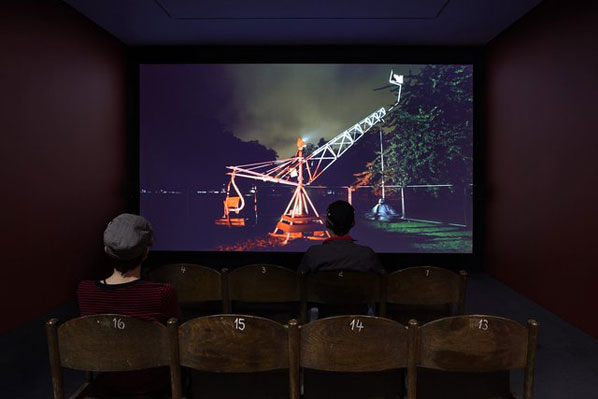
0100101110101101.ORG’s work presented physically has more than enough presence to fill the gallery and benefits from the space and the considered curation afforded it here. Some of the work is more physical than virtual and vice versa, sometimes the ethics of the work place 0100101110101101.ORG as the villain sometimes as the victim, and sometimes the work is performance whereas other times it is assemblage. I mention this to point out both the strong themes to the work and how individual the effect of each piece is.
Net art in the gallery might seem a category error, like museum postal art. Or it might seem a commodity, like auctions of land art documentation. But net art is transitioning from being the contact language of artworld emigrants learning the net’s protocols to the contact language of net emigrants learning artworld protocols. 0100101110101101.ORG have made art of these encounters from the start, and have always been as at home in the gallery as on the net.
The text of this review is licenced under the Creative Commons BY-SA 3.0 Licence.
Contact: info@furtherfield.org
DOWNLOAD FULL PRESS RELEASE HERE
See images from the opening of Invisible Forces on Flickr.
Scroll down for the video of the exhibition.
An exhibition about why contemporary life is so difficult for so many
Invisible Forces features the work of artist-visionaries: Kimathi Donkor, Laura Oldfield Ford, IOCOSE, Dave Miller, Edward Picot, and YoHa with additional game events, talks and workshops with Class Wargames, The Hexists, Olga P Massanet and Thomas Cade Aston.
Our social, economic and cultural institutions are being dismantled. Control over the provision of social care, urban and rural development, and education is being ceded to the market facilitated by unseen technological and bureaucratic systems.
Undeterred, the artists in this exhibition meet the challenges that ensue with clear eyes, spontaneity, experimentation and a sense of adventure. This selection of installations, digital video, net art, painting and drawings deal with conspiracy, money, politics and hidden signals.
As part of Invisible Airs, YoHa (Graham Harwood & Matsuko Yokokoji) attempted to read 20,000 comma separated lines of Bristol City Council’s apparently open-data. After which they understood that power reveals itself through multiple layers of boredom. They constructed four pneumatic contraptions which reveal the relations contained within the fields and the people affected. A video made by Alistair Oldham documents their art project Invisible Airs, Database, Expenditure & Power. Invisible Airs was commissioned by The University of the West of England’s Digital Cultures Research Centre (DCRC) in collaboration with the Bristol City Council’s B Open data project.

This is shown alongside Data Entry, a video that investigates how databases operate on us and through us by looking at the work of midwives and women in labour. “Databases move through us, allowing new forms of power to emerge… [they] order, compare, sort and create new views of the information they contain. New perspectives amplify, speed-up and restructure particular forms of power as they supersede others.”
Edward Picot is an artist and writer who also works as an administrator in the UK health service. His seriously funny soap-gone-wrong, Dr Hairy In…, chronicles the trials, tribulations and cogitations of an ordinary (but slightly hirsute) general practitioner – with hilarious results!* Dr Hairy’s struggles with NHS bureaucracy are brought to life in a series of satirical video shorts, featuring puppetry performances given by a child’s doll and screened in a doctor’s waiting room, as an installation. “It was like watching Team America set in the NHS” says Ian Hislop (broadcaster, editor of Private Eye and NHS patient).
Kimathi Donkor‘s Toussaint Louverture at Bedourete is a history painting made with oils on canvas that depicts an icon of anti-slavery struggles who, in his lifetime, was smeared as a reprehensible war lord. Created to mark 200 years since the independence of Haiti, the image shows the leader of the Haitian 1791-1804 revolution in a pose reminiscent of the Jacques Louis David’s Napoleon Crossing the Alps, surrounded by inspired revolutionaries in a battle that led to the creation of Haiti as the first slave free nation in history. In a short film by Ilze Black, Dr Richard Barbrook and Fabian Tompsett of Class Wargames interview Donkor about the work.
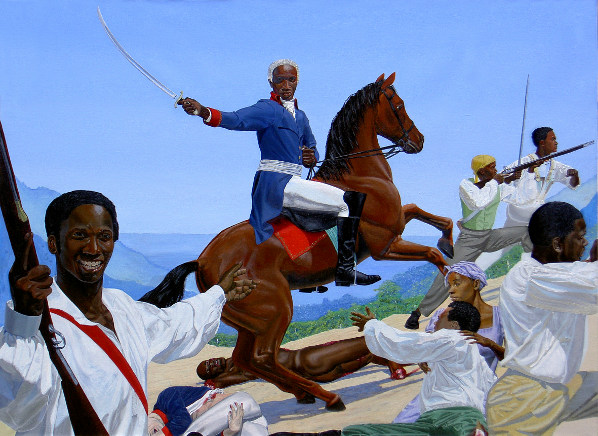
Laura Oldfield Ford‘s recent drawings are the result of walks (or ‘Drifts) through deserted urban spaces in the part of East London being prepared for the 2012 Games. They depict layers of failed utopias of the past and present and imagined futures. Known for her poetic and politically tuned ink drawings produced in print and online in her zine Savage Messiah, Oldfield Ford documents her psychogeographic explorations, in text and image, of the city as a site of social conflict, melancholy and political resistance.

Net artist Dave Miller presents two agitprop posters and a pamphlet of images reproduced from his interactive, multi-layered, online narrative bankers_bonuses. Miller worked with software he created himself to combine hand drawn illustrations with images gathered from Internet searches, and provocative (sometimes preposterous) statements made by powerful people about the ethical questions arising from the economic crisis.
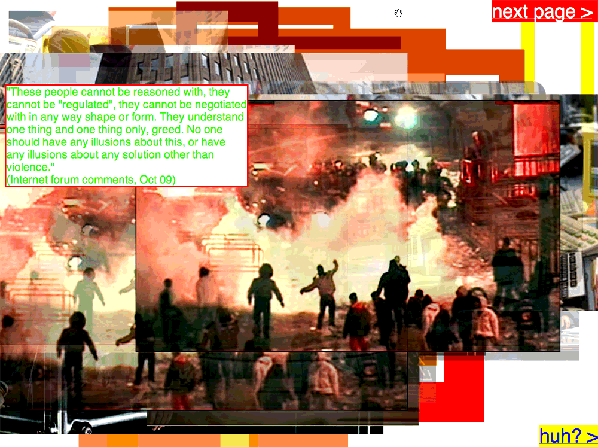
Italian artist group IOCOSE has created A Crowded Apocalypse, a net art project that exploits crowd sourcing tools in order to simulate a global conspiracy. The “crowd” assembles its own conspiracy and then protests against its protagonists and effects. A Crowded Apocalypse is commissioned by AND Festival and Furtherfield.
As we scan our cultures for maps, role-models, possible ways of living in today’s world, we often encounter images of society that are created by its hidden, controlling forces. By naming, revealing, tracking, playing, making, subverting and transforming tools, circumstances and figures that give rise to current crises we enlarge the debate and extend our freedoms. And the artists in this exhibition offer examples of just some of the ways in which this might be done.
* Important note. Dr Hairy In… is NOT a critique of socialised medicine and so we include a disclaimer: “The creators of this piece would like to point out that they all work in the National Health Service and are completely devoted to it.”
Free public play, games, making and discussion run alongside the exhibition.
Led by Dave Miller, The Hexists, Class Wargames, Olga P Massanet and Thomas Cade Aston. See HERE for details.
Rachel Baker (The Hexists)
Rachel Baker is a network artist who collaborated on the influential irational.org. Her art practice explores techniques used in contemporary marketing to gather and distribute data for the purposes of manipulation and propaganda. Networks of all kinds are “sites” for Baker’s public and private distributed art practice, including radio combined with Internet (Net.radio), mobile phones and SMS messaging, and rail networks.
Kayle Brandon (The Hexists)
Kayle Brandon is a inter-disciplinary Artist/researcher, whose work is sited within the public, social realm. She predominantly works in collaborative and collective fields; a working method which informs much of her ethos around the making of art. Her main areas of interest are in the relationships between the natural and urban worlds and Human/Non-human relations. She investigates this field via physical intelligence, provocative intervention, observation, self-guided exploration and collective experiences.
Class Wargames
Class Wargames is an avant-garde movement of artists, activists, and theoreticians engaged in the production of works of ludic subversion in the bureaucratic society of controlled consumption.
The members of Class Wargames are Dr. Richard Barbrook, author and senior lecturer in the Department of Politics & IR at the University of Westminster; Rod Dickinson, artist and lecturer at University of the West of England; Alex Veness, artist and co-founder of Class Wargames;Ilze Black, media artist and producer; Fabian Tompsett, initiator of London Psychogeographical Association and author; Mark Copplestone, author and figure designer; Lucy Blake, Software developer; Stefan Lutschinger, lecturer, artist and researcher; and Elena Vorontsova, World Radio Network and journalist.
Kimathi Donkor
Kimathi Donkor lives and works in London. He attained his B.A. at Goldsmiths and an M.A. at Camberwell College of Art, both in Fine Art. In 2011 he received the Derek Hill Award painting scholarship for the British School at Rome; and, in 2010, his paintings were exhibited in the 29th São Paulo Biennial, Brazil.
IOCOSE
IOCOSE has been working in Italy and Europe since 2006. It organises actions in order to subvert ideologies, practices and processes of identification and production of meanings. It uses pranks and hoaxes as tactical means, as joyful and sound tools. IOCOSE thinks about the streets, Internet and word of mouth as a battlefield. Tactics such as mimesis and trickery are used to lead and delude the audience into a semantic pitfall.
Dave Miller
Dave Miller is a South London based artist and currently a Research Fellow in Augmented Reality at the University of Bedfordshire. Through his art practice Dave draws out the invisible forces that make life difficult. His work is about caring and being angry, as an artist. His art enables him to express feelings about the world, to attempt to explain things in a meaningful, yet subjective way, and make complexed information accessible. Recurrent themes in his work are: human stories, injustices, contentious issues and campaigning. Recently he’s been very bothered by the financial crisis.
Laura Oldfield Ford
Laura Oldfield Ford lives and works in London. She studied at the Slade School of Art and completed her MA Painting at the Royal College of Art. She has exhibited extensively including Rokeby and Hales galleries in London, Savage Messiah takes over Late at Tate Britain, The Arnolfini, Bristol , De Appel Amsterdam and the Goethe Institute, New York. She has also recently been commissioned by Art Review. She is currently working on new projects for the Shenzhen Sculpture Biennial in China, the 2012 Gwangju Biennial and the show ‘Desire Paths’ at the Caja Madrid in Barcelona. A compilation of her zine ‘Savage Messiah’, which documents her psychogeographic drifts through London, is available on Verso books.
Edward Picot
Edward Picot was born in 1958. He lives in Kent with his dog, wife and daughter, not necessarily in that order. He earns his living as a Practice Manager in a doctor’s surgery, and in his spare time he does creative things – usually at the low-tech end of the new media spectrum. He started the Dr Hairy series – humorous short puppet-videos about a fictional doctor, closely based on his own experiences of working in the NHS – in 2010.
YoHa
Graham Harwood and Matsuko Yokokoji (YoHa – English translation ‘aftermath’) have lived and worked together since 1994.
YoHa’s graphic vision, technical tinkering, has powered several celebrated collaborations establishing an international reputation for pioneering critical arts projects.
Harwood and Yokokoji’s co founded the artists group Mongrel (1996-2007) and established the MediaShed a free media lab (2005-2008). In 2008 they joined Richard Wright to produce Tantalum Memorial shown in 9 countries and 15 cities over 4 years. In 2010 YoHa produced Coal Fired Computers before embarking on a series of works about the lived logics of database machinery including Invisible Airs, Data Entry in 2011 and Endless War in 2012.
Furtherfield Gallery
McKenzie Pavilion, Finsbury Park
London N4 2NQ
T: +44 (0)20 8802 2827
E: info@furtherfield.org
Furtherfield Gallery is supported by Haringey Council and Arts Council England
Dave Miller’s bankers_bonuses is supported by KAY MOUNTING.